Rolex Watches
Below is our current in stock inventory of Rolex watches. If you have a Rolex watch you are interested in selling or trading please contact us.
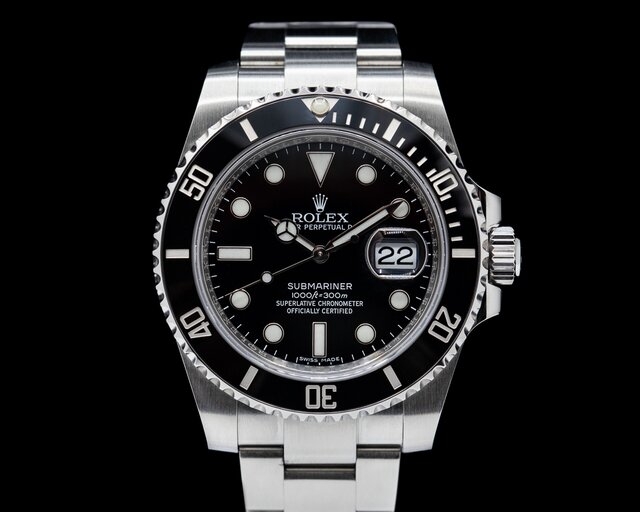
(52705) Rolex 116610 Submariner Oyster Perpetual Date, 116610LN, stainless steel on a stainless steel oysterlock bracelet, automatic movement, date at 3 o'clock, black ceramic bezel with chromalight luminescent hands and markers, centered sweep seconds hand, water resistant to 300 meters, diameter: 40mm, thickness: 12.5mm. Like new with Rolex box and papers dated 2018.
$11,150
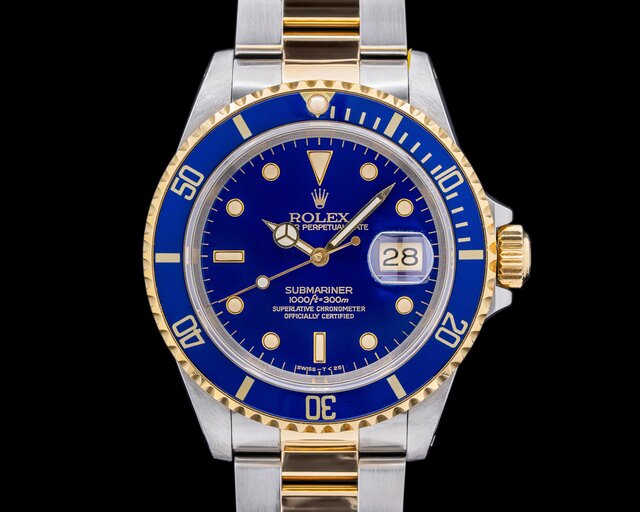
(52567) Rolex 16613 Submariner, stainless steel and 18k yellow gold on a stainless steel and 18k yellow gold oyster bracelet, automatic movement, date at 3 o'clock, blue tritium dial with hour markers that have developed a nice patina, water resistant to 300 meters, N series (1991), diameter: 40mm, thickness: 14mm. Excellent condition.
$11,500

(52721) Rolex 116660 Sea Dweller Deep Sea, stainless steel on a stainless steel Oysterlock bracelet, automatic caliber 3135 movement, luminous applied hour indicators and hands, date at 3 o'clock, centered sweep seconds hand, COSC, uni-directional rotating bezel, screw down crown, helium escape valve, diameter: 43mm, thickness: 17.8mm, water resistant to 3,900 meters/12,800 feet. Like New with Rolex box and papers dated 2010.
$10,750

(52634) Rolex 116660 Sea Dweller Deep Sea, stainless steel on a stainless steel Oysterlock bracelet, automatic caliber 3135 movement, luminous applied hour indicators and hands, date at 3 o'clock, centered sweep seconds hand, COSC, uni-directional rotating bezel, screw down crown, helium escape valve, diameter: 43mm, thickness: 17.8mm, water resistant to 3,900 meters/12,800 feet. Like New with Rolex box.
$9,900

(52706) Rolex 126334 Oyster Perpetual Datejust 41, stainless steel with an 18k white gold fluted bezel on a stainless steel Oyster bracelet, automatic Rolex caliber 3235 movement, date with magnifier at 3 o'clock, centered sweep seconds hand, rhodium dial with Green Roman Numerals COSC, sapphire crystal, scrambled serial, diameter: 41mm, thickness: 11.8mm. Like New with Rolex box and papers dated 2018.
$13,500
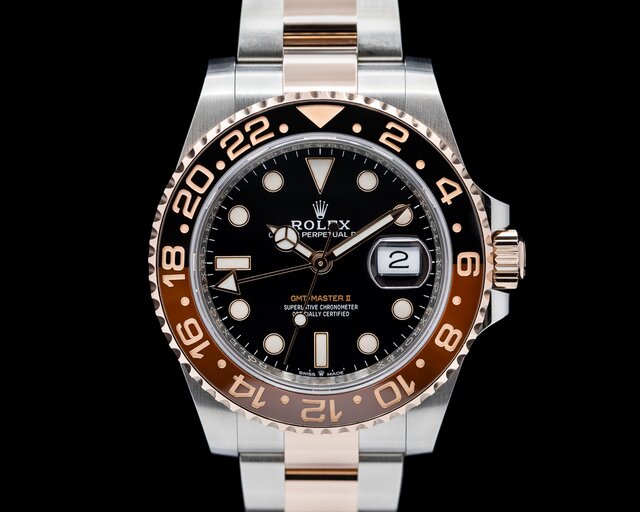
(52902) Rolex 126711 GMT Master II "Root Beer" 126711 CHNR, 126711CHNR, stainless steel and 18k "Everose" rose gold on a stainless steel and 18k rose gold oyster bracelet, new in-house automatic Rolex caliber 3285 movement, black and brown ceramic bezel with rose gold Arabic numerals, date at 3 o'clock, triangular GMT hand, COSC, sapphire crystal, water resistant to 100 meters, diameter: 40mm, thickness: 12mm, scrambled serial. Lik...
$18,950
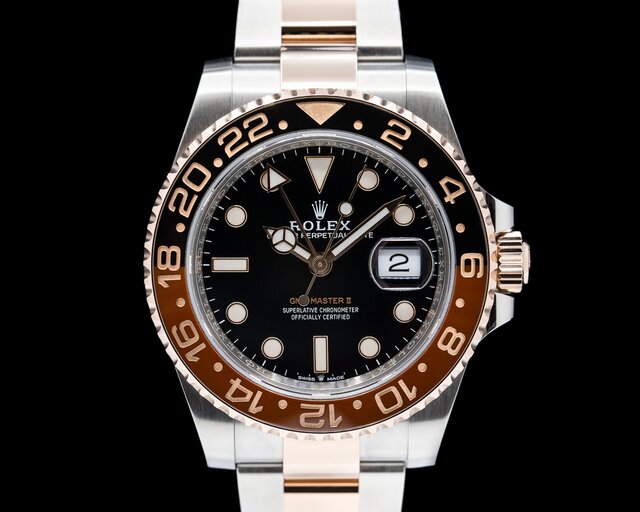
(52553) Rolex 126711 GMT Master II "Root Beer" 126711 CHNR, 126711CHNR, stainless steel and 18k "Everose" rose gold on a stainless steel and 18k rose gold oyster bracelet, new in-house automatic Rolex caliber 3285 movement, black and brown ceramic bezel with rose gold Arabic numerals, date at 3 o'clock, triangular GMT hand, COSC, sapphire crystal, water resistant to 100 meters, diameter: 40mm, thickness: 12mm, scrambled serial. Lik...
$18,900

(52199) Rolex 128236 Oyster Perpetual Day-Date, platinum Case with a fluted bezel on a Platinum Presidential bracelet, perpetual, mechanical self-winding movement, COSC, screw down crown, Ice Blue Dial, Silver Roman Numerals, Date at 3, day at 12, scratch resistant sapphire crystal, scrambled serial, waterproof to 100 meters, Diameter: 36mm, Like new with Rolex box and papers dated 2023.
$57,000
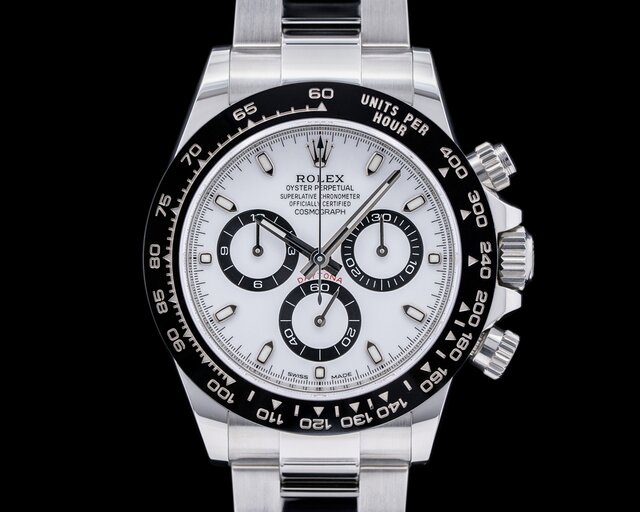
(52952) Rolex Daytona 116500 LN, 116500LN, 904L stainless steel case with a stainless steel oyster bracelet with an oysterlock bracelet with easylink 5mm extension, black monobloc ceramic Cerachrom bezel with engraved tachymeter, automatic Rolex caliber 4130, 72-hour power reserve, white dial with applied luminous markers, sapphire crystal, water resistant to 100 meters, size: 40mm, thickness: 13mm. Like new and still partially sti...
$30,900
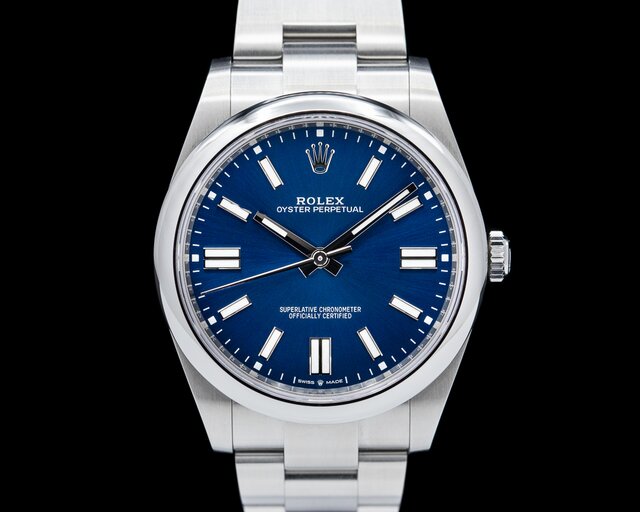
(52896) Rolex 124300 Oyster Perpetual, stainless steel on a stainless steel oyster bracelet, automatic 3230 Rolex movement, 70-hour power reserve, centered sweep seconds hand, blue dial with white stick markers, COSC, diameter: 41mm, thickness: 11.8mm, sapphire crystal, scrambled serial, water resistant to 30m / 100ft. Like New with Rolex box and papers dated 2022.
$8,650
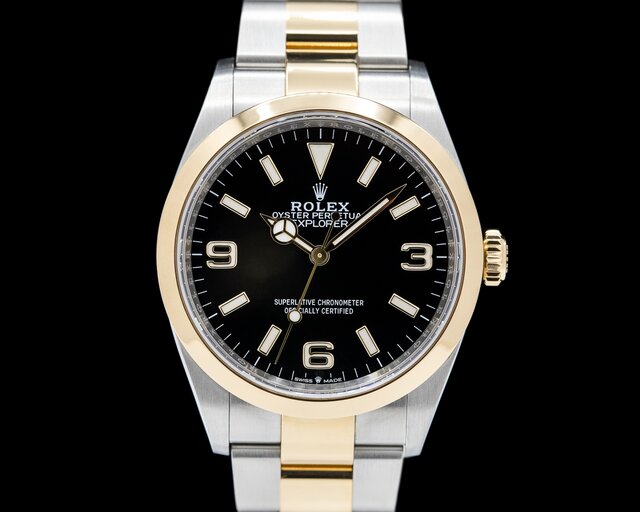
(52622) Rolex 124273-0001 Explorer 36mm, New Model for 2021, stainless steel/18k Yellow Gold on an oyster bracelet, automatic Rolex caliber 3230 movement, black dial with luminous Chromalight hands and hour indicators, centered sweep second hand, COSC, water resistant to 100 meters, sapphire crystal, scrambled serial, diameter: 36mm. Like New with Rolex box and papers dated 2022.
$10,500
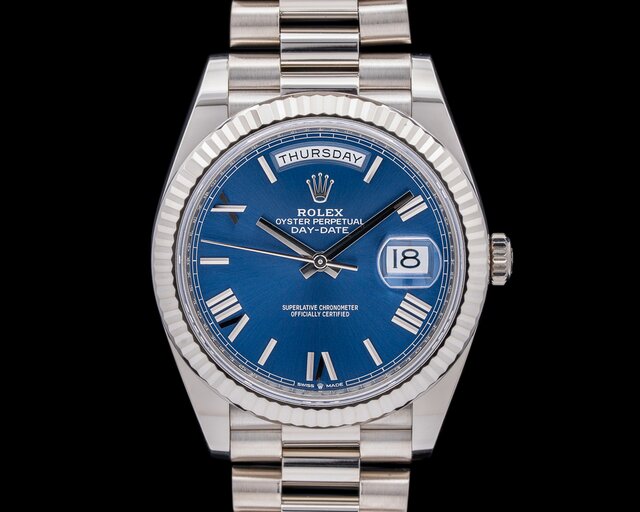
(52273) Rolex 228239 Day-Date President 40mm, 18k white gold on an 18k white gold Presidential bracelet, fluted bezel, automatic Rolex caliber 3255 movement, COSC, screw down crown, blue dial with Roman numerals, date at 3 o'clock, day at 12 o'clock, scrambled serial number, size: 40mm, thickness 18mm, sapphire crystal, water resistant to 100 meters. Like new with original Rolex box and papers dated 2022.
$42,400
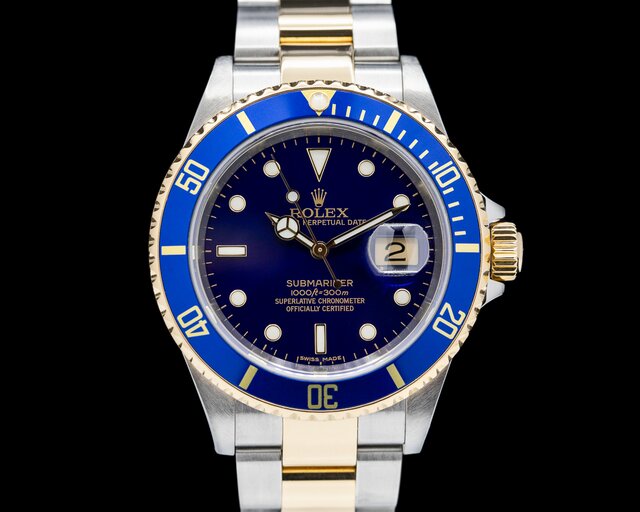
(51946) Rolex 16613 Submariner, stainless steel and 18k yellow gold on a stainless steel and 18k yellow gold oyster bracelet, automatic movement, date at 3 o'clock, blue dial, water resistant to 300 meters, Z series (2007), diameter: 40mm, thickness: 14mm. Excellent condition with Rolex box and papers dated 2007.
$11,900
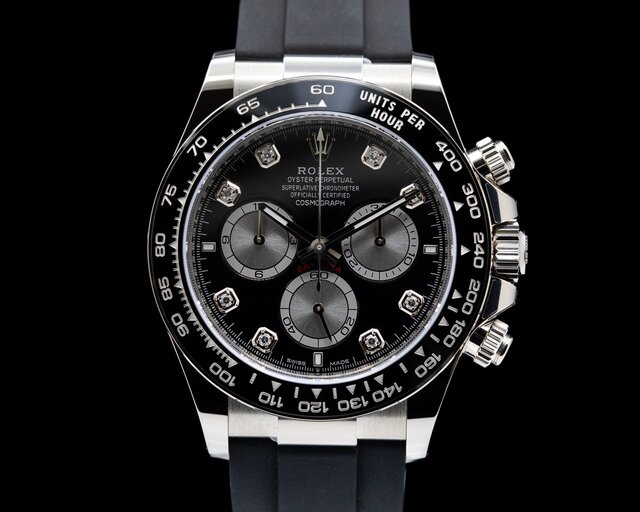
(51670) Rolex 126519 LN Cosmograph Daytona, 126519LN, new model for 2023, 18k white gold on a Rolex black Oysterflex rubber strap with an 18k white gold deployant buckle, black ceramic bezel, automatic Rolex caliber 4131 movement, black dial with silver subdials, 8 diamond hour markers, chronograph, small seconds at 6, luminous hands, cosc, screw-down crown and chronograph pushers, diameter: 40 mm, thickness: 12mm, sapphire crystal...
$40,700
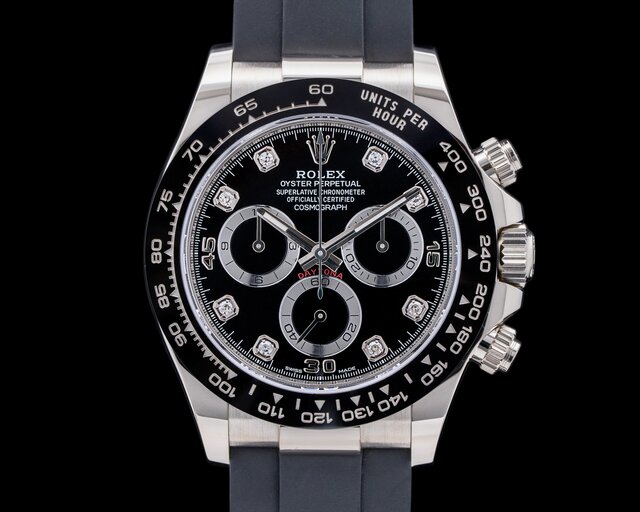
(51711) Rolex 116519 LN Cosmograph Daytona, 18k white gold on a Rolex black Oysterflex rubber strap with an 18k white gold deployant buckle, black ceramic bezel, automatic Rolex caliber 4130 movement, black dial with silver subdials and diamond indexes, chronograph, small seconds at 6, luminous hands, cosc, screw-down crown and chronograph pushers, diameter: 40 mm, thickness: 12mm, sapphire crystal, water resistant. Like new with b...
$37,800
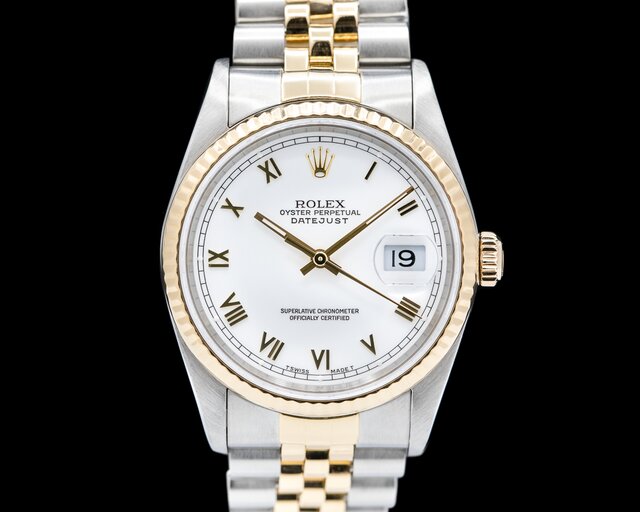
(52617) Rolex 16233 Oyster Perpetual Datejust, stainless steel and yellow gold on a stainless steel and yellow gold Jubilee bracelet, white dial with gold Roman numerals, automatic movement, date at 3 o'clock, centered sweep seconds hand, COSC, sapphire crystal, E Series (1990), diameter: 36mm, thickness: 12mm. Excellent Condition with Rolex box and service card dated 2016.
$5,900

(52951) Rolex Daytona 116500LN, 116500 LN, 904L stainless steel case with a stainless steel Oysterlock bracelet with Easylink 5mm extension, black monobloc ceramic Cerachrom bezel with engraved tachymeter, automatic Rolex caliber 4130, 72-hour power reserve, black dial with applied luminous markers, sapphire crystal, water resistant to 100 meters, size: 40mm, thickness: 13mm. Like new with Rolex box and papers from 2019.
$26,900
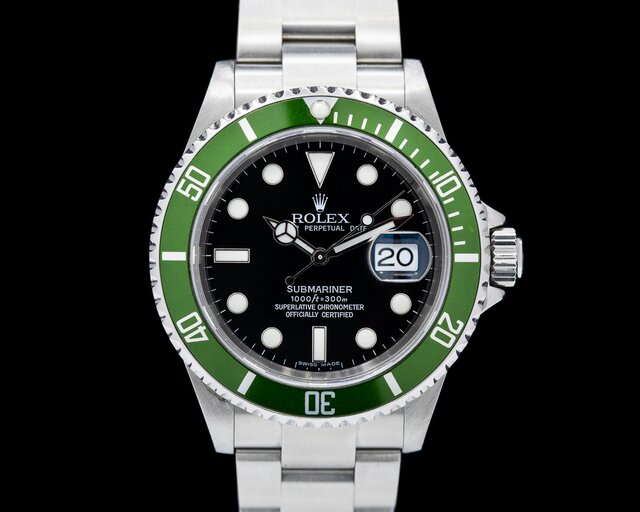
(52607) Rolex 16610LV Submariner 50th Anniversary "Kermit" Edition Oyster Perpetual, stainless steel on a stainless steel oyster bracelet, automatic Rolex caliber 3135 movement, green time lapse bezel, date window with magnifying bubble at 3 o'clock, centered sweep seconds hand, COSC, size: 40mm, thickness: 12.8mm, sapphire crystal, rotating bezel, screw-down crown, Z series (2006/7), water resistant to 1000ft. Exceptional origin...
$16,250
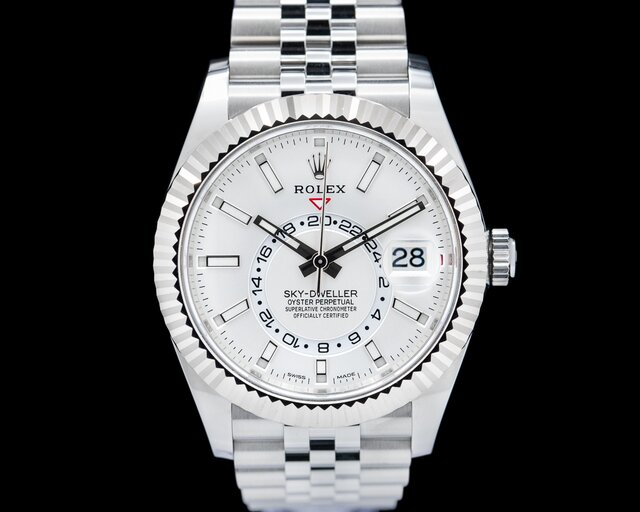
(52817) Rolex 326934 Sky-Dweller, stainless steel on a stainless steel jubilee bracelet, automatic Rolex caliber 9001, COSC, 18k white gold rotatable command bezel, GMT located in center of dial, 72-hour power reserve, white dial with applied luminous hour markers, date at 3 o'clock, red indicator on outer minute track indicates the month, size: 42mm, thickness: 14.5mm, water resistant to 100M, sapphire crystal. Like New with Rolex...
$19,900
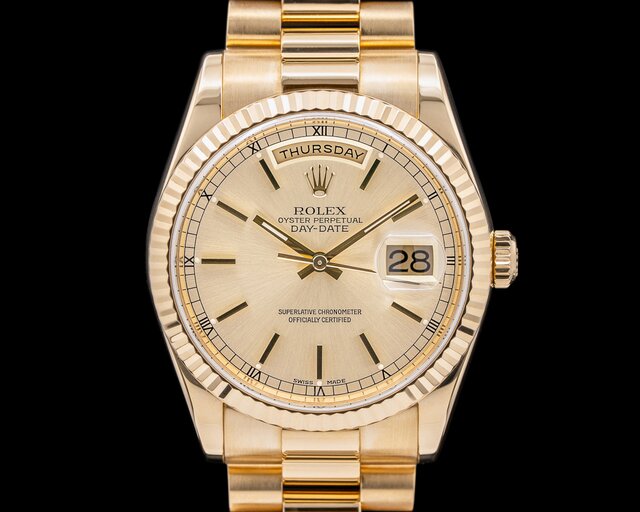
(52838) Rolex 118238 oyster perpetual Day Date President, 18k yellow gold on a 18k yellow gold Presidential bracelet the case and bracelet are in outstanding original condition, automatic, COSC, screw down Triplock crown, champagne dial with applied gold stick markers, date at 3 o'clock, day at 12 o'clock, sapphire crystal, water resistant to 100 meters, D serial number (2005/6), size: 36mm, thickness 12.4mm. Like New with Rolex Bo...
$24,900
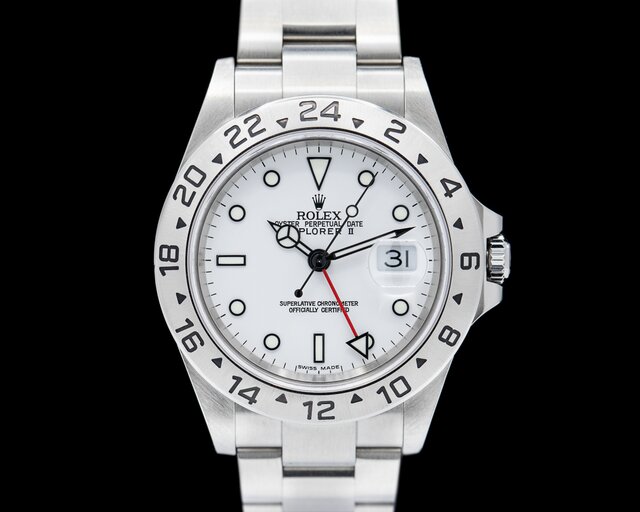
(52447) Rolex 16570 Explorer II, stainless steel on a stainless steel Oyster bracelet, automatic Rolex caliber 3185 movement, white dial with luminous hands and hour markers, centered sweep seconds hand, date, two time zones, COSC, water resistant to 100 meters, sapphire crystal, D Series (2005), diameter: 40mm, thickness: 12mm. Like New with Rolex box and booklet. This watch was just completely serviced.
$7,750
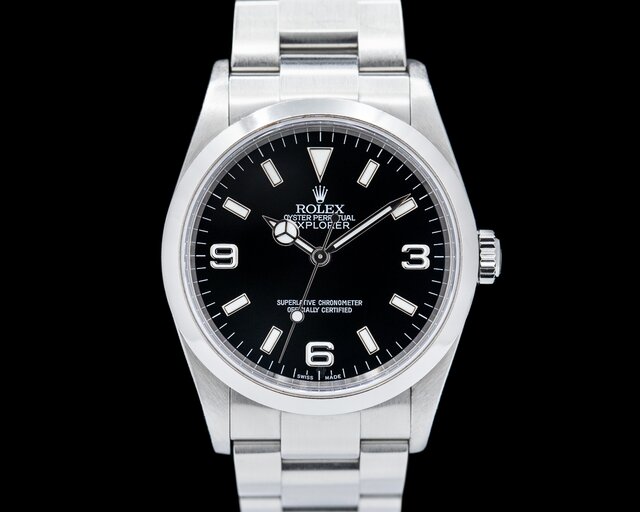
(52954) Rolex 14270 Explorer I, stainless steel on a stainless steel Oyster bracelet, automatic, luminous tritium hands and hour indicators have started to develop a beautiful warm patina, centered sweep seconds hand, COSC, water resistant to 100 meters, sapphire crystal, F series (2005), diameter: 36mm, thickness: 12mm. Like New with original Rolex box, booklets, hang-tag, original sales receipt, service papers from 2013 and 2018,...
$7,250
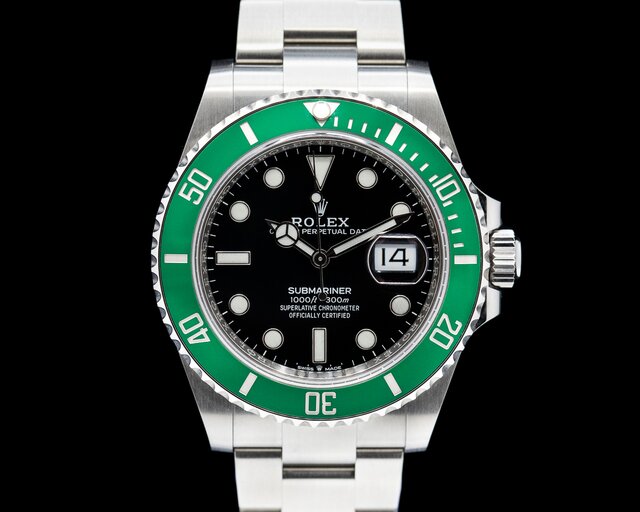
(52916) Rolex 126610LV Submariner Date Green, 41mm stainless steel case features more tapered lugs and crown-guards on an updated 21mm stainless steel Oyster bracelet with the "glidelock" clasp, New automatic Rolex caliber 3235 movement, 70-hour power reserve, green ceramic unidirectional rotating bezel, black glossy dial with Chromalight luminescent hands and markers, date with magnifying lens at 3 0'clock, centered sweep seconds ...
$14,900
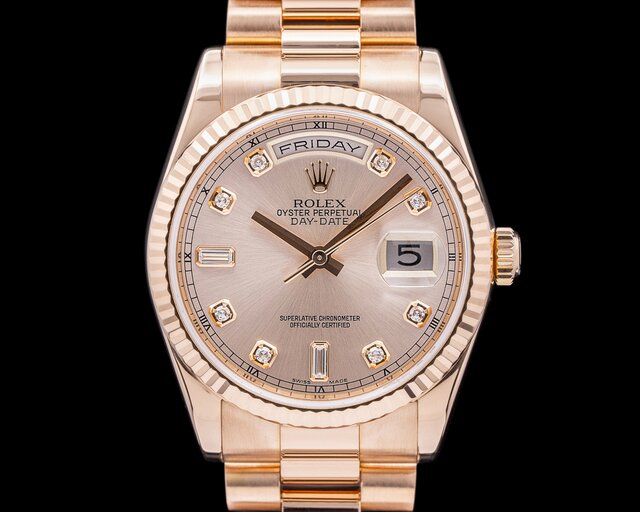
(52720) Rolex 118235 oyster perpetual Day Date President, 18k rose gold on a 18k rose gold Presidential bracelet, automatic Rolex caliber movement, COSC, screw down Triplock crown, metallic pink dial with baguette and solitaire diamonds, sunburst finish, date at 3 o'clock, day at 12 o'clock, sapphire crystal, water resistant to 100 meters, D serial number (2005/2006) size: 36mm, thickness 12.4mm. Excellent condition with Rolex Box ...
$35,900
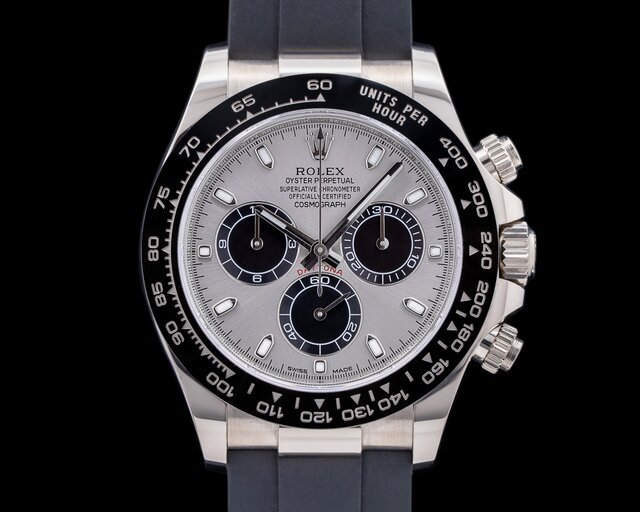
(52526) Rolex 116519 LN Cosmograph Daytona, 116519LN, 18k white gold on a Rolex black Oysterflex rubber strap with an 18k white gold deployant buckle, black ceramic bezel, automatic Rolex caliber 4130 movement, silver dial with black subdials, luminous hour markers, chronograph, small seconds at 6, luminous hands, cosc, screw-down crown and chronograph pushers, diameter: 40 mm, thickness: 12mm, sapphire crystal, water resistant. Li...
$36,500
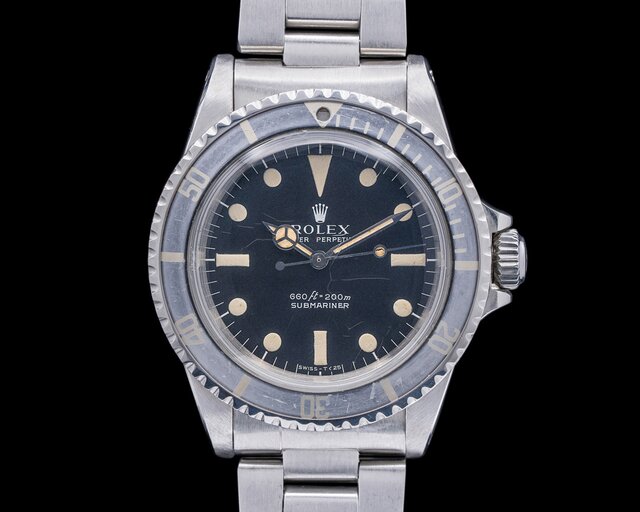
(50346) Rolex Submariner 5513 Maxi I Matte Dial, stainless steel on a stainless steel 93150 Oyster bracelet with 580 endlinks, the case is in excellent condition, automatic Rolex caliber 1520, centered sweep second hand, bi-directional rotating bezel, screw-down crown, original Maxi I matte dial with creamy tritium patina, water resistant to 660ft, 564XXXX serial (1978), diameter: 40mm, thickness: 14.5mm, Excellent Condition.
$12,900

(52932) Rolex 228398TRU Day-Date President 40mm, 228398 TRU, 18k yellow gold on an 18k yellow gold Presidential bracelet, automatic Rolex caliber 3255 movement, COSC, screw down crown, full diamond pave dial with ruby Roman numeral indices, ruby bezel, day at 12 o'clock, scrambled serial number, size: 40mm, thickness 18mm, sapphire crystal, water resistant to 100 meters. Like New with Rolex box and papers dated 2019.
$259,900
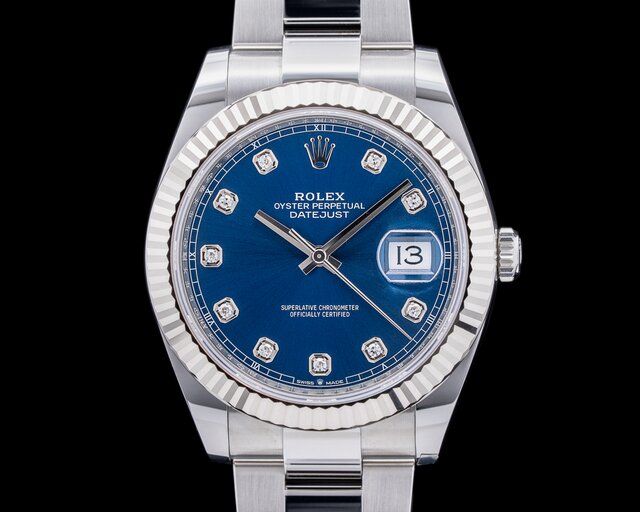
(52820) Rolex 126334 Oyster Perpetual Datejust 41, stainless steel with an 18k white gold fluted bezel on a stainless steel Jubilee bracelet, automatic Rolex caliber 3235 movement, date with magnifier at 3 o'clock, centered sweep seconds hand, blue dial with 10 diamond hour markers, COSC, sapphire crystal, scrambled serial, diameter: 41mm, thickness: 11.8mm. Like new with Rolex box and papers dated 2022.
$15,900
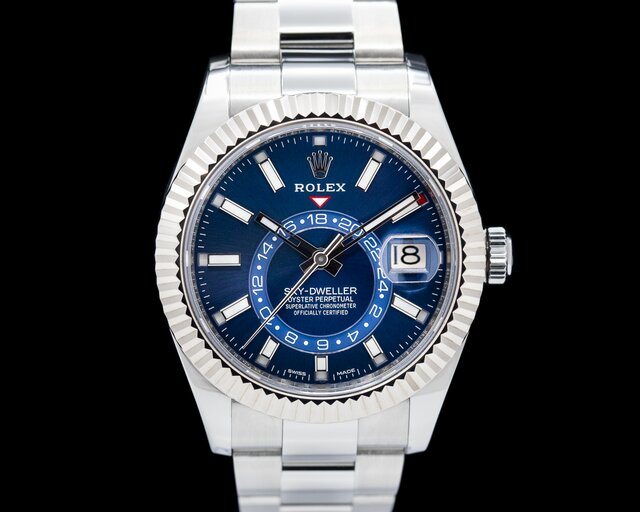
(52722) Rolex 326934 Sky-Dweller, stainless steel on a stainless steel oyster bracelet, automatic Rolex caliber 9001, COSC, 18k white gold rotatable command bezel, GMT located in center of dial, 72-hour power reserve, blue dial with applied luminous hour markers, date at 3 o'clock, red indicator on outer minute track indicates the month, size: 42mm, thickness: 14.5mm, water resistant to 100M, sapphire crystal. Like New with Rolex b...
$20,900
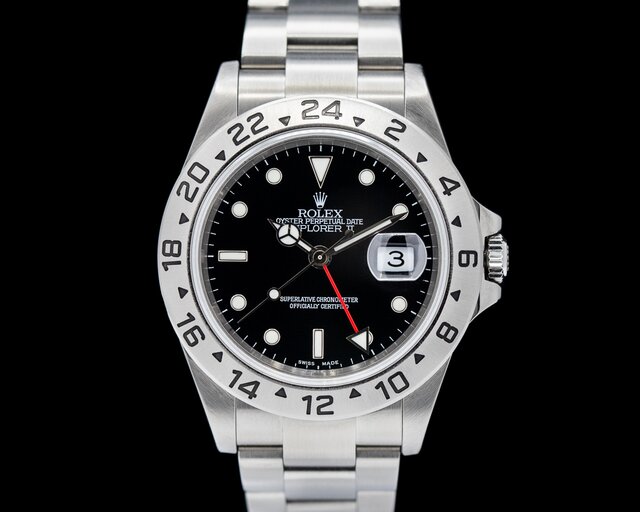
(51245) Rolex 16570 Explorer II, stainless steel on a stainless steel 78790A Oyster bracelet, automatic Rolex caliber 3185 movement, black superluminova dial with luminous hands and hour markers, centered sweep seconds hand, date, two time zones, COSC, water resistant to 100 meters, sapphire crystal, D Series (2005), diameter: 40mm, thickness: 12mm. Like New with Rolex box and papers.
$8,250
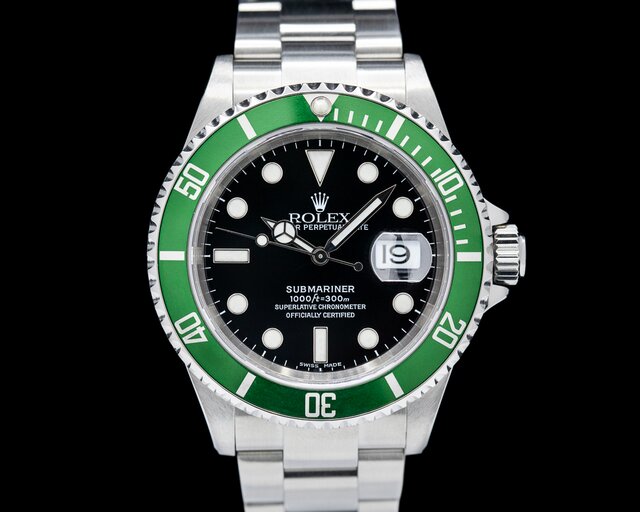
(52574) Rolex 16610LV Submariner 50th Anniversary Edition Oyster Perpetual, stainless steel on a stainless steel Oyster bracelet, automatic Rolex caliber 3135 movement, unidirectional green time lapse bezel, date window with magnifying bubble at 3 o'clock, centered sweep seconds hand, COSC, size: 40mm, thickness: 12.8mm, sapphire crystal, D serial (2005/6) screw-down crown, water resistant to 1000ft. Like New with Rolex box, bookle...
$15,250
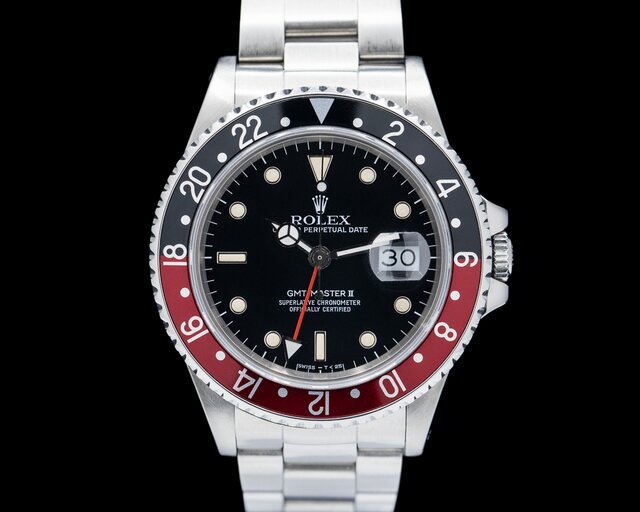
(52386) Rolex 16760 GMT Master II "FAT LADY" Transitional, stainless steel on a stainless steel 93150 bracelet, automatic Rolex caliber 3085 movement, matte black dial with applied luminous hour markers, dial and hands have the original tritium lume, quick set date, second timezone, red and black bezel insert is in excellent condition, COSC, sapphire crystal, water resistant to 100 meters, original dial with matching patina, 9.6 Mi...
$13,250
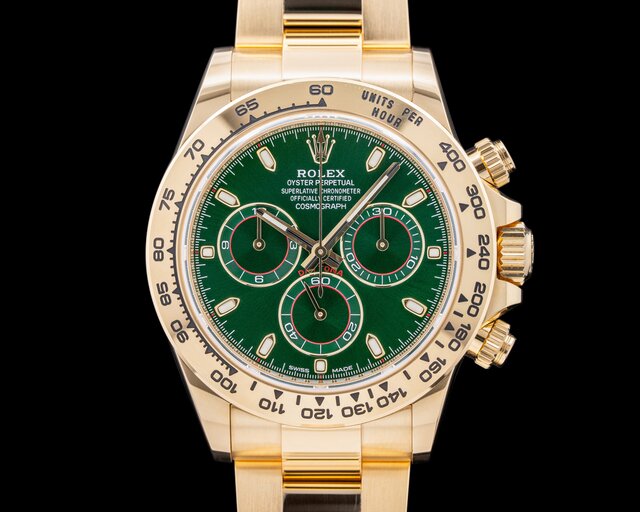
(52780) Rolex 116508 Cosmograph Daytona, 18k yellow gold on an 18k yellow gold Oyster bracelet, automatic Rolex caliber 4130 movement, 12-hour chronograph, green dial with applied luminous hour markers, yellow gold luminous hands, sapphire crystal, water resistant to 100 meters, scrambled serial, diameter: 40mm, thickness: 12mm. Like new with Rolex box and papers dated 2022.
$73,900

(52876) Rolex 116659 SABR Submariner 116659SABR, 18k white gold diamond set case on a matching 18k white gold oyster bracelet with glide lock clasp, automatic Rolex caliber 3135 movement, date at 3 o'clock, sunburst blue dial with white gold bezel set with sapphires and diamond baguettes, water-resistant, diameter: 40mm, thickness: 13mm, scrambled serial number. UNWORN and partially stickered with Rolex box and papers dated 2019.
$152,500
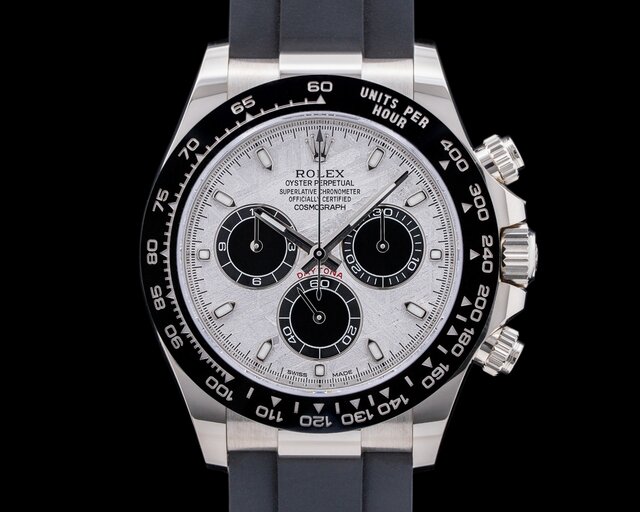
(52859) Rolex 116519 LN Cosmograph Daytona, 116519LN, 18k white gold with meteorite dial, on a Rolex black Oysterflex rubber strap with an 18k white gold deployant buckle, black ceramic bezel, automatic Rolex caliber 4130 movement, meteroite dial with black subdials, luminous hour markers, chronograph, small seconds at 6, luminous hands, COSC, screw-down crown and chronograph pushers, diameter: 40 mm, thickness: 12mm, sapphire crys...
$92,500
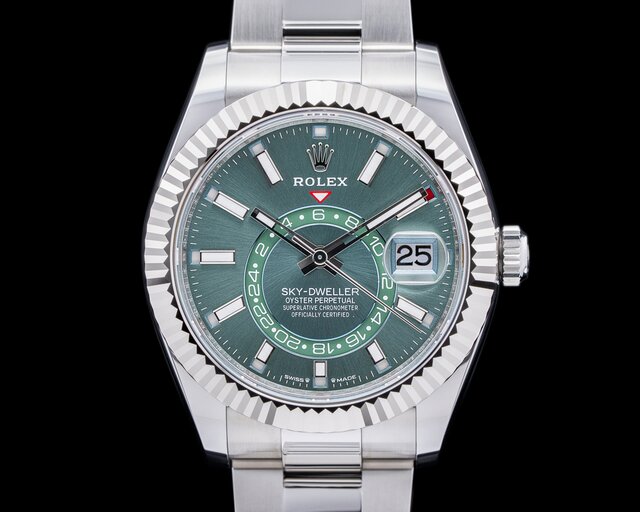
(52946) UNWORN Rolex 336934 Sky Dweller, 336934-0002 stainless steel and white gold case on a stainless steel oyster bracelet, automatic Rolex caliber 9002, COSC, 18k white gold rotatable command bezel, GMT located in center of dial, ~72-hour power reserve, mint green dial with applied luminous hour markers, date at 3 o'clock, red indicator on outer minute track indicates the month, size: 42mm, thickness: 14.5mm, water resistant to...
$28,900
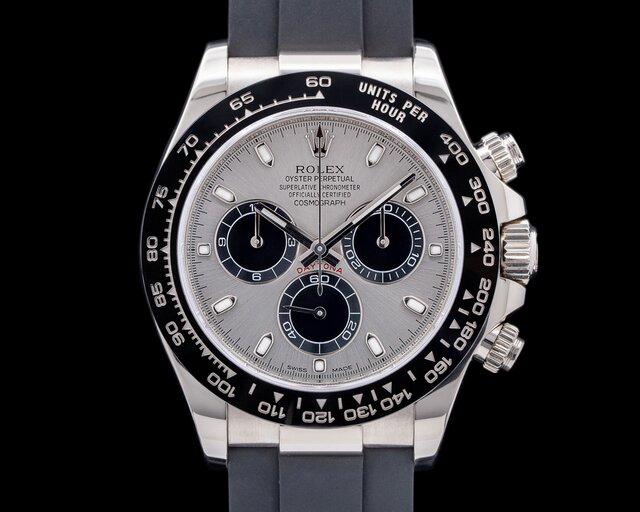
(52886) Rolex 116519 LN Cosmograph Daytona, 116519LN, 18k white gold on a Rolex black Oysterflex rubber strap with an 18k white gold deployant buckle, black ceramic bezel, automatic Rolex caliber 4130 movement, silver dial with black subdials, luminous hour markers, chronograph, small seconds at 6, luminous hands, cosc, screw-down crown and chronograph pushers, diameter: 40 mm, thickness: 12mm, sapphire crystal, water resistant. Li...
$39,500
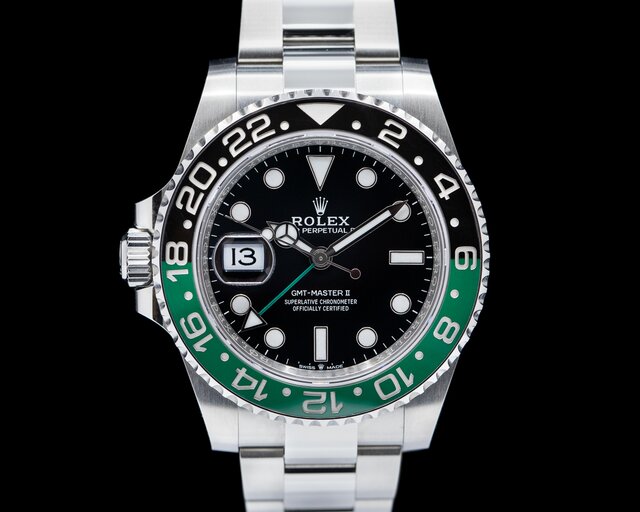
(52851) Rolex 126720VTNR Left-Handed GMT Master II "Sprite" 126720 VTNR, stainless steel on a stainless steel Oyster bracelet, new in-house automatic Rolex caliber 3285 movement, black and green ceramic bezel with silver Arabic numerals, date and crown at 9 o'clock, triangular GMT hand in green, COSC, sapphire crystal, water resistant to 100 meters, diameter: 40mm, thickness: 12mm, scrambled serial number. Like New with Rolex box a...
$17,900
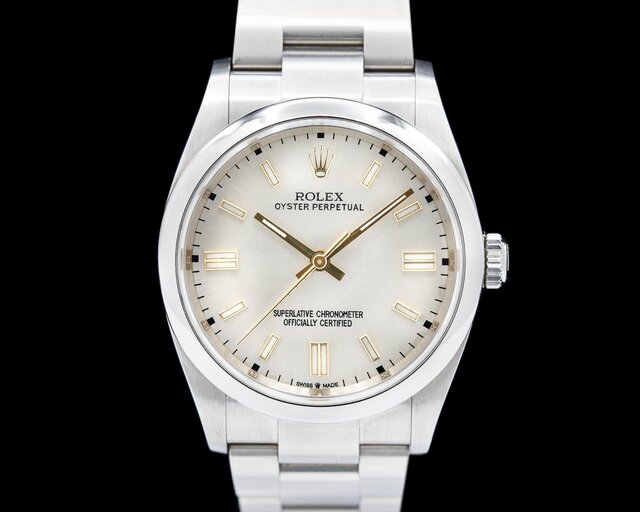
(46422) Rolex 126000 Oyster Perpetual 36mm, stainless steel case on a stainless steel oyster bracelet, automatic Rolex caliber 3230 movement, 70-hour power reserve, centered sweep seconds hand, silver dial with luminous baton hour markers, luminous hands, COSC, sapphire crystal, diameter: 36mm, thickness: 11.8mm. Like New with Rolex box and papers from 2021.
$7,750
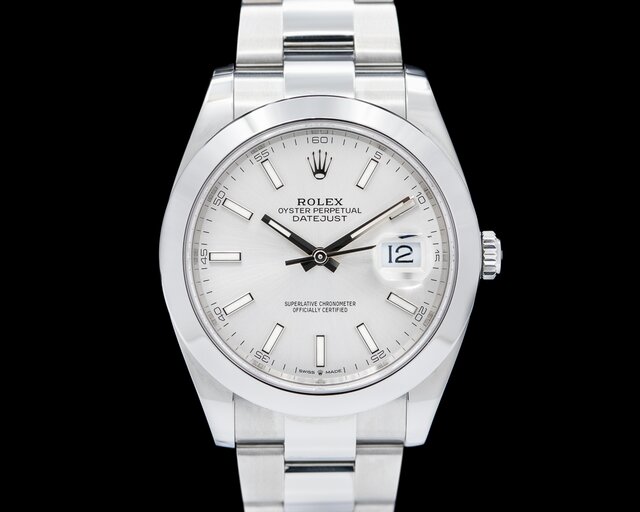
(52594) Rolex 126300 Oyster Perpetual Datejust 41, stainless steel on a stainless steel Oyster bracelet, automatic Rolex caliber 3235 movement, silver dial with applied luminous hour markers, date with magnifier at 3 o'clock, centered sweep seconds hand, COSC, sapphire crystal, scrambled serial, diameter: 41mm, thickness: 11.8mm. Like New with Rolex box and papers dated March 2023.
$9,150
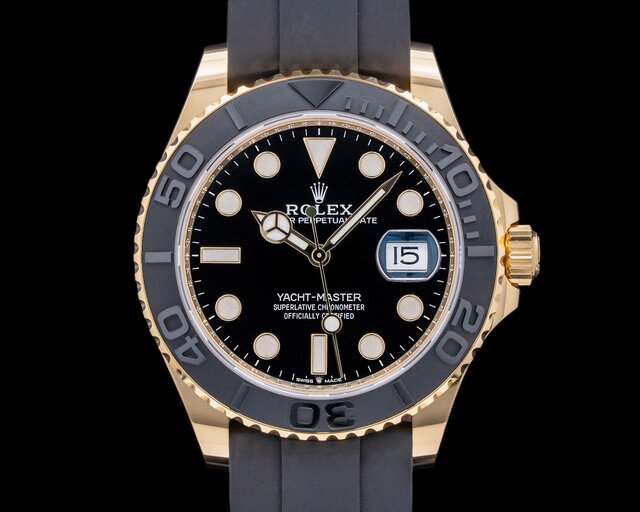
(52582) Rolex 226658 Yacht Master Oyster Perpetual Date, 18K yellow gold on a black rubber strap with 18K yellow gold clasp, automatic, date, sweep second hand, rotatable bezel, COSC, luminescent hands and hour indicators, screw-down crown, sapphire crystal, water resistant, size: 42mm, thickness: 11.2mm, scrambled series. Like new with Rolex box and papers from 2022.
$31,500
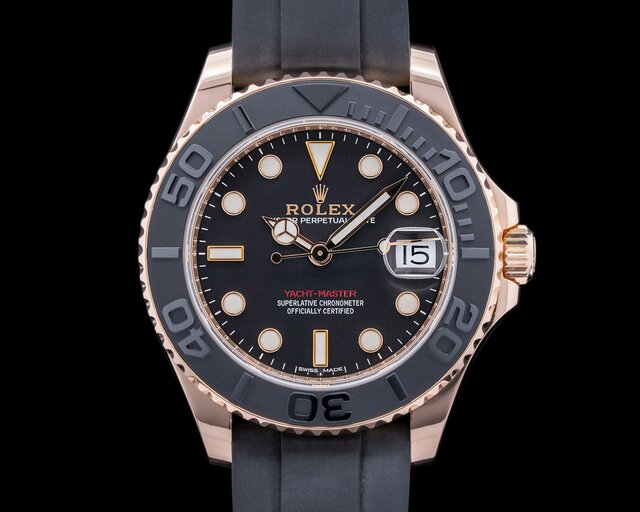
(52713) Rolex 268655 Yacht Master Midsize Oyster Perpetual Date, 18K rose gold on a black Oysterflex rubber strap with 18K rose gold deployant buckle, automatic Rolex caliber 2236, date, sweep second hand, rotatable bezel, COSC, luminescent hands and hour indicators, screw-down crown, sapphire crystal, water resistant, size: 37mm, thickness: 10.5mm, scrambled series. Like New with Rolex box and papers from 2016.
$23,500
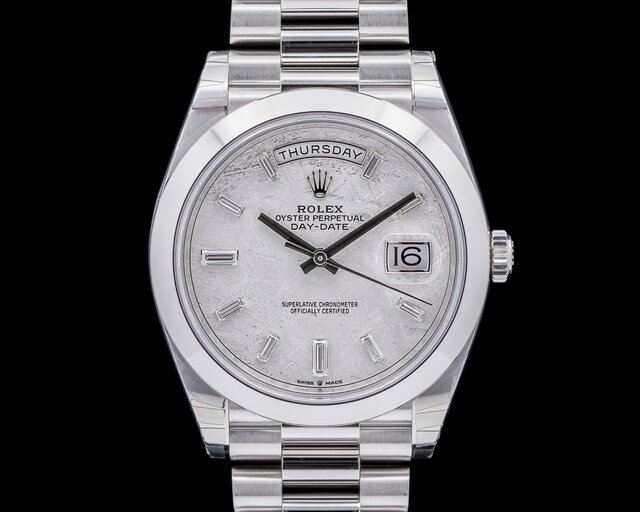
(52810) Rolex 228206 Day Date Platinum 40mm Diamond Meteorite Dial, platinum case with a platinum President bracelet, automatic Rolex caliber 3255 movement, quickset day and date function, 70-hour power reserve, COSC, meteorite dial with baguette diamond hour markers, sapphire crystal, screw-down crown, size 40mm. Like New and partially stickered with original box and papers dated May of 2019.
$84,500
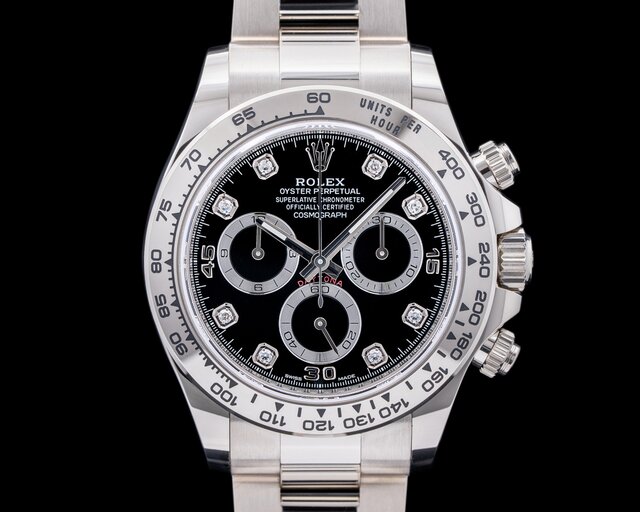
(51206) Rolex 116509 Cosmograph Daytona, 18K white gold on an 18k white gold Oyster bracelet, automatic Rolex caliber 4130 movement, black dial with 8 applied diamond hour markers, 3 white gold rimmed subdials, 12-hour chronograph, sapphire crystal, water resistant to 100 meters, diameter: 40mm, thickness: 12mm. Like New with Rolex box and papers dated 2020.
$37,900

(52408) Rolex 16520 Cosmograph Zenith Daytona, stainless steel on a very sharp stainless steel 78390A SEL Oyster bracelet with, automatic Rolex Caliber 4030 movement, chronograph, black Service dial with applied luminous hour markers, sapphire crystal, water resistant to 100 meters, diameter: 40mm, thickness: 12mm, U serial c. 1997, Like New with with original box, booklets, & Punched Papers, dated 1999.
$27,500
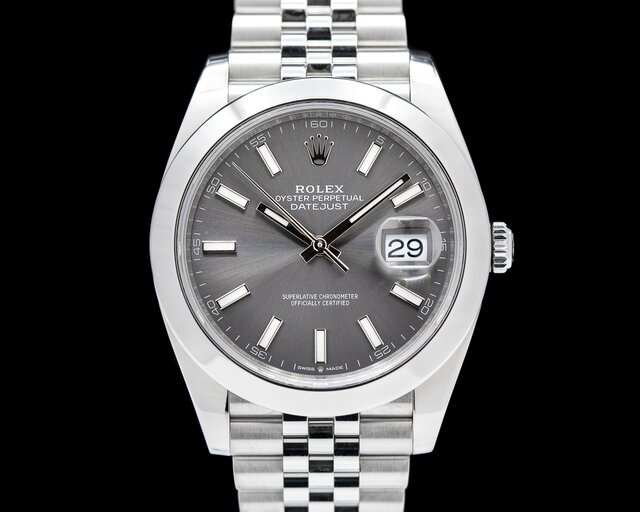
(52298) Rolex 126300 Oyster Perpetual Datejust 41, stainless steel on a stainless steel Oyster bracelet, automatic Rolex caliber 3235 movement, rhodium dial with applied luminous hour markers, date with magnifier at 3 o'clock, centered sweep seconds hand, COSC, sapphire crystal, scrambled serial, diameter: 41mm, thickness: 11.8mm. Like New with Rolex box, tags and papers dated 2022.
$9,400
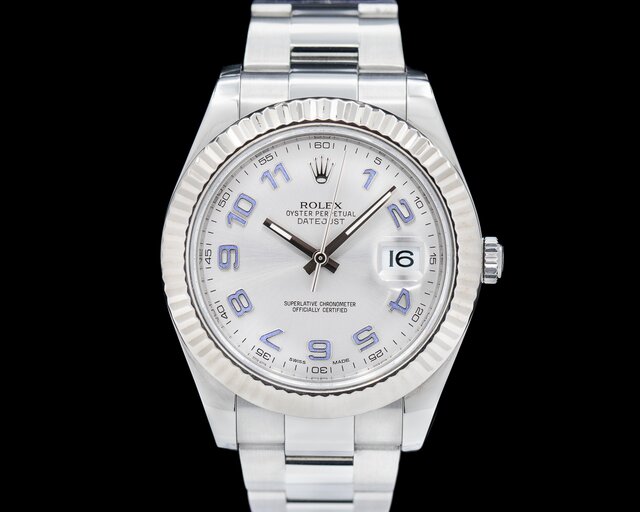
(52226) Rolex 116334 Oyster Perpetual Datejust II, stainless steel on a stainless steel oyster bracelet with 18k white gold fluted bezel, automatic movement, date, centered sweep seconds hand, silver dial with blue Arabic numerals, COSC, sapphire crystal, scrambled serial, diameter: 41mm, thickness: 11.8mm. Like New with box and papers dated 2011.
$10,200
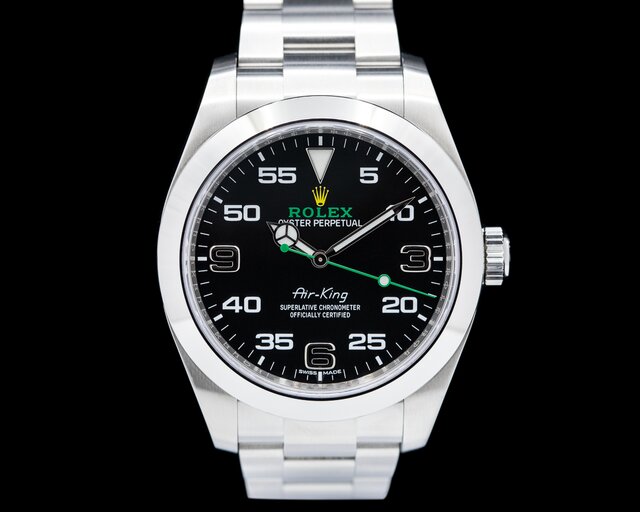
(52684) Rolex 116900 Air King, 904L stainless steel on a stainless steel bracelet, automatic Rolex calibre 3131, 48-hour power reserve, black dial with applied and painted Arabic numerals, luminous hands, green center sweep seconds hand, sapphire crystal, diameter: 40mm, thickness; 12mm. Like new with Rolex box and papers dated March of 2021.
$7,450
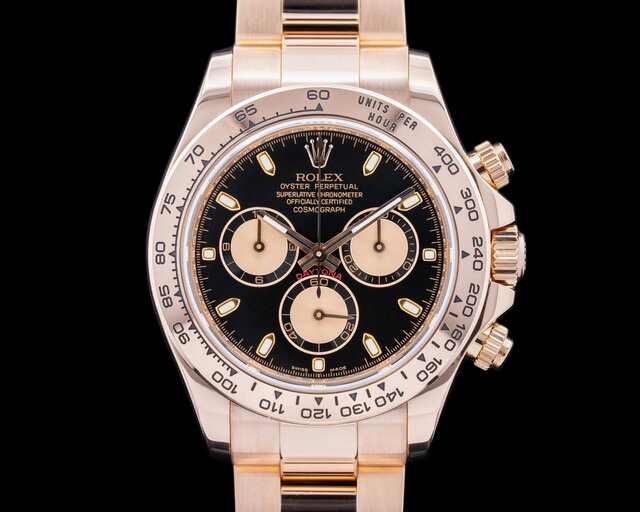
(51876) Rolex 116505 Cosmograph Daytona, 18k rose gold on an 18k rose gold Oyster bracelet, automatic movement, chronograph, black dial with rose color sub-dials, sapphire crystal, water resistant to 100 meters, scrambled serial, diameter: 40mm, thickness: 12mm. Like new with box and booklets and papers dated .
$42,800

(52796) Rolex 116503 Cosmograph Daytona, stainless steel and 18k yellow gold on a stainless steel and 18k yellow gold oyster bracelet, automatic movement, chronograph, black dial with factory diamonds, luminescent hands, arabic numerals at 3, 6, and 9 o'clock, scrambled serial, diameter: 40mm, thickness: 12mm, sapphire crystal, water resistant to 100 meters. Like New with Rolex box and papers dated 2018.
$26,900
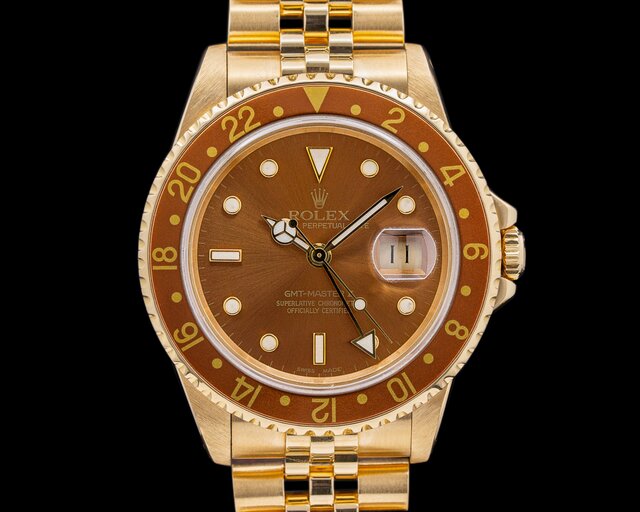
(52536) Rolex 16758 GMT Master, 16758, 18K yellow gold on an 18k yellow gold Jubilee bracelet, the case is in excellent original condition, brown sunburst service dial luminescent hour markers, Service Mercedes handset, water resistant to 100 meters, date at 3 o'clock, second time zone by way of a bi-directional bezel, 7.44M serial (circa 1983), diameter: 40mm, thickness: 12mm. Excellent Condition with box and booklets.
$33,200
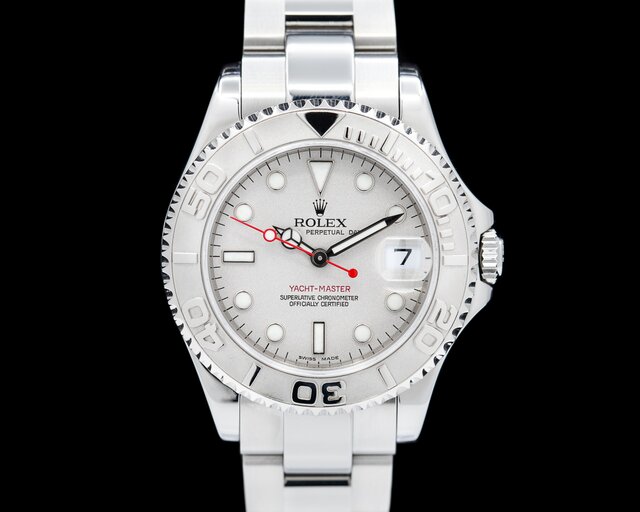
(52639) Rolex 168622 Yacht Master Mid Size, stainless steel on a stainless steel oyster bracelet, automatic movement, date, sweep second hand, platinum rotatable bezel, COSC, luminescent hands and hour indicators, platinum dial, screw-down crown, sapphire crystal, water resistant, size: 35mm, thickness: 11.2mm. Like New with box and papers dated 2006.
$8,250
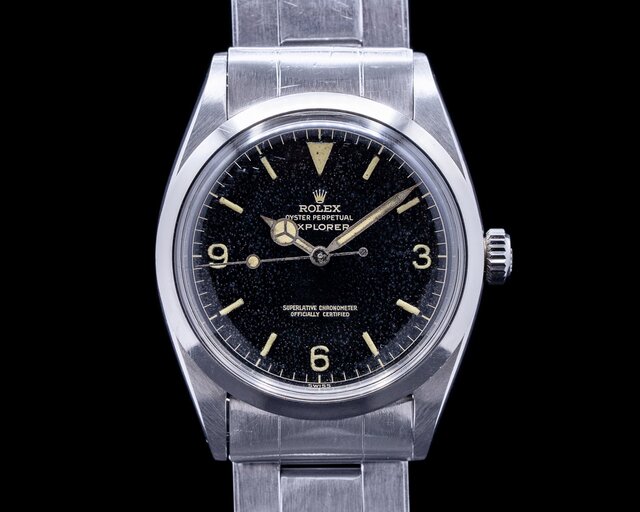
(43822) Rolex 1016 Explorer I Gilt Mark 1 Chapter Dial,stainless steel case with 7206 rivet bracelet (4/70) and # 80 end-links, rivet bracelet is in outstanding condition for its age, original gilt Chapter mark 1 dial has developed a charming patina and has nicely matching hands and hour markers, Twinlock crown, domed acrylic crystal, 517XXXX (circa 1960), Excellent Condition.
$21,400
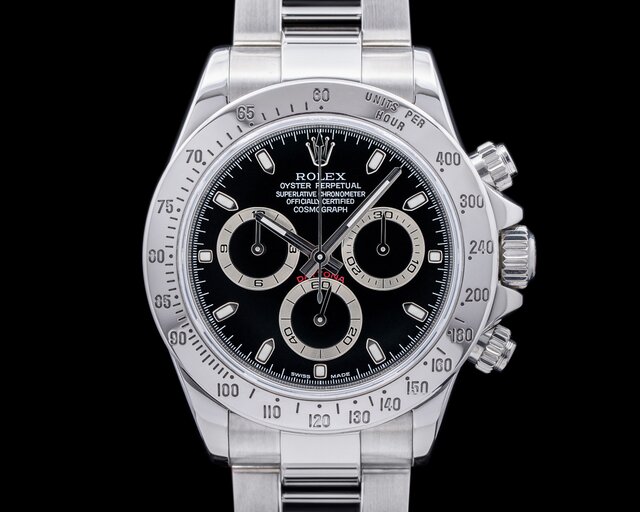
(51901) Rolex 116520 Cosmograph Daytona, stainless steel on a stainless steel Oyster bracelet, automatic Rolex Caliber 4130 movement, chronograph, black dial with applied luminous hour markers, sapphire crystal, water resistant to 100 meters, diameter: 40mm, thickness: 12mm. Like new with Rolex box and papers dated 2004. This watch was just serviced by Rolex in 2023.
$25,900
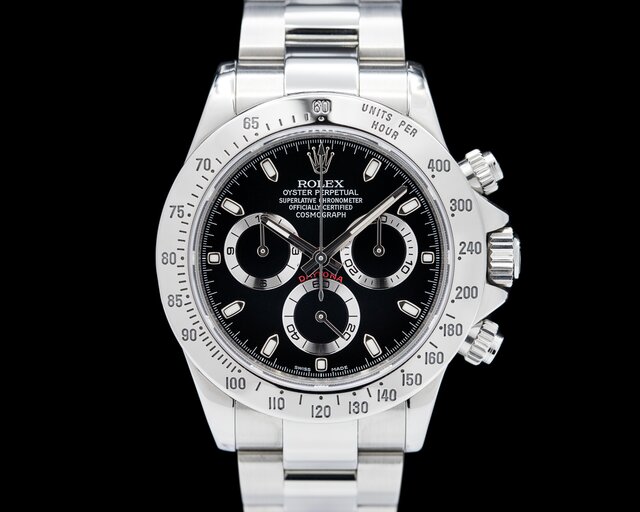
(52496) Rolex 116520 Cosmograph Daytona, stainless steel on a stainless steel Oyster bracelet, automatic Rolex Caliber 4130 movement, chronograph, black dial with applied luminous hour markers, sapphire crystal, Z-series (2008/2009), water resistant to 100 meters, diameter: 40mm, thickness: 12mm. Like New with the original Rolex box and 2020 Rolex service papers.
$23,900
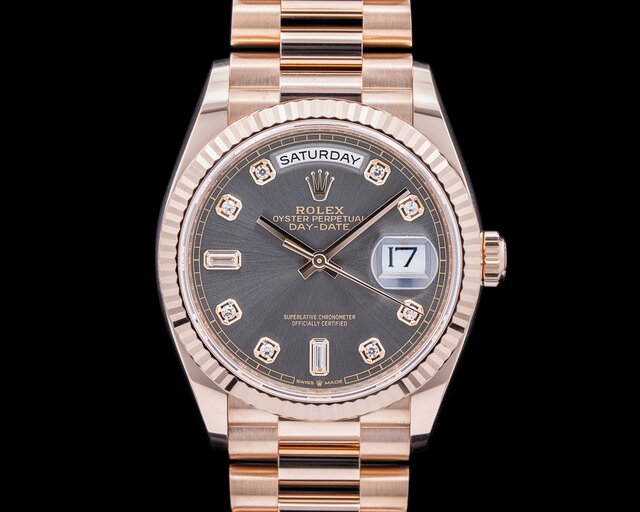
(52201) Rolex 128235 President Oyster Perpetual Day-Date, 128235, 18k rose gold case with fluted bezel on a 18K rose gold Presidential bracelet, automatic movement, COSC, screw down crown, Mother of Pearl dial with square and baguette diamond hour markers (very rare), date at 3 o'clock, day at 12, diameter: 36mm, sapphire crystal, water resistant 100 meters. Like New with original box and papers dated 2024.
$40,600
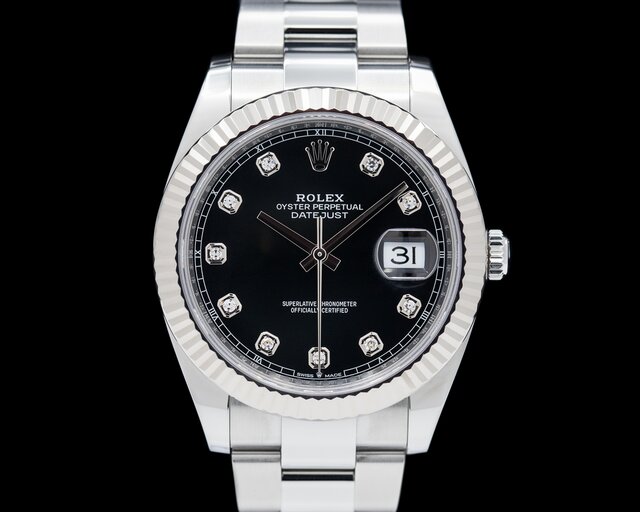
(52004) Rolex 126334 Oyster Perpetual Datejust 41, stainless steel with an 18k white gold fluted bezel on a stainless steel oyster bracelet, automatic Rolex caliber 3235 movement, date with magnifier at 3 o'clock, centered sweep seconds hand, glossy black dial with 10 diamond hour markers, COSC, sapphire crystal, scrambled serial, diameter: 41mm, thickness: 11.8mm. Like New with Rolex box and papers dated 2023.
$11,400
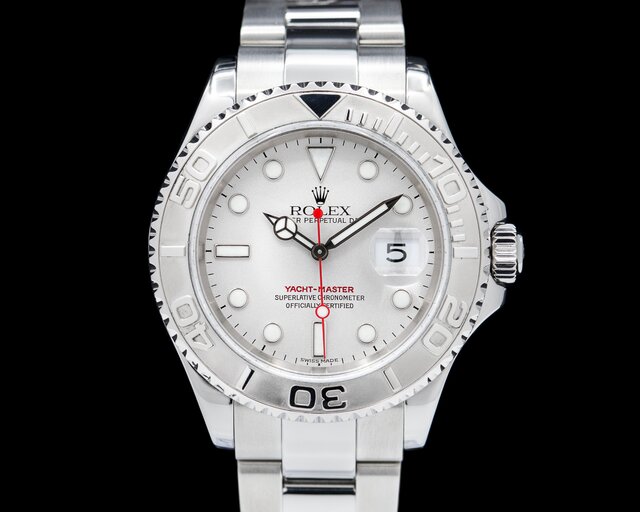
(52234) Rolex 16622 Yacht Master Oyster Perpetual Date, stainless steel on a stainless steel oyster bracelet, automatic, platinum dial with luminous hour markers and hands, date, red central sweep seconds hand, platinum rotating bezel, COSC, F series (2004), size: 40mm, thickness: 13mm, screw-down crown, sapphire crystal, water resistant. Like New with Rolex box and papers dated 2004.
$9,500
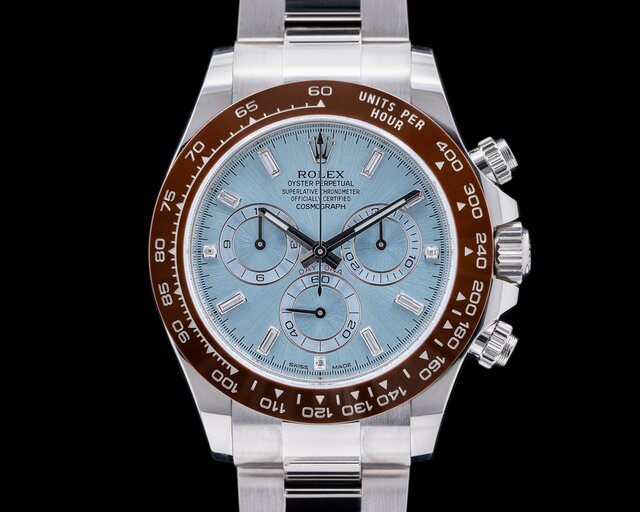
(52643) Rolex Daytona 116506 Oyster Perpetual Daytona Platinum, platinum case on a platinum oyster bracelet, automatic Rolex caliber 4130, chronograph, ice blue glacier dial with baguette diamond hour markers, brown ceramic bezel graduated to 400 units, screw down pushers, sapphire crystal, water resistant to 100ft. size 40mm, thickness 7mm, Scrambled Serial. Like new with box and papers date 2021.
$109,000
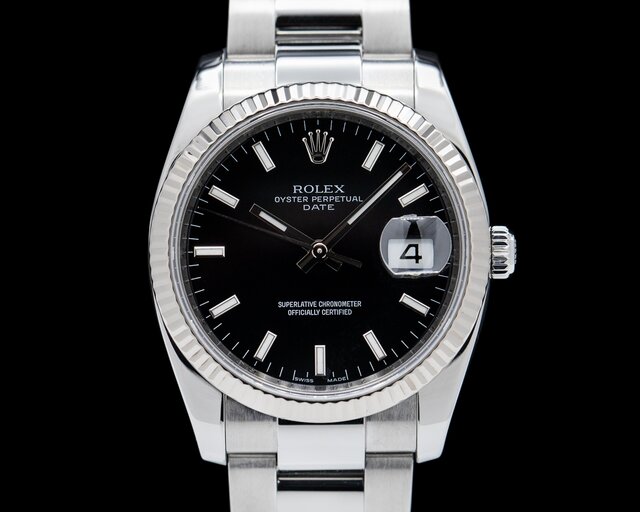
(50780) Rolex Oyster Perpetual Date 115234, stainless steel on a stainless steel Oyster bracelet, fluted white gold bezel, automatic movement, black dial with luminous index hour markers and hands, date, COSC, Z series, diameter: 34mm, thickness: 11.5mm, sapphire crystal, water resistant. Like New with Rolex box and papers dated October of 2009. This watch was serviced by Rolex in 2016.
$6,400
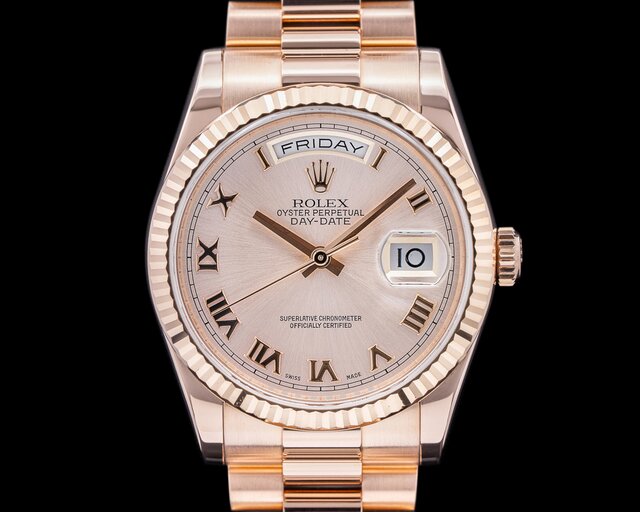
(52137) Rolex 118235 oyster perpetual Day Date President, 18k rose gold on a 18k rose gold Presidential bracelet, automatic Rolex caliber movement, COSC, screw down Triplock crown, metallic pink dial with applied rose gold Roman numerals and a sunburst finish, date at 3 o'clock, day at 12 o'clock, sapphire crystal, water resistant to 100 meters, scrambled serial number size: 36mm, thickness 12.4mm. Like New with Rolex Box and paper...
$27,000
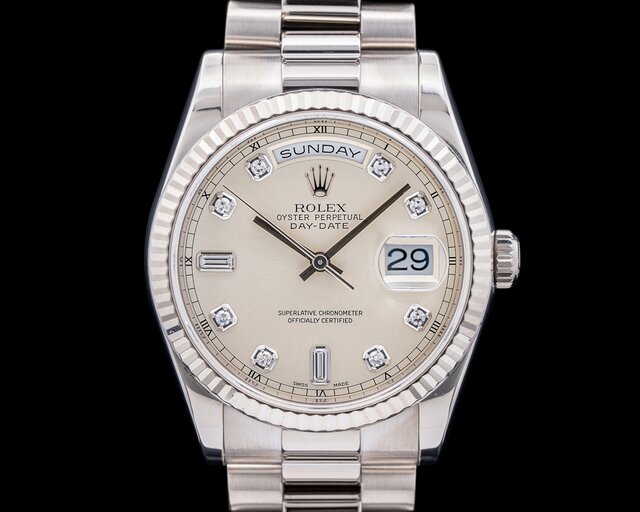
(50131) Rolex 118239 Oyster Perpetual Day-Date President, 18K white gold case with 18K white gold Presidential bracelet, automatic movement, COSC, screw down crown, quick set day and date, cream dial with diamond hour markers, P series (2000) date at 3 o'clock, day at 12 o'clock, sapphire crystal, water resistant, diameter: 36mm, thickness: 12.4mm. Like New with Rolex box and papers dated 2001 and service card dated 2017.
$22,500
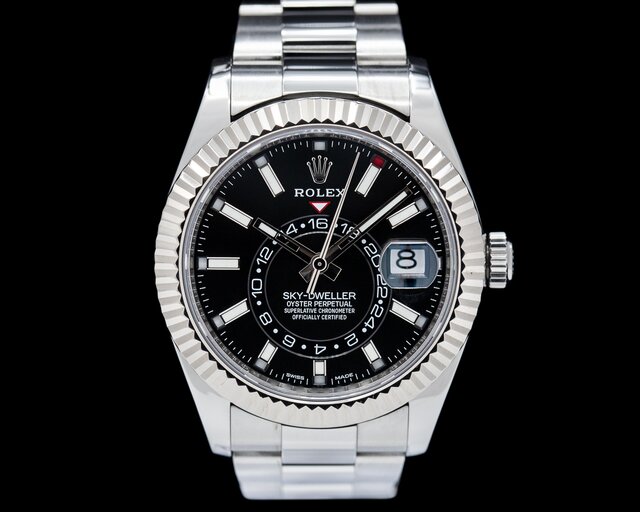
(52703) Rolex 326934 Sky Dweller, stainless steel on a stainless steel Oyster bracelet, automatic Rolex caliber 9001, COSC, 18k white gold rotatable "Command Bezel", GMT located in center of dial, 72-hour power reserve, black dial with applied luminous hour markers, date at 3 o'clock, red indicator on outer minute track indicates the month, size: 42mm, thickness: 14.5mm, water resistant to 100M, sapphire crystal. Like New with Role...
$19,250
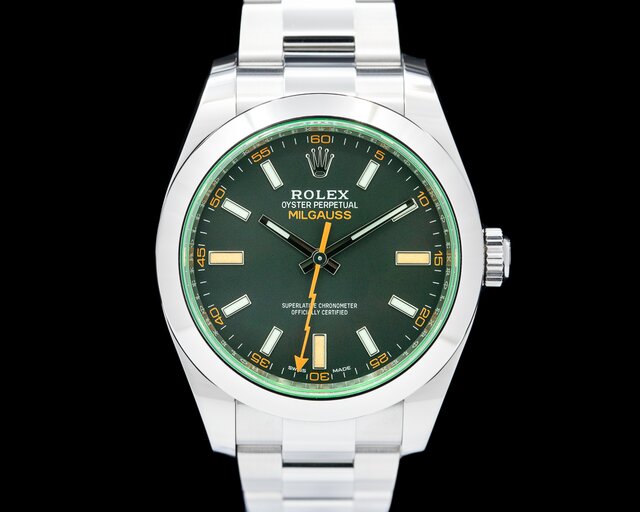
(52748) Rolex 116400 Oyster Perpetual Milgauss, 116400V stainless steel on a stainless steel Oyster bracelet, automatic Rolex caliber 3131 movement, COSC, black dial with green sapphire crystal, luminous applied hour markers and hands, orange lightning bolt shaped second hand, screw down crown, water resistant, scramble serial, diameter: 40mm, thickness: 13mm. Like New with Rolex box and papers dated 2021.
$11,900
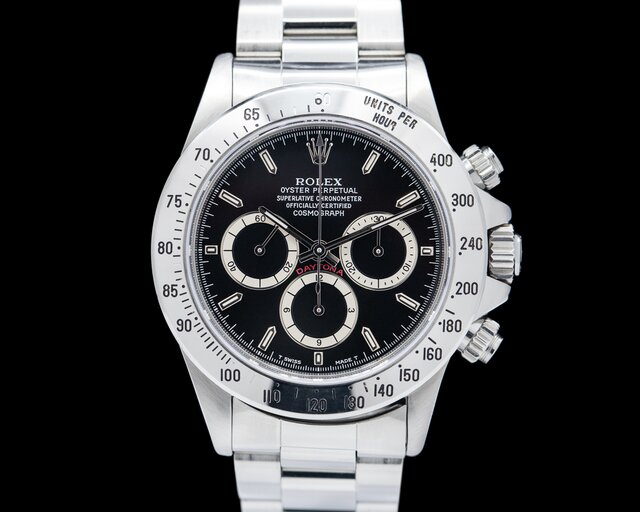
(52409) Rolex 16520 Daytona Zenith Movement with inverted 6, stainless steel on a stainless steel 78390 bracelet with 503B end links, automatic Zenith El Primero movement with 12-hour chronograph, black dial, base 400 bezel is in excellent condition, sapphire crystal, water resistant to 100 meters, size: 40mm, thickness: 12.5mm, S serial (c. 1993). Excellent condition with box and papers, which are undated.
$30,900
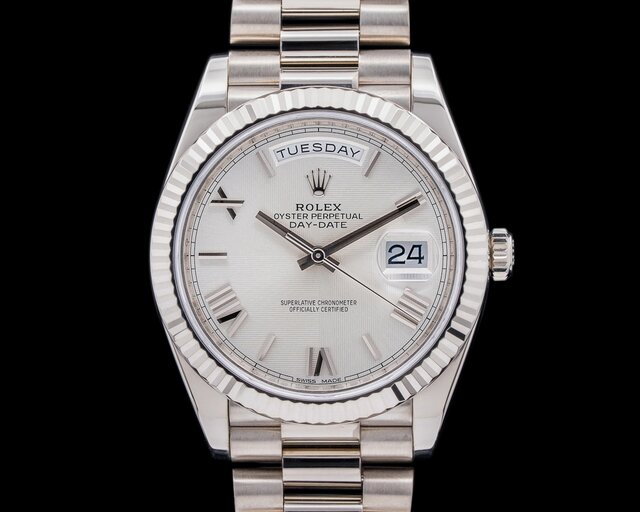
(52640) Rolex 228239 Day-Date President 40mm, 18k white gold on an 18k white gold Presidential bracelet, fluted bezel, automatic Rolex caliber 3255 movement, COSC, screw down crown, silver Quadrant dial with Roman numeral indices, day at 12 o'clock date at 3 o'clock, scrambled serial number, size: 40mm, thickness 18mm, sapphire crystal, water resistant to 100 meters. Like New with Rolex box and papers dated 2016.
$39,900
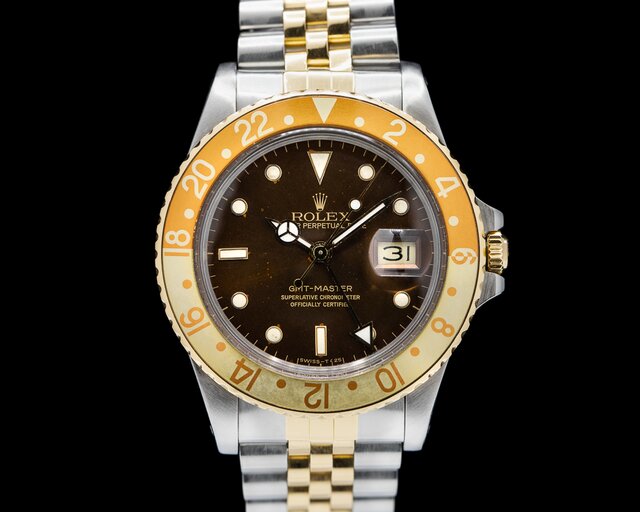
(52410) Rolex 1675/3 GMT Master Root Beer, 16753, 1675 3, stainless steel and 18K yellow gold with "Root Beer" bezel insert on a stainless steel and 18k yellow gold Jubilee bracelet, brown dial with aged tritium luminescent "WGS" white gold surrounds hour markers, matching aged tritium Mercedes handset, water resistant to 100 meters, date at 3 o'clock, second time zone by way of a bi-directional bezel, 9.84M serial (circa 1987), di...
$13,200
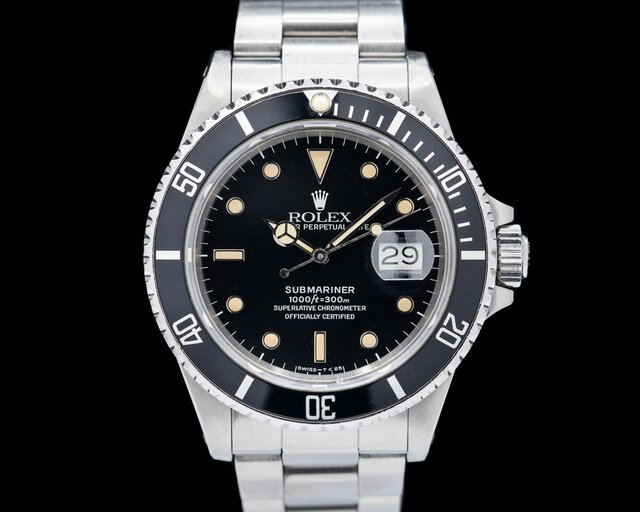
(52405) Rolex 16800 Submariner, stainless steel on a stainless steel 93150 Oyster bracelet with 593 end links, automatic Rolex caliber 3035 movement, original dial is in fantastic condition, original tritium lume has developed a nice even patina on both the hour markers and the hands, date at 3 o'clock, sapphire crystal, screw-down "Triplock" crown, centered sweep seconds hand, COSC, water resistant to 660ft, 9.1M serial (circa 198...
$13,500
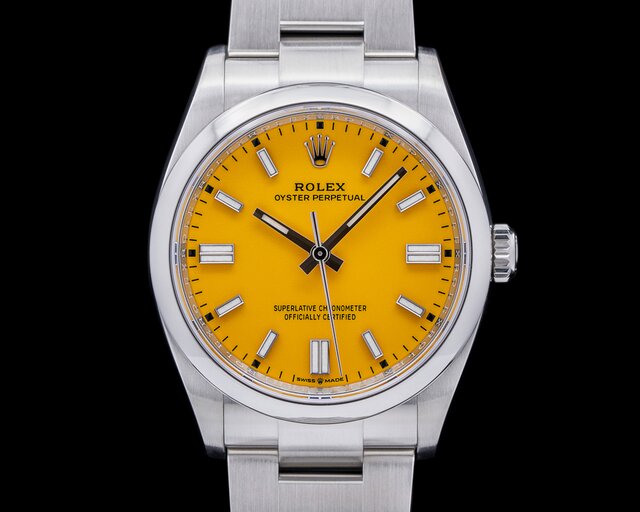
(52516) Rolex 126000 Oyster Perpetual, stainless steel on a stainless steel Oyster bracelet, automatic 3230 Rolex movement, 70-hour power reserve, centered sweep seconds hand, yellow dial with white stick markers, COSC, diameter: 36mm, thickness: 11.8mm, sapphire crystal, scrambled serial, water resistant to 30m/100ft. Like New with Rolex box and papers dated 2022.
$15,000
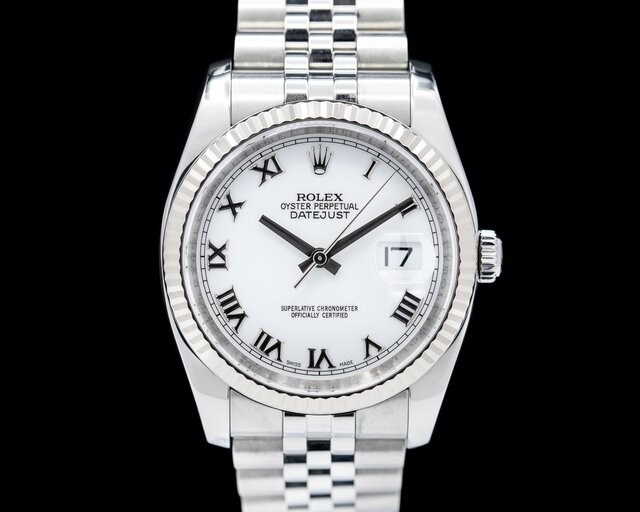
(52390) Rolex 116234 Oyster Perpetual Datejust, stainless steel on a stainless steel Jubilee bracelet, automatic movement, silver dial with applied roman indicators, date, COSC, white gold fluted bezel, centered sweep seconds hand, sapphire crystal, M series (2007/2008), water resistant, diameter: 36mm, thickness: 12mm. Like New with Rolex box.
$8,250
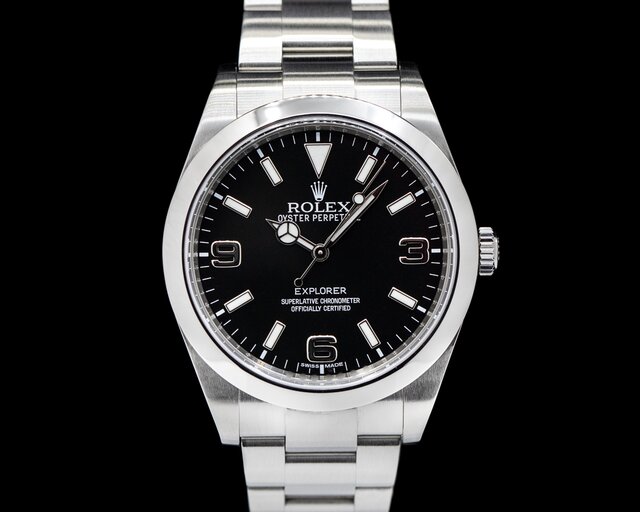
(51746) Rolex 214270 Explorer I, stainless steel case on a stainless steel Oyster bracelet, automatic, mark I black dial with luminous hands and hour indicators, centered sweep second hand, COSC, water resistant to 100 meters, sapphire crystal, scrambled serial, diameter: 39mm, thickness: 12mm. Like new with Rolex box and papers dated 2014.
$7,400

(52715) Rolex 228239 Day-Date President 40mm, 18k white gold on an 18k white gold Presidential bracelet, fluted bezel, automatic Rolex caliber 3255 movement, COSC, screw down crown, blue dial with Roman numerals, date at 3 o'clock, day at 12 o'clock, scrambled serial number, size: 40mm, thickness 18mm, sapphire crystal, water resistant to 100 meters. Like new with original Rolex box and papers dated 2016.
$43,900
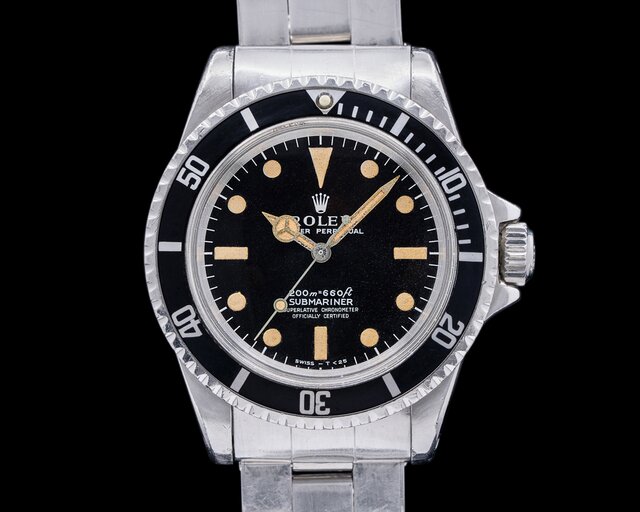
(50932) Vintage Rolex Submariner 5512 MkII Matte Maxi Dial, stainless steel case is in excellent condition and is on a stainless steel riveted oyster bracelet with deployant clasp, automatic Rolex caliber 1570, the original maxi dial is in excellent condition with luminous material that is very clean, centered sweep second hand, bi-directional rotating bezel, screw-down crown, water resistant to 660ft, 1.8 mil serial (1968), diame...
$18,300
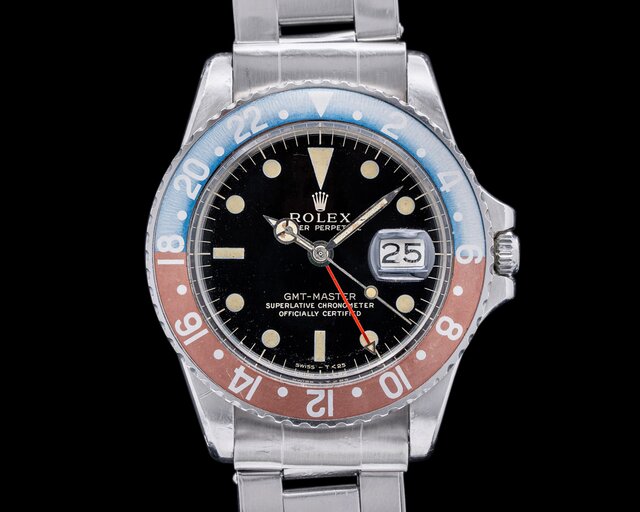
(50668) Rolex 1675 GMT Master Gilt Dial Pepsi Bezel, stainless steel case with rounded crown guards on a 7206 stainless steel rivet Oyster bracelet with (58) end link a foldover deployant clasp stamped 2/65, automatic Rolex caliber 1575 movement, original gilt dial is in fantastic condition with the original tritium lume taking on a rich creamy patina, nicely matching original tritium hands, second time zone with bi-directional 24-...
$23,000
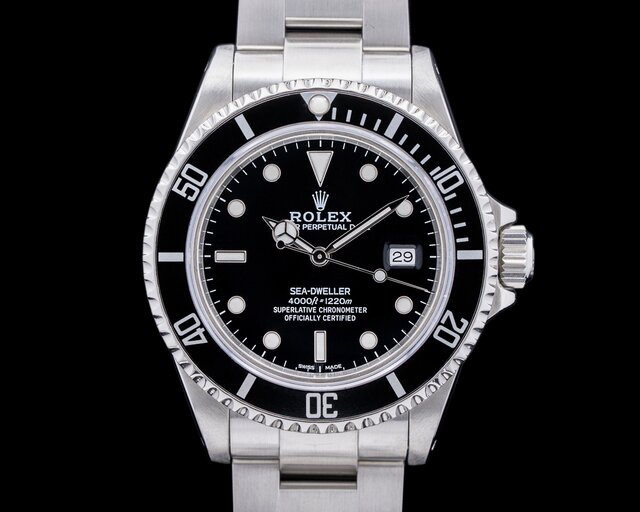
(52379) Rolex 16600 Sea Dweller, original stainless steel case on a stainless steel Oyster bracelet (93160) with 592 end links, automatic Rolex caliber 3035 movement, date at 3 o'clock, centered sweep seconds hand, COSC, uni-directional rotating bezel, screw down crown & caseback, glossy dial with beautifully aged creamy tritium hands and hour indicators, N Serial (1991), water resistant to 4000ft / 1220m, diameter: 40mm, thicknes...
$8,950
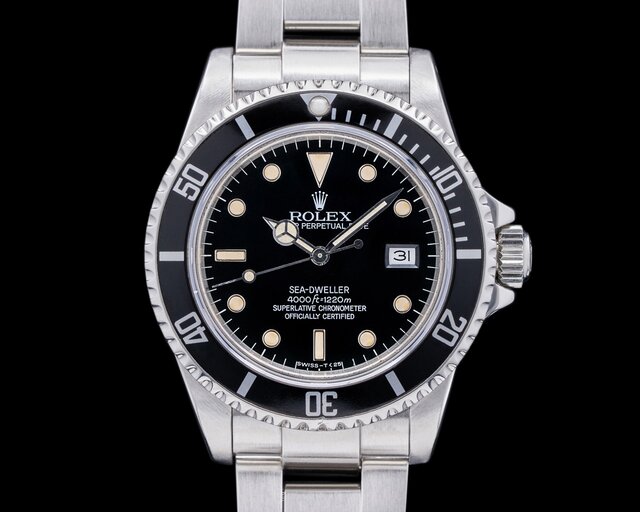
(52389) Rolex 16660 "Triple Six" Sea Dweller, original stainless steel case is very sharp and in excellent condition, on a stainless steel Oyster bracelet (93160) with 592 end links, automatic Rolex caliber 3035 movement, date at 3 o'clock, centered sweep seconds hand, COSC, uni-directional rotating bezel, screw down crown & caseback, glossy dial with beautifully aged creamy tritium hands and hour indicators, 8.3m Serial (1984), wa...
$12,500
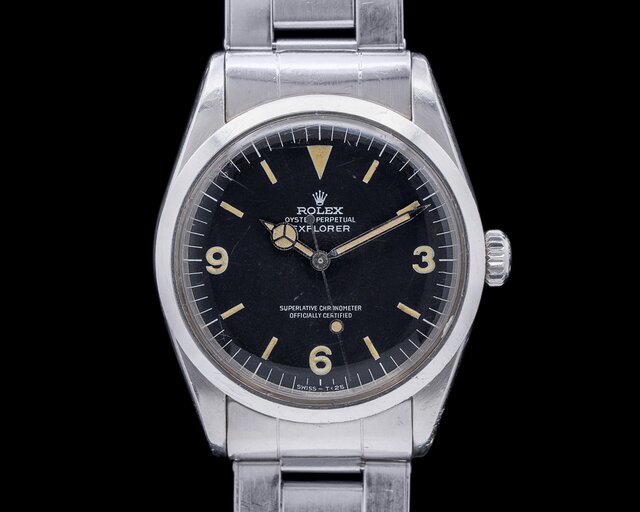
(52718) Rolex 1016 Explorer I "Frog Foot Coronet" logo, stainless steel case on a stainless steel 7206 Rivet Oyster bracelet with 58 endlinks, clasp is stamped 2/66, Mark I matte dial is in excellent condition with no flaws, luminous material on both the hands and dial appear to be original and have aged uniformly to a gorgeous cream color, acrylic crystal, water resistant, serial 173XXXX (1966). Excellent Condition.
$17,900

(52304) Rolex 16600T Sea Dweller, "no holes" stainless steel case, on a stainless steel oyster bracelet, solid end links, automatic Rolex caliber 3135 movement, black glossy dial with applied luminous hour markers, luminous Mercedes hands, date, centered sweep seconds hand, COSC, diameter: 40mm, thickness: 14.1mm, F Serial (2004), Excellent condition with Rolex service box.
$8,950
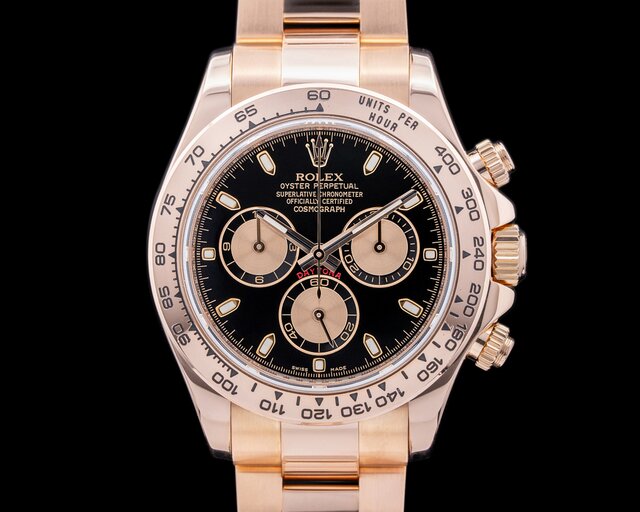
(52324) Rolex 116505 Cosmograph Daytona, 18k rose gold on an 18k rose gold Oyster bracelet, automatic movement, chronograph, black dial with rose color sub-dials, sapphire crystal, water resistant to 100 meters, scrambled serial, diameter: 40mm, thickness: 12mm. Like new with box and booklets and papers dated 2012. This watch was completely serviced in 2023.
$47,400
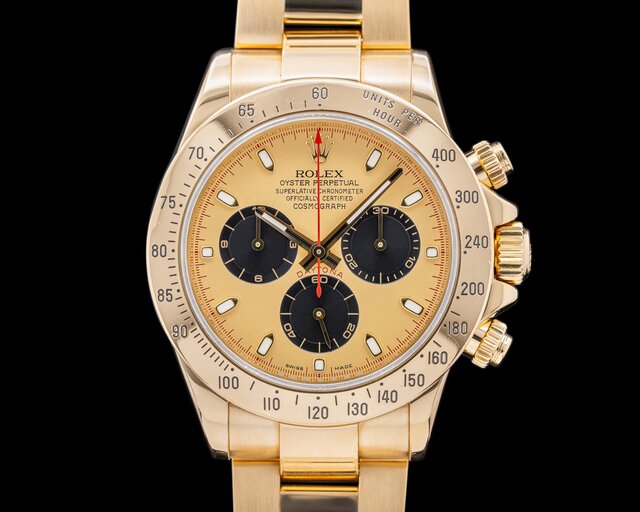
(51933) Rolex Cosmograph Daytona 116528, 18k yellow gold on an 18k yellow gold Oyster bracelet, automatic Rolex caliber 4130 movement, 12- hour chronograph with screw-down pushers, gold dial with contrasting champagne sub-dials, yellow gold tachymeter bezel, diameter: 40mm, thickness: 12mm, sapphire crystal, Z series (2006), water resistant to 100 meters. Like new with box and papers dated 2006.
$46,500
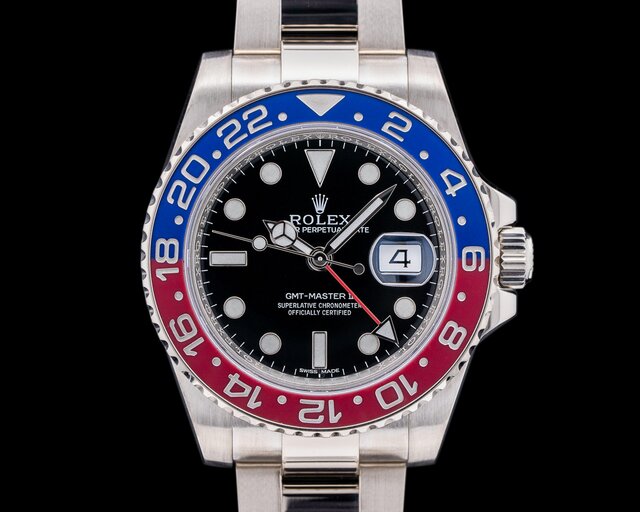
(52416) Rolex 116719 GMT Master II "Black Dial Pepsi", 116719BLRO, 18k white gold on a matching white gold Oyster bracelet, new in-house automatic Rolex caliber 3186 movement, blue and red ceramic bezel with silver Arabic numerals, black dial, date at 3 o'clock, triangular GMT hand, COSC, sapphire crystal, water resistant to 100 meters, diameter: 40mm, thickness: 12mm, scrambled serial number. Like New with Rolex Box and papers dat...
$34,900
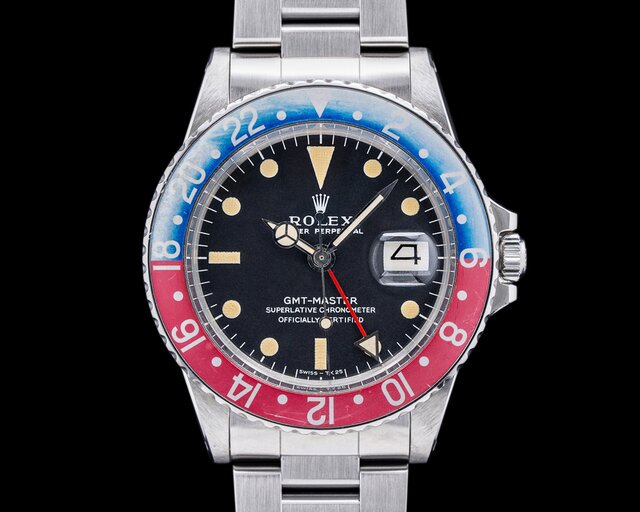
(51339) Rolex 1675 GMT Master Pepsi Bezel Mark I "Long E", stainless steel case is very sharp on a stainless steel Oyster bracelet, automatic Rolex caliber 1575 movement, original matte Mark I ("Long E") dial is in fantastic condition, original tritium lume has aged to a nice creamy patina on the dial and hands, second time zone with bi-directional blue and red 24-hour bezel, 24-hour hand, COSC, 293XXXX serial number (c. 1972), dia...
$15,900
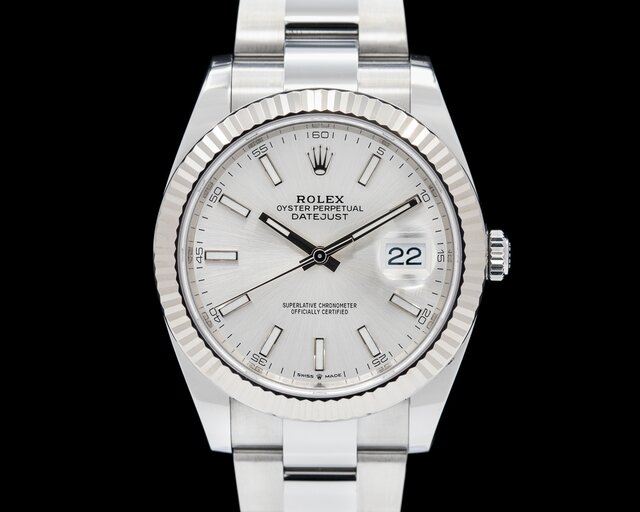
(52030) Rolex 126334 Oyster Perpetual Datejust 41, stainless steel with an 18k white gold fluted bezel on a stainless steel Oyster bracelet, automatic Rolex caliber 3235 movement, date with magnifier at 3 o'clock, centered sweep seconds hand, silver sunburst dial with applied luminous hour markers, COSC, sapphire crystal, scrambled serial, diameter: 41mm, thickness: 11.8mm. Like New with Rolex box and papers dated 2022.
$10,900
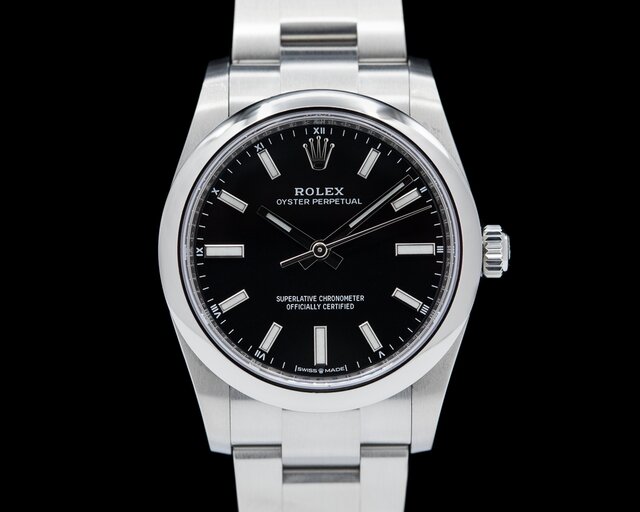
(52249) UNWORN Rolex 124200 Oyster Perpetual, New Model for 2020, stainless steel on a stainless steel oyster bracelet, automatic 3230 Rolex movement, 70-hour power reserve, centered sweep seconds hand, black dial with white stick markers, COSC, diameter: 34mm, thickness: 11.8mm, sapphire crystal, scrambled serial, water resistant to 30m / 100ft. Like New with Rolex box and papers dated 2021.
$6,600

(52457) Rolex 16570 Explorer II "Polar", stainless steel case on an integrated stainless steel oyster bracelet, automatic Rolex caliber 3185 movement, white dial with applied luminous hour markers, date at 3 o'clock with magnifier, two time zones, cosc, centered sweep second hand, water resistant to 10 atm, sapphire crystal, diameter: 40mm, thickness: 12mm, S serial (1993). Like New with Rolex box & papers dated 1994.
$8,900
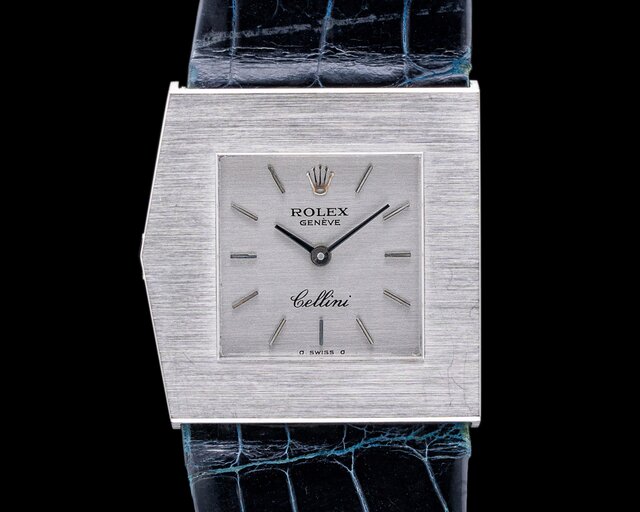
(52650) Rolex Cellini "King Midas" 4017, 4017-10, asymmetric left-handed 18K white gold case on original lizard strap with a Rolex tang buckle, winding crown at 9 o'clock, manual wind Rolex 1601 movement, beautiful silver dial with applied indices and black baton hands, diameter: 28mm, thickness: 5mm. Exceptional original condition with original box and papers dated 1978. The watch comes on its original strap and has never been pol...
$11,900
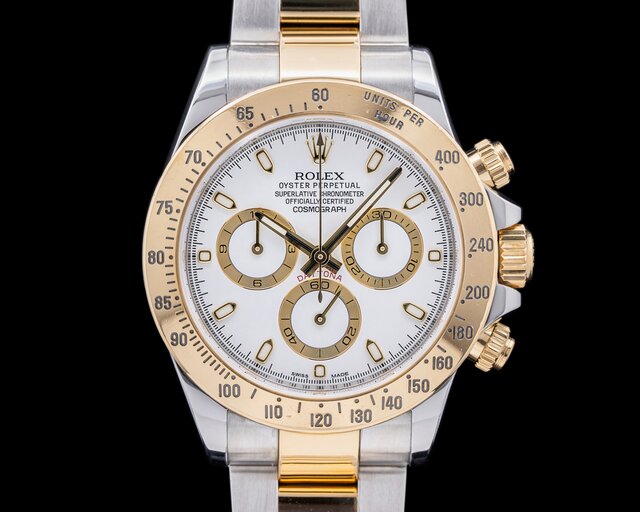
(52085) Rolex 116503 Cosmograph Daytona, stainless steel and 18k yellow gold on a stainless steel and 18k yellow gold oyster bracelet, automatic Rolex caliber 4130, 12-hour chronograph, white dial, luminous yellow gold hands, sapphire crystal, water resistant to 100 meters, scrambled series, diameter: 40mm, thickness: 12mm. Like New with Rolex box.
$19,900

Rolex Submariner Ceramic SS / SS 2018
$11,150

Rolex Submariner 16613 Blue Dial SS / 18K Nice Patina
$11,500

Rolex Sea Dweller Deep Sea 116660
$10,750

Rolex Sea Dweller Deep Sea 116660
$9,900

Rolex Datejust 41 126334 Wimbledon Dial Oyster Bracelet
$13,500

Rolex GMT Master II 126711 Ceramic Root Beer SS / 18K
$18,950

Rolex GMT Master II 126711 Ceramic Root Beer SS / 18K
$18,900

Rolex President 128236 Platinum Ice Blue Roman Dial 2023
$57,000

Rolex Daytona 116500LN Ceramic Bezel SS / White Dial
$30,900

Rolex Oyster Perpetual 124300 41mm SS / Blue Dial
$8,650

Rolex Explorer I 124273 Oystersteel/18k 36MM
$10,500

Rolex Day Date 228239 President 18K White Gold Blue Dial 40MM 2022
$42,400

Rolex Submariner 16613 Blue Dial SS / 18K
$11,900

Rolex Daytona 126519 18K White Gold Ceramic Oysterflex Black Diamonds UNWORN
$40,700

Rolex Daytona 116519 18K Ceramic Black Diamond Dial 2022
$37,800

Rolex Datejust 16233 White Roman Dial Jubilee 18K / SS
$5,900

Rolex Daytona 116500 Ceramic Bezel SS / Black Dial
$26,900

Rolex Submariner 50th Anniversary "Kermit" SS Green Bezel
$16,250

Rolex Sky-Dweller 326934 Steel White Dial SS
$19,900

Rolex Day Date President 118238 Champagne Dial 18K Yellow Gold
$24,900

Rolex Explorer II SS White Dial 16570
$7,750

Rolex Explorer I 14270 36MM SS VERY SHARP ORIGINAL ONWER
$7,250

Rolex Submariner Date 126610LV Kermit GREEN Ceramic Bezel 41MM
$14,900

Rolex Day Date President 118235 salmon diamond dial 18K Rose Gold
$35,900

Rolex Daytona 116519 18K White Gold Ceramic Oysterflex Silver Dial
$36,500

Rolex Vintage Serif Matte Dial Submariner 5513 Circa 1978
$12,900

Rolex Day Date President 228398TRU 18K YG Pave / Ruby Dial
$259,900

Rolex Datejust 41 Blue Dial DIAMONDS 2022
$15,900

Rolex Sky Dweller 326934 Steel Blue SS / Bracelet 2018
$20,900

Rolex Explorer II SS Black Dial
$8,250

Rolex Submariner 50th Anniversary SS Green Bezel
$15,250

Rolex GMT Master II "FAT LADY" Red / Black Coke 1987
$13,250

Rolex Daytona 116508 18k Yellow Gold / Green Dial 2022
$73,900

Rolex Submariner Date 116659SABR 18K WG Diamonds / Sapphires UNWORN
$152,500

Rolex Daytona 116519 18K WG Ceramic Oysterflex METEORITE Dial UNWORN
$92,500

Rolex Sky Dweller 336934 Steel Mint Green Dial NEW MODEL UNWORN
$28,900

Rolex Daytona 116519 18K White Gold Ceramic Oysterflex Silver Dial
$39,500

Rolex Left-Handed GMT Master II 126720VTNR "SPRITE"
$17,900

Rolex Oyster Perpetual 126000 36MM SS Silver 2021
$7,750

Rolex Datejust 41 126300 Silver Stick Dial SS
$9,150

Rolex Yacht Master 18K Yellow Gold / Rubber 42MM 2022
$31,500

Rolex Yacht Master 18K Rose Gold / Rubber MIDSIZE 37MM
$23,500

Rolex Day Date 228206 Platinum Meteorite Dial DIAMONDS 40MM
$84,500

Rolex Daytona 116509 Black Diamond Dial 18K White Gold
$37,900

Rolex Daytona 16520 Zenith Black Dial SS BOX/PAPERS
$27,500

Rolex Datejust 41 126300 Rhodium Stick Dial SS 2022
$9,400

Rolex Datejust II Silver Dial Blue Arabic SS
$10,200

Rolex Air King 116900 Black Dial SS 2021
$7,450

Rolex Daytona Everose 116505 Black Dial 18K Rose Gold / Bracelet
$42,800

Rolex Daytona Black Dial Diamonds 18K / SS 2022
$26,900

Rolex GMT Master 16758 18k Yellow Gold Jubilee
$33,200

Rolex Yacht Master Mid Size SS / Platinum Bezel
$8,250

Rolex Vintage Explorer I Gilt Chapter Dial SS / SS
$21,400

Rolex Daytona 116520 Black Dial Full Set SERVICED
$25,900

Rolex Daytona 116520 Black Dial SS
$23,900

Rolex Day Date President 128235 Gray Diamond Dial 2024
$40,600

Rolex Datejust 41 Black Diamond Dial SS 2023
$11,400

Rolex Yacht Master 16622 Platinum Bezel
$9,500

Rolex Daytona Platinum 116506 Glacier Blue Diamond Dial
$109,000

Rolex Oyster Perpetual Date Black Dial SS/SS
$6,400

Rolex Day Date President 118235 Pink Dial 18K Rose Gold
$27,000

Rolex Day-Date President Diamond Dial 18k White Gold FULL SET
$22,500

Rolex Sky Dweller 326934 Steel Black SS Oyster Bracelet
$19,250

Rolex Milgauss 116400V SS Black Dial Green Crystal 2021
$11,900

Rolex Daytona 16520 "Zenith" 1993 Black Dial inverted 6 BOX/PAPERS
$30,900

Rolex Day Date 228239 President 18K White Gold Silver Dial 40MM
$39,900

Rolex GMT Master Brown Nipple Dial "Root Beer" Bezel c. 1987
$13,200

Rolex Submariner 16800 SS FULL SET Circa 1987
$13,500

Rolex Oyster Perpetual 126000 36mm SS / Yellow Dial
$15,000

Rolex Datejust SS Jubilee White Roman Dial
$8,250

Rolex Explorer I 214270 39MM
$7,400

Rolex Day Date 228239 President 18K White Gold Blue Dial 40MM
$43,900

Rolex Vintage 5512 Submariner MkII MATTE MAXI DIAL
$18,300

Rolex Vintage GMT Master 1675 Gilt Dial Pepsi c. 1965 NICE
$23,000

Rolex Vintage 16600 Sea Dweller
$8,950

Rolex Vintage 16660 Sea Dweller Circa 1984 NICE PATINA
$12,500

Rolex Vintage Explorer I "Frog Foot Coronet" Logo c. 1966
$17,900

Rolex Sea Dweller 16600T SS/SS
$8,950

Rolex Daytona Everose 116505 Black Dial 18K Rose Gold SERVICE
$47,400

Rolex Daytona 116528 18K Yellow Gold "PAUL NEWMAN" Dial
$46,500

Rolex GMT Master II 116719 Ceramic "Pepsi" 18k Black Dial
$34,900

Rolex Vintage Pepsi GMT Master "Long E" Dial c. 1972
$15,900

Rolex Datejust 41 Silver Stick Dial SS / Oyster
$10,900

Rolex Oyster Perpetual 124200 34mm Black Dial
$6,600

Rolex Explorer II "Polar" 16570 White Dial SS
$8,900

Rolex Cellini King Midas 18k White Gold FULL SET TOP CONDITION
$11,900

Rolex Daytona White Dial 18K Yellow Gold / SS
$19,900
Guide to Rolex Watches
There is much discussion, even controversy, in classifying watches as an asset class. Nevertheless, among watches, Rolex is what the market would consider a "blue-chip" investment. Market data shows that the prices of Rolex watches, whether on the primary or secondary market, have increased significantly over time. To illustrate, the market price of the Rolex Daytona 116500LN in March 2017 was around $18,000. As of the beginning of 2022, listings of the same watch are in the range of $38,000 to $40,000. That being said, within the Rolex model line there are certain pieces that are more valuable than others, with the Daytona, Submariner, and GMT Master leading the pack.
Since 2005, the serial numbers of Rolex watches can be found engraved in the rehaut (the inner metal ring between the crystal and the dial) on the 6 o'clock side. Before 2005, serial numbers were engraved between the lugs at the 6 o’clock position.
Rolex watches are water-resistant, not waterproof. They are not water proof because they resist water pressure only up to a certain depth: 100m on most watches, 300m on the Submariner, 1,220m on the Sea Dweller, and 3,900m on the Deepsea. That being said, a water resistance of 100 meters, paired with a screw-down crown, is more than sufficient for everything except the most extreme of situations. If you are planning to dive to the bottom of the ocean, however, the increased water resistance of the Seadweller or Deepsea would be more suitable!
Rolex does not officially disclose the number of watches it produces per year, but industry experts estimate that the company produces around 800,000 to 1,000,000 watches annually.
History of Rolex Watches

The True Pursuit of Excellence
Rolex watches have a long-standing history of proven reliability under the most extreme conditions, including the deepest trenches in the ocean, the peaks of the world's tallest mountains, and on the wrists of racers competing on land, air, and sea. The entire planet has served as a living laboratory for some of the most durable and beautiful timepieces ever made.
Hans Wilsdorf, the creator and founder of Rolex, wanted his watches to be known for their durability and accuracy and utilized the world to continually test his timepieces in as many real-life situations as he could. Instead of technicians, he chose to use explorers, adventurers, and racers to put his watches to the grindstone in the most exotic and inhospitable locations on the planet. This connection with the natural world quickly became a key part of the Rolex corporate ethos and the preservation and protection of our planet's wondrous ecosystems became synonymous with the keeping of time and conducting of business. Wilsdorf was a true visionary who strove to treat his employees with the same deference as the planet, and always put the wellbeing of his workers before the commercial success of his company.
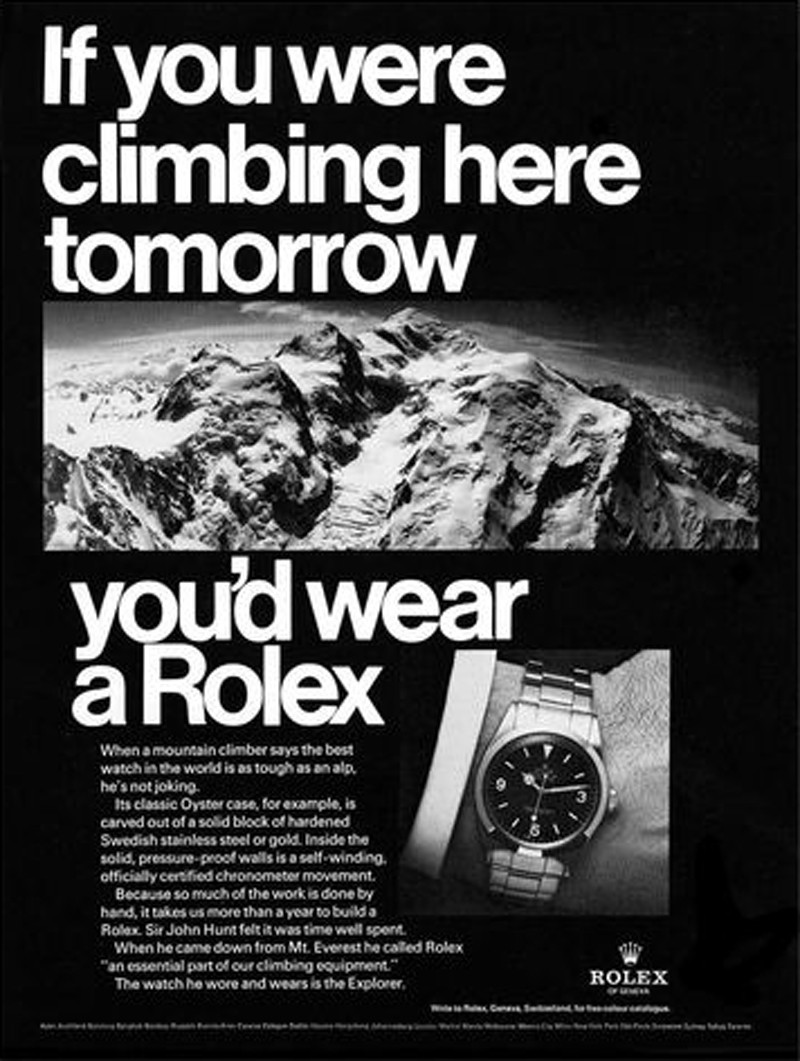

As an homage to their founder and to ensure that the brand maintains its perpetual quest for excellence, Rolex maintains a state of the art training center in Geneva, Switzerland. This facility is where Rolex apprentices and employees continue their education and work to master the skills needed to push the brand forward into the future. The Rolex Training Center ensures that each individual worker is versed in the company's long history, and makes it clear that it will always strive to enhance personal and corporate development as well as a deep commitment to the welfare of the planet.
Rolex currently underwrites more than 100 major international events including a number of iconic sporting tournaments such as Wimbledon, the PGA Championship, motor and yacht races, and the Olympics.


In order to help pass on the world's artistic heritage to future generations, the company also supports the Academy of Motion Picture Arts and Sciences, the Teatro Alla Scala in Milan, and their own Rolex Mentor and Protégé Arts Initiative (among others). They have over 140 dedicated spokespersons including filmmaker Martin Scorsese, tennis great Roger Federer, and Sylvia Earle. They created the Rolex Awards for Enterprise which supports talented people with innovative projects solving major challenges. The manufacture of superb watches goes hand-in-hand with a social consciousness that keeps its eyes on the betterment of mankind.
The history of this wonderful company is just as interesting as the remarkable timepieces it makes. Large successful corporations often make meaningful contributions to society, but very few have ever made such a genuine, concerted effort to serve humanity to the degree that Hans Wilsdorf and Rolex have made in their 100+ year history.
THE EARLY YEARS
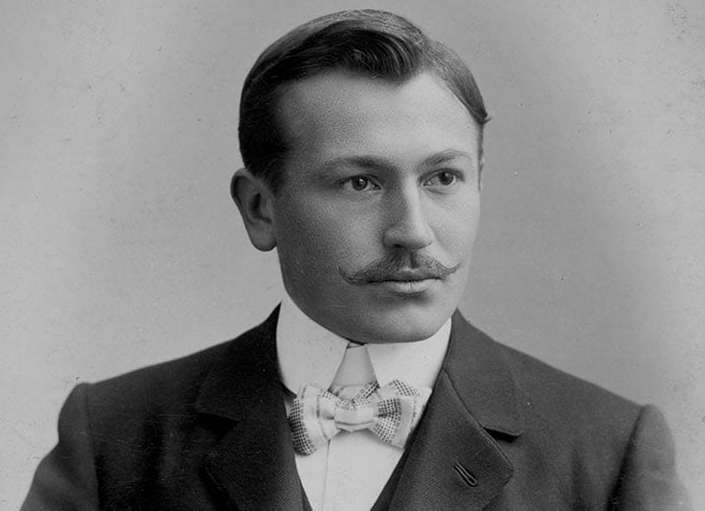

Hans Wilsdorf, the genius and father of one of the greatest sports watch manufacturers ever, was born on March 22, 1881 in Kulmbach, Germany. A picturesque town with a Medieval hilltop castle, it has Bavarian breweries and bakeries and bicycle paths along the River Main, which flows gently into the Rhine. It's an "outdoorsy" kind of town whose citizens have always been active, so it's only fitting that Rolex watches were born here.
Hans was the second son of three children born to Anna Maisel and Johan Daniel Ferdinand Wilsdorf. His siblings included an older brother Karl (b. 1879) and sister Anna (b. 1882). Tragically, his mother Anna died at 36 when Hans was just 10, and Johan passed away at 47 two years later. Passed into the care of their uncles, the family was forced to sell a prosperous business that had been started by Hans’ grandfather in order to support them. The children were sent to the finest boarding schools for outstanding education and in his four-volume autobiography Rolex Jubilee Vade Mecum, published in 1946, Hans wrote:
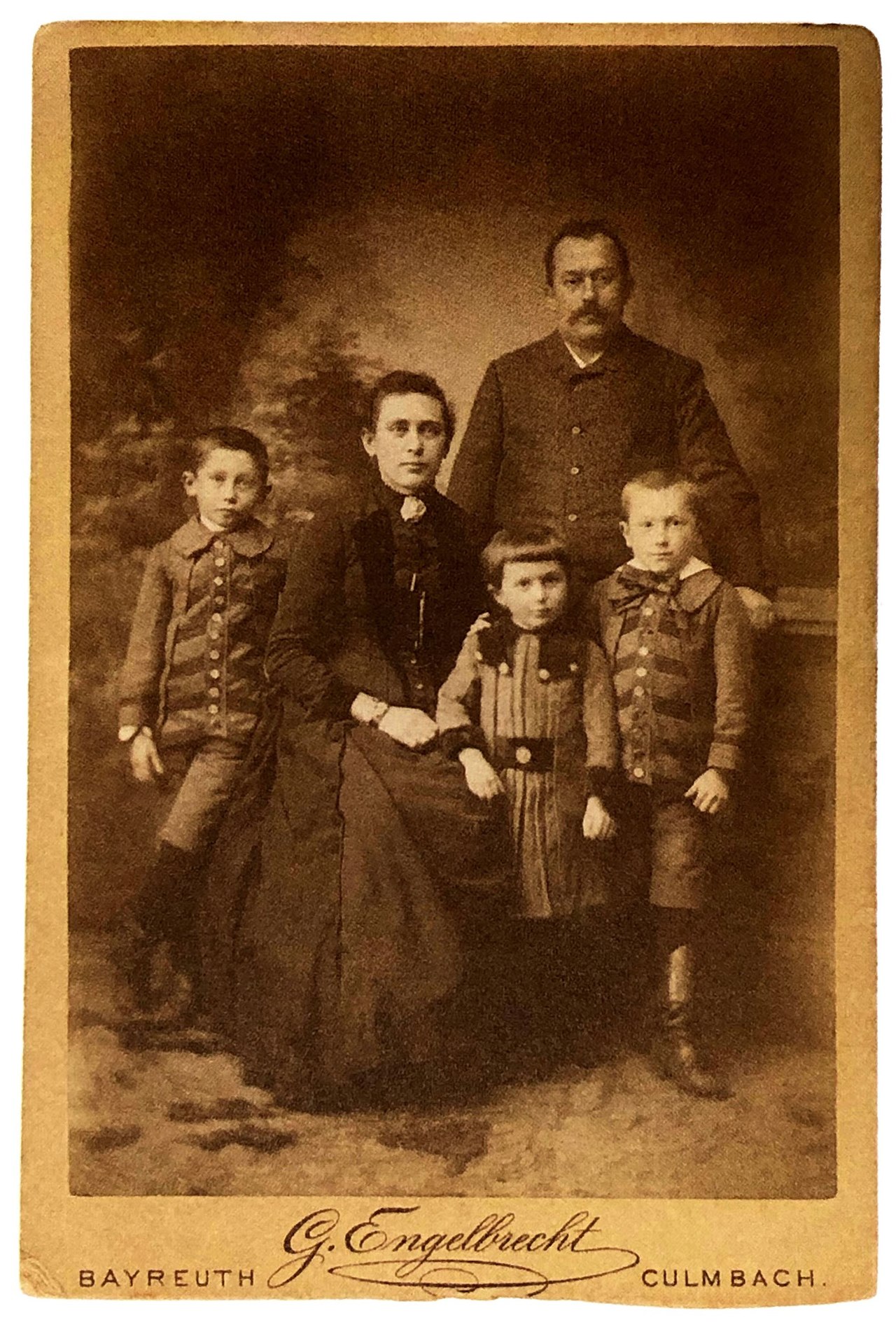
"Our uncles were not indifferent to our fate; nevertheless, the way in which they made me become self-reliant very early in life made me acquire the habit of looking after my possessions and, looking back, I believe that it is to this that much of my success is due."
Hans had a brilliant aptitude for languages and mathematics, preparing him well for future travels. His first employment was as an apprentice in an international pearl exporting company which would go on to play an essential role in his future choices. In 1900 Hans moved to La Chaux-de-Fonds in Switzerland where he began his watchmaking career at 19 in the watch firm of Cuno Korten. Korten exported over a million francs worth of pocket watches each year, including brokered mechanisms and a small number of pieces that were built completely at the firm, teaching young Hans the craft of watchmaking. His first job was winding hundreds of pocket watches every day, a task that would one day inspire a true revolution in the Swiss watch industry.
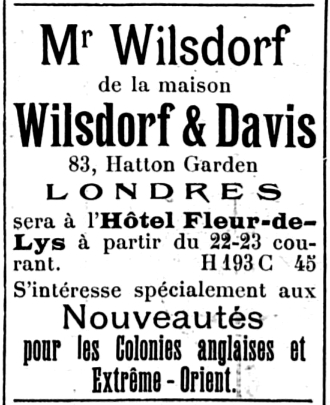
In 1903 Hans moved to London to join Leopold Robert, another watchmaking company renowned for their quality. At just 24 years-old in 1905, he left Leopold Robert and started his own business at 83 Hatton Garden with an English builder named Alfred James Davis. They called it Wilsdorf & Davis and set out to sell high-quality timepieces at affordable prices.
Rolex, as we know it today, was born in London in 1908, a story as thoughtful and unpretentious as can be imagined. In what can only be described as a brilliant piece of marketing in an industry full of imposing international names, Wilsdorf desired simplicity that would appeal to everyone. He wanted his watches to bear a name that was concise and short, a universal type of title that was easy to remember and pronounce in every language and that was attractive when printed or engraved on watch mechanisms and dials. Fifty years later, on Rolex's 50th anniversary in 1958, he shared the story of how the unique name simply came to him on a London bus in 1908:
"I tried combining the letters of the alphabet in every possible way. This gave some hundred names, but none of them felt quite right. It was one morning when I was sitting on the upper level of a double-decker powered at that time by horses, driving along Cheapside in London, that a good genie whispered in my ear: "Rolex." A few days after this fruitful journey, the Rolex brand was filed, and then officially registered in Switzerland by Wilsdorf & Davis."
In the early years of the 20th century when pocket watches were the standard and wristwatches were a novelty referred to as "wristlets," Wilsdorf was completely confident that the wristwatch was the future. He embraced the idea wholeheartedly, determined to make this paradigm change a reality. His first action was to travel to Bienne, Switzerland to connect with Hermann Aegler, who was making excellent quality ebauches - small lever escapement watch movements. Wilsdorf placed the largest order ever made for wristlet mechanisms with Aegler, thus forming a groundbreaking partnership that would last for nearly one hundred years until Rolex bought Aegler completely in 2004. Wilsdorf prioritized chronometric precision and the quality of the movement, which immediately contributed to huge success. His Rolex watch was the first wristwatch to be awarded the Swiss Certificate of Chronometric Precision by the official watch rating center in Bienne.
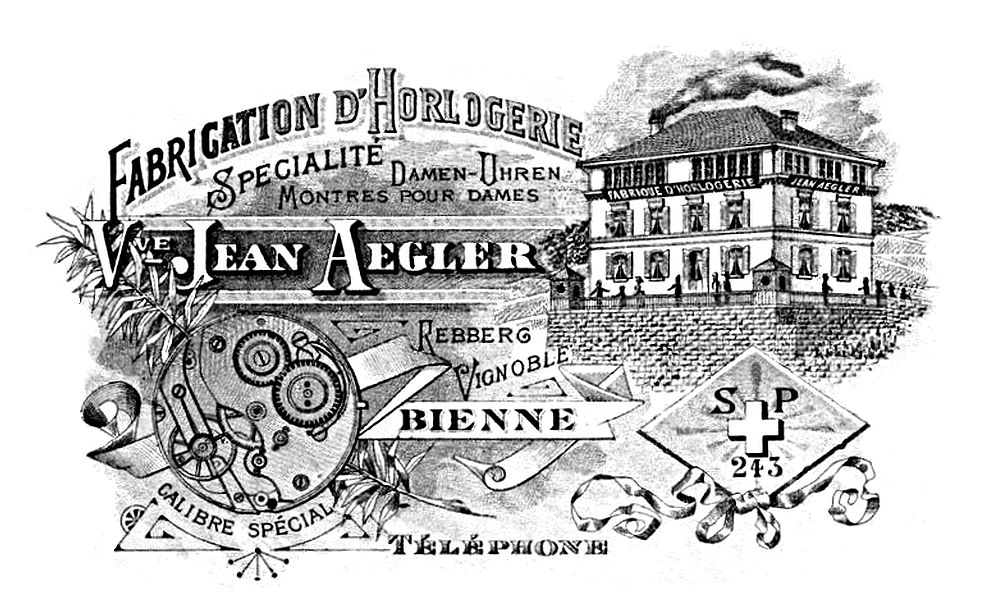

Still centered in London, Wilsdorf & Davis prospered immensely and in 1914 - ten years after Wilsdorf came to London and only two weeks before war was declared with Germany, Wilsdorf & Davis formally changed their name to The Rolex Watch Company Ltd. That same year, a small ladies’ wristwatch was awarded a “Class A” certification from the prestigious Kew Observatory in London, making Rolex the first manufacturer other than marine chronometers to receive honors from both Kew and Bienne. The Rolex wristwatch quickly became synonymous with precision and their success and notoriety fueled the company’s growth to more than 40 employees, prompting Hans Wilsdorf to write.
"…pocket watches will almost completely disappear and wrist watches will replace them definitively. I am not mistaken in this opinion and you will see that I am right.
In 1915, in a shocking turn of events, the British government announced an explosive 33% customs duty on businesses to help raise funds to fight the war. This tax increase forced Wilsdorf to move his international headquarters to Bienne, Switzerland, where he opened Montres Rolex S.A. In 1919, the company relocated again to Geneva, the capital of Swiss watchmaking, where it has remained to this day.


Thanks to the innovation of screw-down components, Rolex was able to introduce the first dustproof and waterproof wristwatch with a hermetically sealed case nicknamed the “Oyster” after its indomitable oceanic namesake. It was a major step forward in watchmaking and paved the way for nearly every water-resistant watch that exists today. Skeptics abounded as to whether a wristwatch could indeed be waterproof, but in 1927, a young English swimmer named Mercedes Gleitze wore a Rolex Oyster in a landmark 10-hour swim across the English Channel. Since 1922, she had attempted the feat 7 times, and on her 8th (successful) try she was wearing a Rolex Oyster.
On November 24th Rolex published a full-page ad on the front page of the Daily Mail touting the accomplishment of Gleitze and her Oyster. When English naysayers cast doubt on her triumphant achievement, she attempted a second "Vindication Swim" two weeks later. Unfortunately, the water had grown much colder in the ensuing 14 days and she had to be pulled from the Channel before reaching the other side. Even so, she wore her Oyster on a ribbon around her neck, and once again it kept perfect time. She also wore her Rolex while completing a crossing of the Strait of Gibraltar in 1928. Gleitze’s escapades marked the auspicious birth of the Rolex testimonial tradition which saw sports stars and adventurers publicize accounts of their exploits accompanied by their watches.

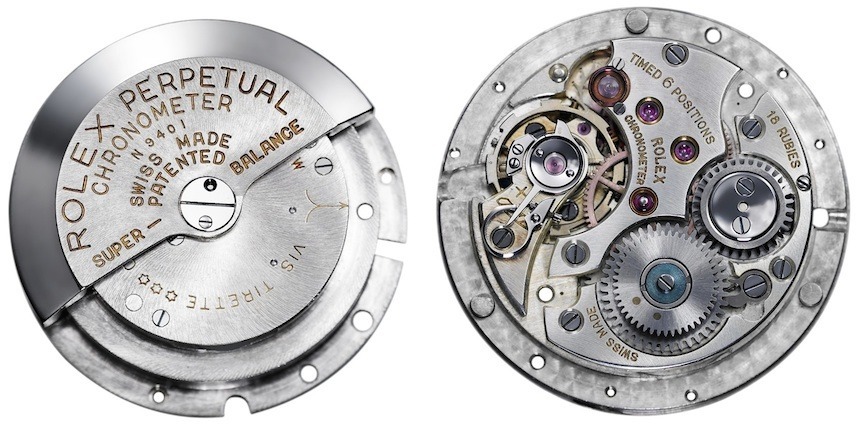
In 1931 Hans Wilsdorf and his engineers at Rolex invented and patented a great work of art - the self-winding watch mechanism using what they called a "Perpetual" rotor. This seemingly simple, yet ingenious mechanical system was a technological revolution that remains at the core of every modern automatic watch. When he was 19 and working at the watch firm of Cuno Korten in La Chaux-de-Fonds, young Wilsdorf began his day by winding the stems of a hundred watch movements. This experience gave birth to the idea of a self-winding mechanism, and the belief that by re-ordering a set of tiny gears a much more reliable and simpler solution to constantly turning the fragile winding crown could be achieved.
The innovative rotor allowed the mechanism to operate perpetually using only the energy created by the natural waving motion of the wearer's wrist. The mechanism itself has a semicircular-shaped oscillating weight that rotates bi-directionally and feeds a ratcheted winding mechanism, which in turn winds the spiral-shaped mainspring that powers the watch's gears, giving the watch a stable and "perpetual" source of power. Previous self-winding movements used rotors that oscillated just 200 degrees, but the new Rolex Perpetual was able to rotate a full 360 degrees which produced an efficiency never achieved before allowing the watch to run on its own for up to 35 hours at rest.
Rolex cemented itself as the definitive adventurer's watch when Oysters were worn on the first expedition to fly over Mount Everest on April 3, 1933. Lord Clydesdale, the youngest squadron leader in the Royal Air Force and commander of the 602 Squadron, agreed to pilot a Westland PV-6 biplane, accompanied by a modified Westland PV-3 equipped with oxygen systems and heated multi-layer sheepskin flying suits, although the cockpits remained open. The expedition was a triumph for technological advancement (including the Rolex Oyster), aviation, and photography, with photographs taken with a Williamson Automatic Eagle III by cinematographer Sidney R.G. Bonnett.
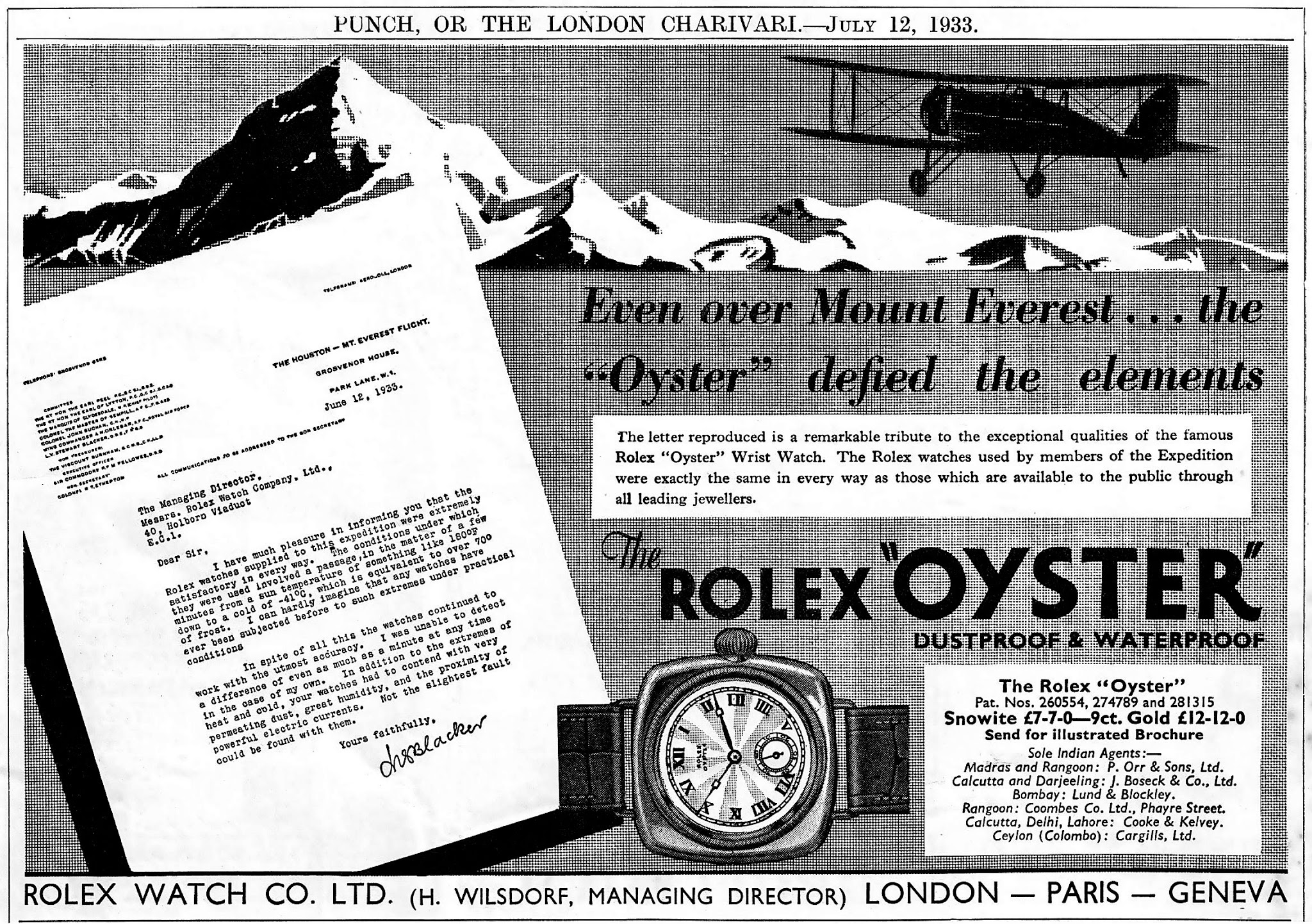

Lord Clydesdale led the effort with Lt. Colonel Stewart Blacker flying alongside both outfitted with Rolex Perpetual Oysters. The photographs taken by the expedition later aided Sir. Edmund Hillary and Tenzing Norgay in their climb to the top of Everest, although Bonnett had hypoxia and lost consciousness after damaging his oxygen mask. For strategic purposes, the photographs were not released to the public until 1951, but the members of the expedition received a hero’s welcome when they returned home to England. Blacker later wrote a letter to Rolex in which he stated “I can hardly imagine that any watches have ever been subjected before to such extremes.”
After these early successes, Rolex actively embraced any opportunities they had to expand Hans Wilsdorf's "Living Laboratory'' philosophy which aimed to fine-tune, test, and showcase the outstanding technical abilities of the Oyster in varied challenges in sports, aviation, and motor racing. One of the strongest testimonials on behalf of the Rolex Oyster came from Sir Malcolm Campbell - a former pilot in the RAF during World War I - when he set the 300-mph world land speed record. After his record-setting run, he penned a congratulatory letter to Wilsdorf and Rolex saying:
“I have now been using my Rolex watch for a while, and it is keeping perfect time under somewhat strenuous conditions.”
Campbell wore his Rolex watch during a number of exhilarating speed triumphs including in September of 1935 when he set a land speed record of over 300 miles per hour at the Bonneville Salt Flats in Utah. He continued to break the world speed record nine more times between 1924 and 1935 including five times at Florida's Daytona Beach on the famous 23-mile-long white sand Ormond-Daytona oceanfront. On the final run on the 500-foot-wide Daytona course later in 1935, Campbell drove his Bluebird V racecar (named after the play “L’Oiseau Bleu” by Belgian playwright Maurice Maeternick) to a record speed of 276.82 mph.
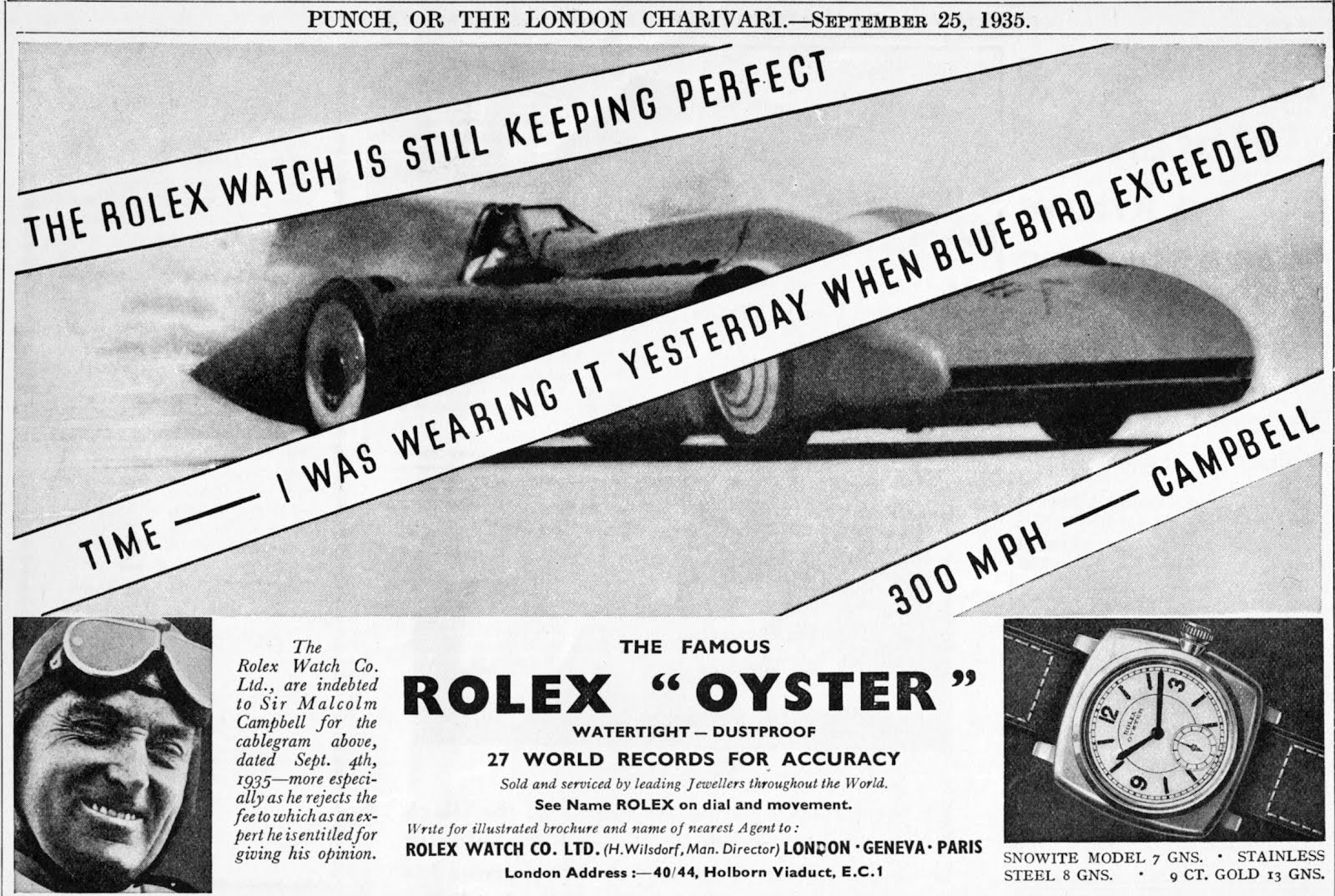

In 1937, in his hydroplane - of course also named Bluebird - Campbell set the international water-speed record of 129.5 mph. He went on to pilot another Bluebird to 141.74 mph on a lake in Lincolnshire in England and in each of those events, he wore a Rolex Perpetual Oyster on his wrist. Rolex went on to issue a special version of the model in his honor with his name printed on the dial in 1935.
During WWII, Hans Wilsdorf generously continued to send Rolex watches to allied prisoners of war held in camps in Germany. One noteworthy incident involved John Francis “Jack” Williams. Williams had ordered his Rolex “Monoblocco” (made from a one-piece case) from the German camp Stalag Luft III in 1942. Rolex was openly sending watches free of charge to Allied prisoners on the “Honor System,” not demanding any payment until the war was over as Hans Wilsdorf was completely confident that the allies would beat Hitler.
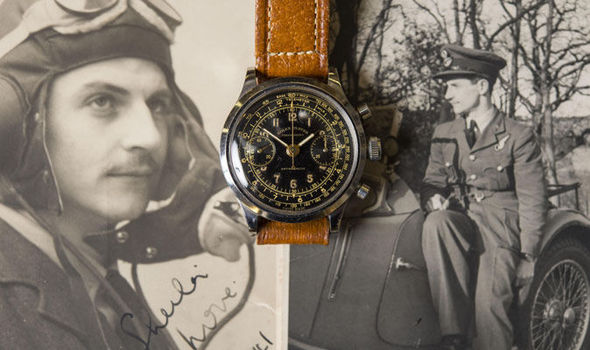
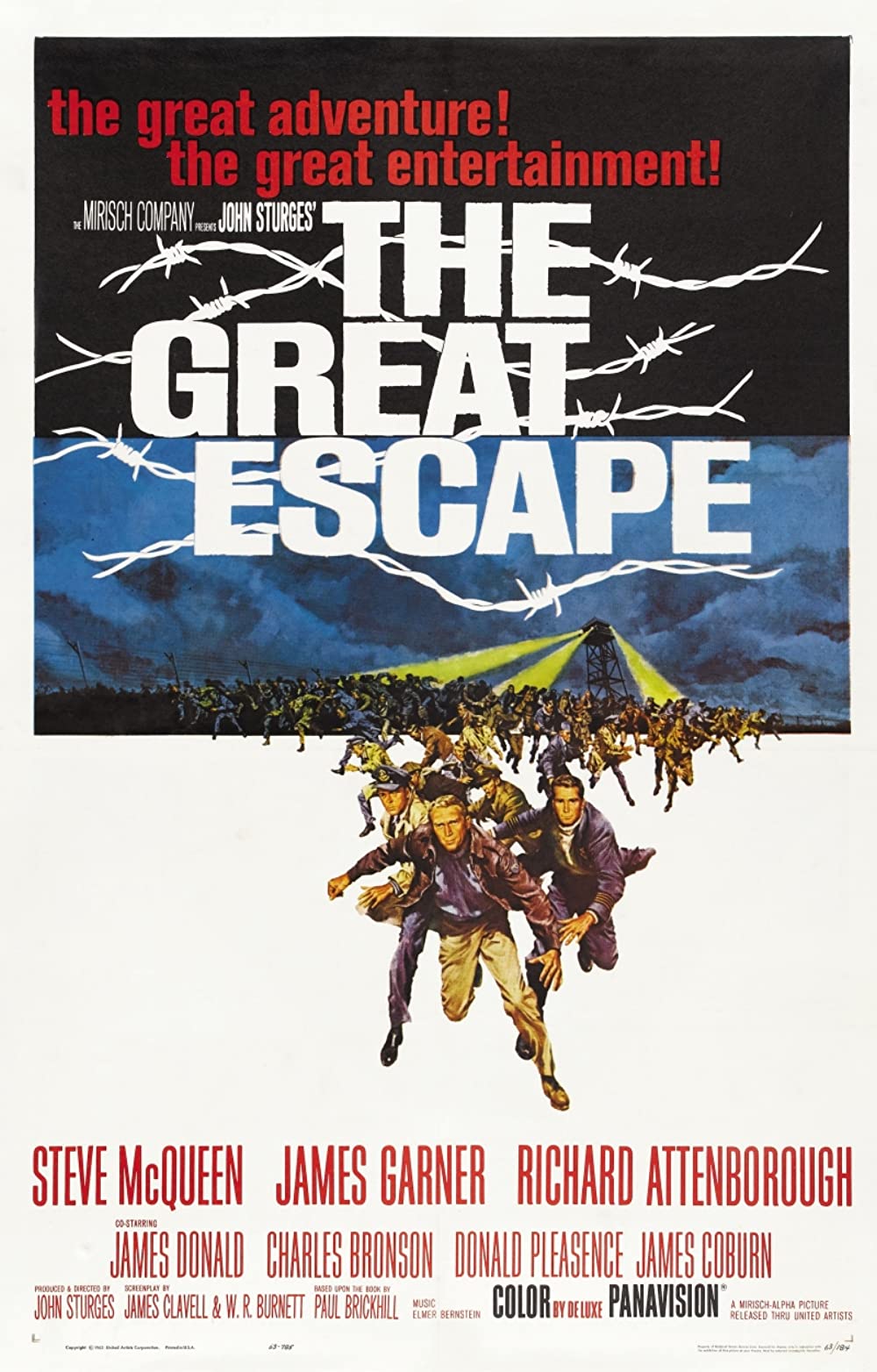
It often took up to 15 months and several attempts to get a watch to a prisoner and Wilsdorf's relentless employees followed the deliveries with personal letters signed by him. Jack Williams was one of 200 prisoners who attempted to tunnel out of their prison camp, an event immortalized in the 1963 film "The Great Escape" starring Steve McQueen. 76 men escaped but were re-captured, and Hitler ordered the execution of 50, violating the Geneva Convention. Jack was executed on April 6, 1944, and his Rolex was returned to his family after the war by a fellow British prisoner. This magnanimous gesture by Hans Wilsdorf and Rolex is a testament to their humanitarian character and philosophy.
Rolex continued to push the development of the wristwatch forward in 1945 with the introduction of the original Datejust, a self-winding chronometer that exhibited the date on the dial. It had a “Jubilee” bracelet that was part bead and part link, named for the company’s 40th "Jubilee" Anniversary. The Datejust was given a distinctive fluted bezel, a feature that became a familiar hallmark for Rolex and the epitome of the Oyster line. Instantly knowing the date of the month soon proved invaluable and became a feature that the public couldn’t live without.
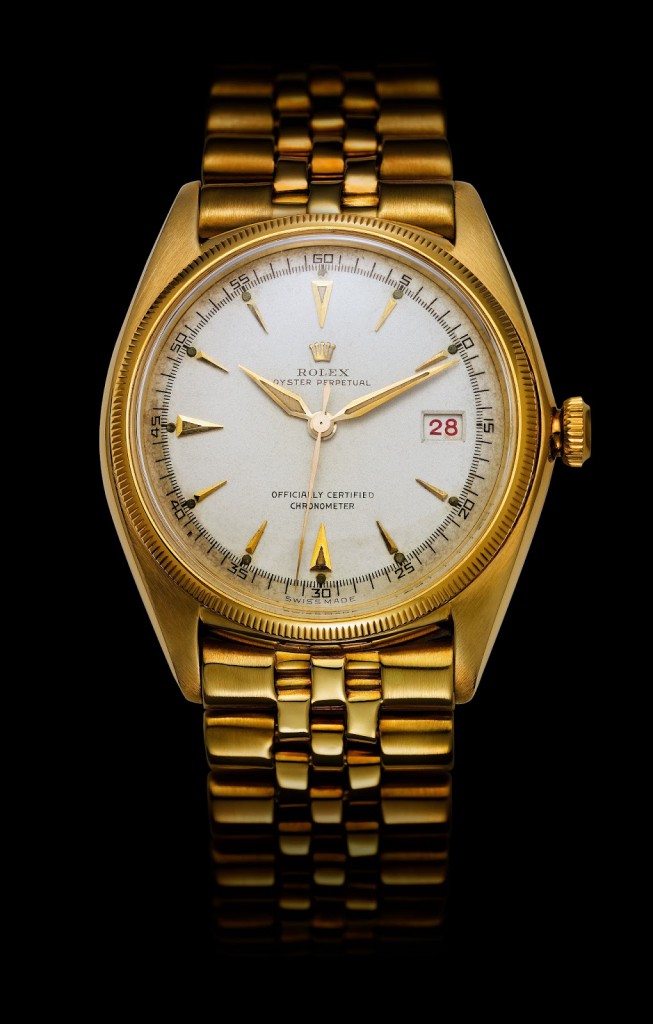
In May of 1953, members of Sir John Hunt’s indomitable expedition to the top of Mt. Everest, the world’s tallest mountain, were equipped with Rolex ref. 6098 Oyster Perpetual "Bubblebacks” which came with a domed Ovettone caseback to accommodate the hefty A296 movement. The watches were strapped to Sir Edmund Hillary and climbing partner Tenzing Norgay’s wrists as they made the first ascent of the highly dangerous mountain and helped further the brand’s reputation for performance and reliability under the most extreme of circumstances.


THE INTREPID EXPLORER
In 1953, Rolex celebrated the conquest of Everest and the inclusion of the Oyster Perpetuals in the ascent, by introducing the Oyster Perpetual Explorer. The iconic timepiece came to be an essential piece of kit for climbers, cavers, trekkers, and sportsmen who required an accurate and reliable record of real time anywhere they went. It was a pioneering wristwatch for true explorers - not just the desktop variety - with the durability and accuracy required to win the day in any challenge.

Even though Rolex had registered a trademark for "Explorer" months before Hillary and Norgay had summited Everest in 1953, they added the name to the model 6150 and its "precision-rated" relative, the ref. 6350. The 6350 differed in that it had an Official Certified Superlative Chronometer (COSC) rating. Both models had feuille leaf hands, gilt dials, and the same general aesthetic, but it was the 6350 that was the first to be called "Explorer".
The Oyster Perpetual Explorer featured the bubbleback, three-piece Ovettone case, a new dial with an inverted triangle at 12 o'clock, and gilt printed Rolex text and coronet. The Explorer also boasted luminous gilt numerals at 3, 6, and 9 o'clock, and iconic "Mercedes" style Rolex hour and minute hands.
1956 - A second generation of Explorer, the ref. 6610, was released with the new caliber 1030 movement that was thinner and allowed for a flatter case. This ultimately became the new standard. The dials were lacquered glossy black with gilt (gold) text relief printed using the galvanic process so that the brass of the base plate showed through
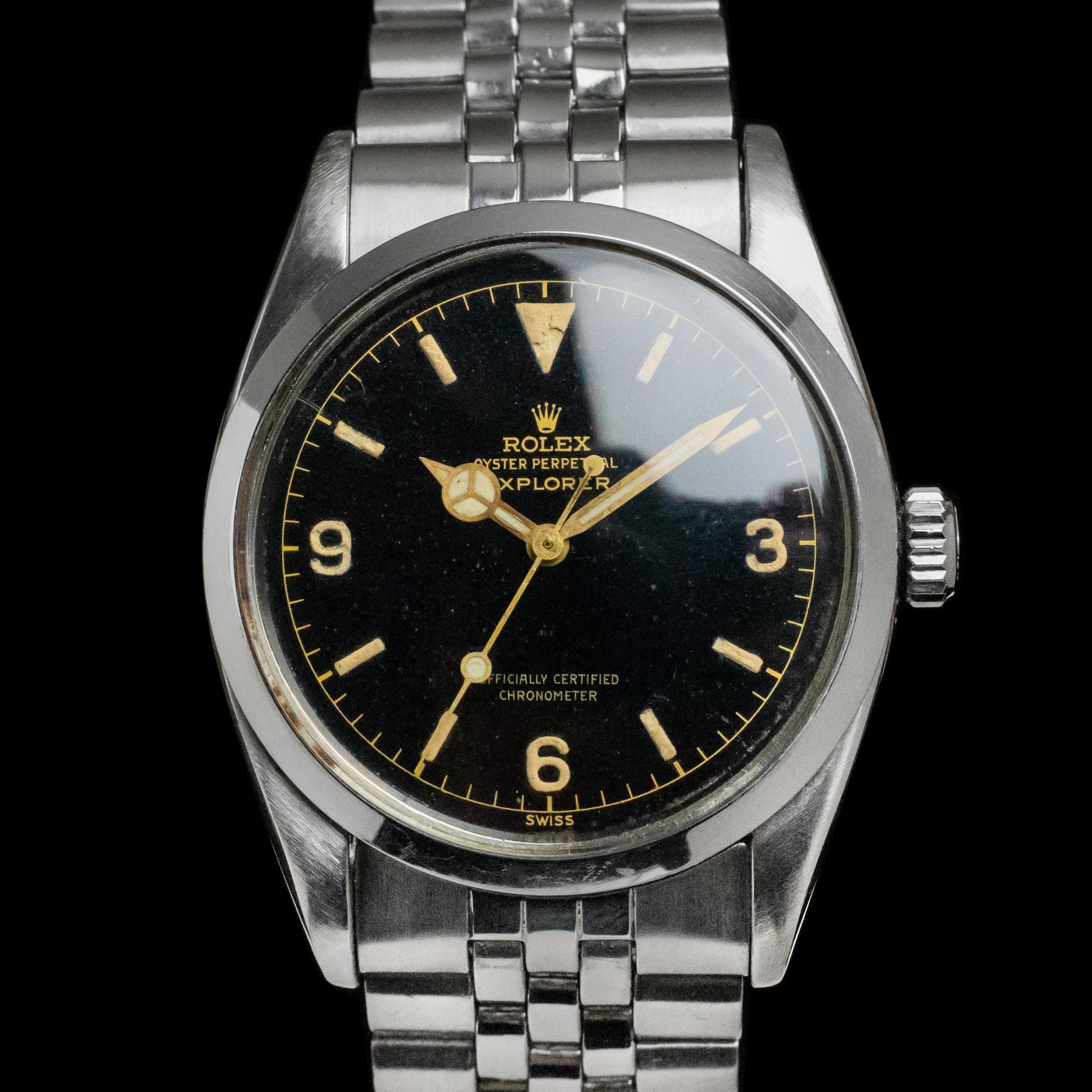
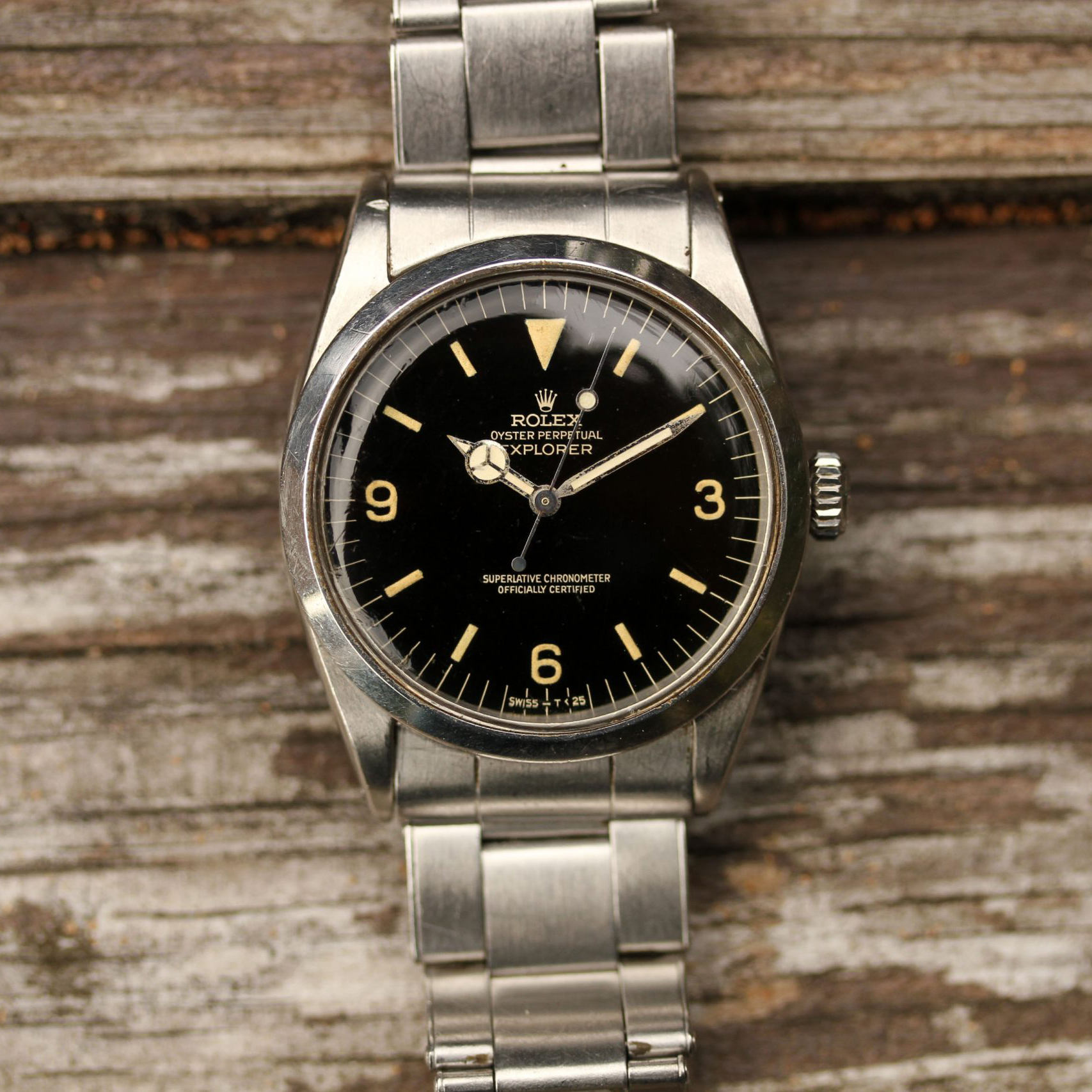
1963 - Rolex unveiled the ref. 1016 Explorer, one of the world's iconic and longest-produced sports watches. Rolex manufactured the ref. 1016 Explorer until 1989, with only minor detail changes over those years. The model initially featured the chronometer-rated caliber 1560 movement, which was upgraded to the caliber 1570 ten years later which added a stop seconds function. The Explorer ref. 1016 had an improved depth rating of 100 meters.
Rolex also took safety into consideration with the Explorer 1016. The radium long-used to create the luminous glow of hands and dial markers had been found to cause cancer and the company moved to use the safer alternative of tritium. Explorers with tritium lume were marked at the bottom of the dial with "SWISS T25" or "T-SWISS-T”.
Late 1960s - Rolex transitioned to matte black instead of glossy dials. Additionally, text was printed onto the dial instead of using the gilt galvanic technique.
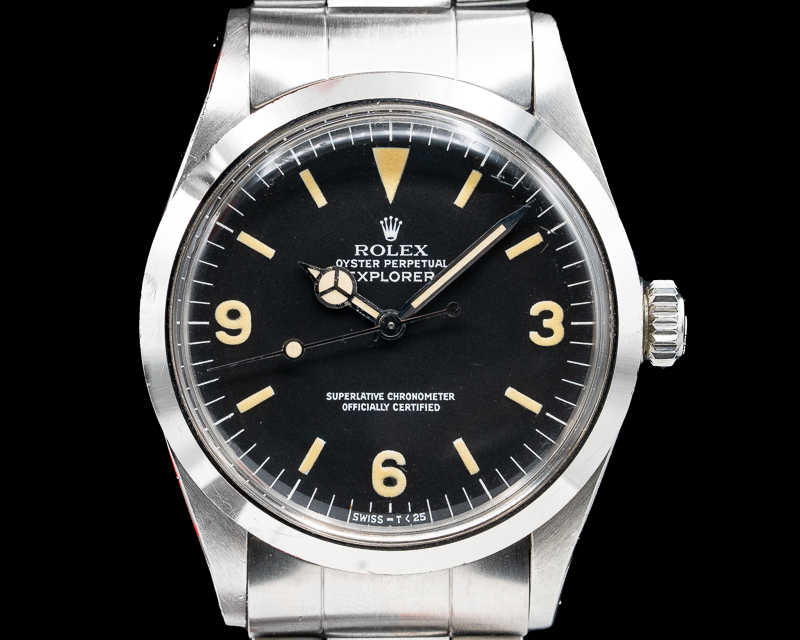

1971 - The ref. 1655 Explorer II was released. Features included a metal bezel engraved with a 24-hour time scale and a bright orange second hour hand designed to be used by cave explorers to monitor daylight.
1985 - A new ref. 16550 Explorer II was released in a larger 40mm case. The model featured a sapphire crystal and new movement which allowed the second hour hand to be set independently of the main hour hand turning it into a true GMT. A variant with a white dial was also introduced, quickly earning the nickname of "Polar”.

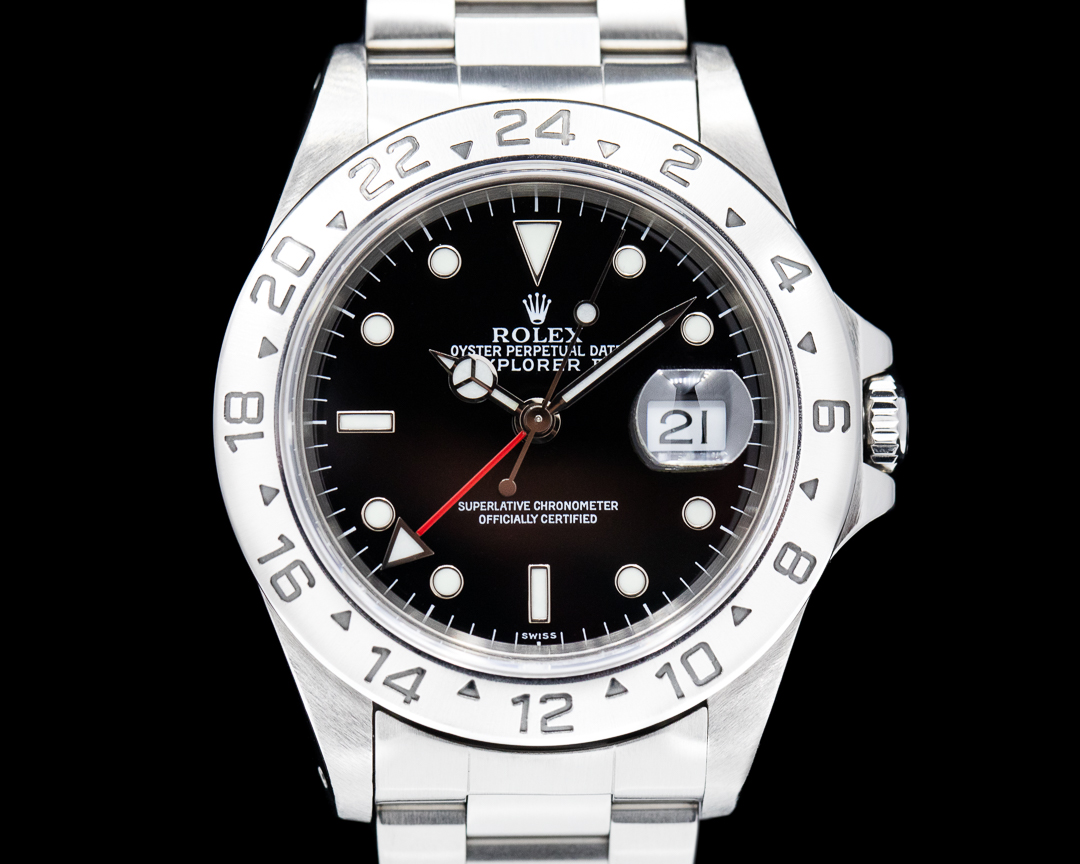
1989 - A slightly updated version of the Explorer II, the ref. 16570, was introduced. The model was powered by the new caliber 3185 (updated to the cal. 3186 later in the production run) and the hour marker surrounds were updated from the white gold of the 16550 to contrasting black, giving the watch a completely different look and feel.
1989 - The Explorer 14270 debuted in an all-new 36mm case and powered by a new caliber 3000 movement. Scratch-resistant sapphire glass crystals replaced the acrylic of the earlier ref. 1016 and it kept the 3-6-9 layout but replaced the painted numerals with white gold Arabic markers filled first with tritium and then LumiNova later in the 1990’s.
Rolex successfully produced the 14270 for almost a decade until 1999 with a number of sub-variants populating the line during this time:
1989-1991 - The “E” series ref. 14270 Explorer had drilled lugs and used black lacquer fill in the 3, 6, and 9 hour indices instead of tritium. Consumers disliked the black numerals and Rolex quickly reverted back to all-luminous markers. Watches with the black lacquer fill, now known as "Blackout" Explorers, are now some of the rarest modern Rolex watches.
1991-1998 - The longest running variant of the 14270, the “T-Swiss” model featured fully luminous tritium hands and indices. The model had fully-drilled lugs from 1991 to 1994 and plain, undrilled lugs from 1994 to 1998.
1998-1999 - The final "Swiss Only" variant reflected a shift from tritium lume to non-radioactive LumiNova.


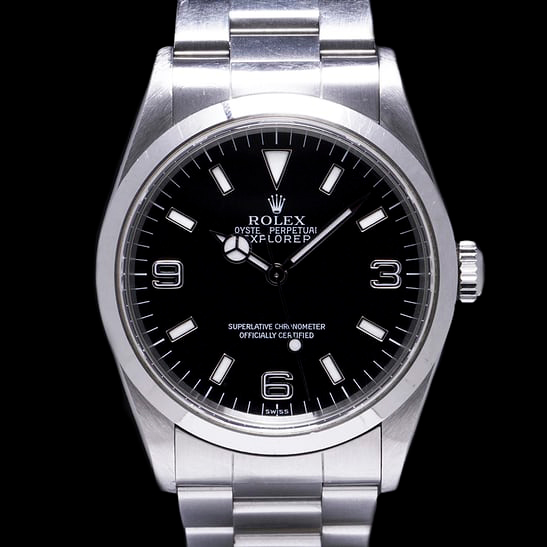
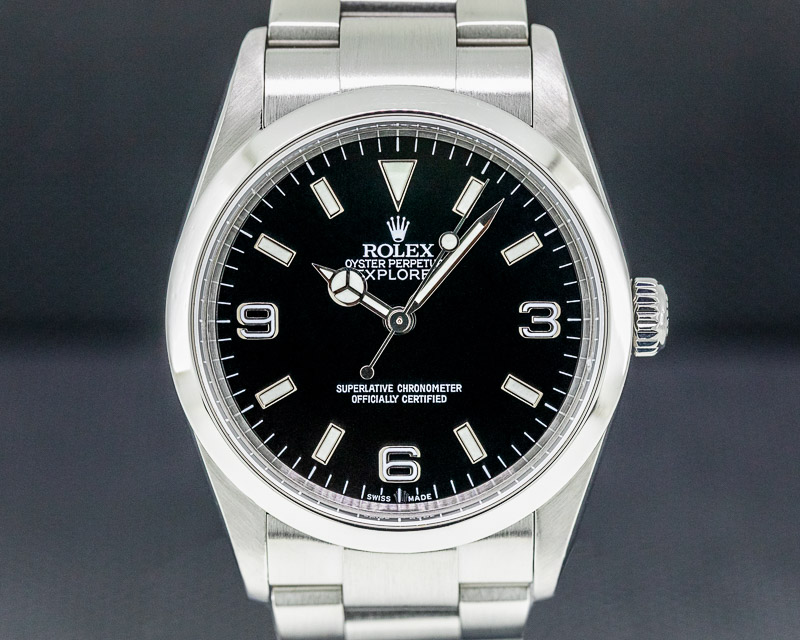
2001 - The Explorer 114270 was introduced with a 36mm case, second generation 3000 series movement, the caliber 3130, Super-LumiNova filled hands and indices, and solid endlinks. The model remained virtually unchanged until it ended production in 2010.
2010 - At the annual Baselworld exhibition, Rolex introduced an all-new ref. 214270 featuring a larger 39mm case which was now nearly as big as a Submariner (the first Explorer was a diminutive 34.5mm) and the new caliber 3132 movement. The name “EXPLORER” was also moved from the top of the dial to the lower half. This version of the Explorer was produced in two different variants:
2010-2016: The Mark 1 featured solid white gold 3, 6, and 9 indices and a relatively short hand-set in comparison to the models increased case/dial size.
2016-2021: The Mark 2 switched from the solid 3, 6, and 9 indices to updated luminous numerals and the handset was also redesigned to better fit the dial.
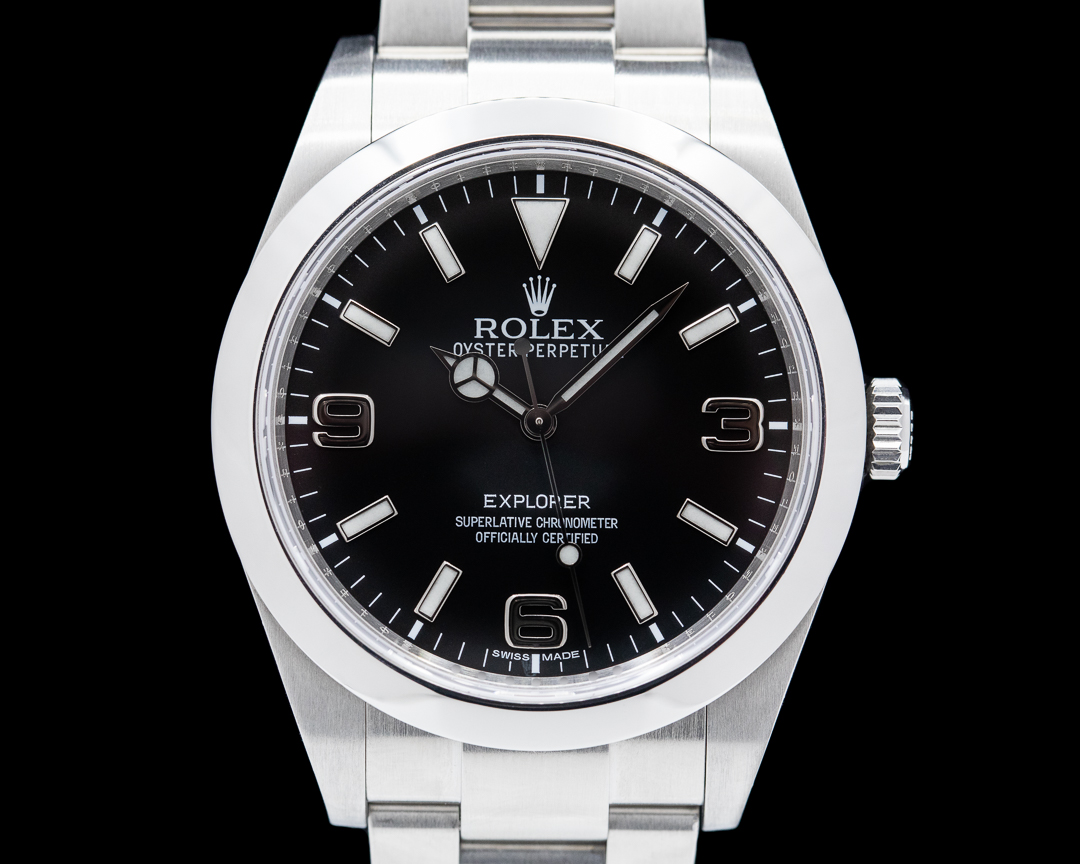

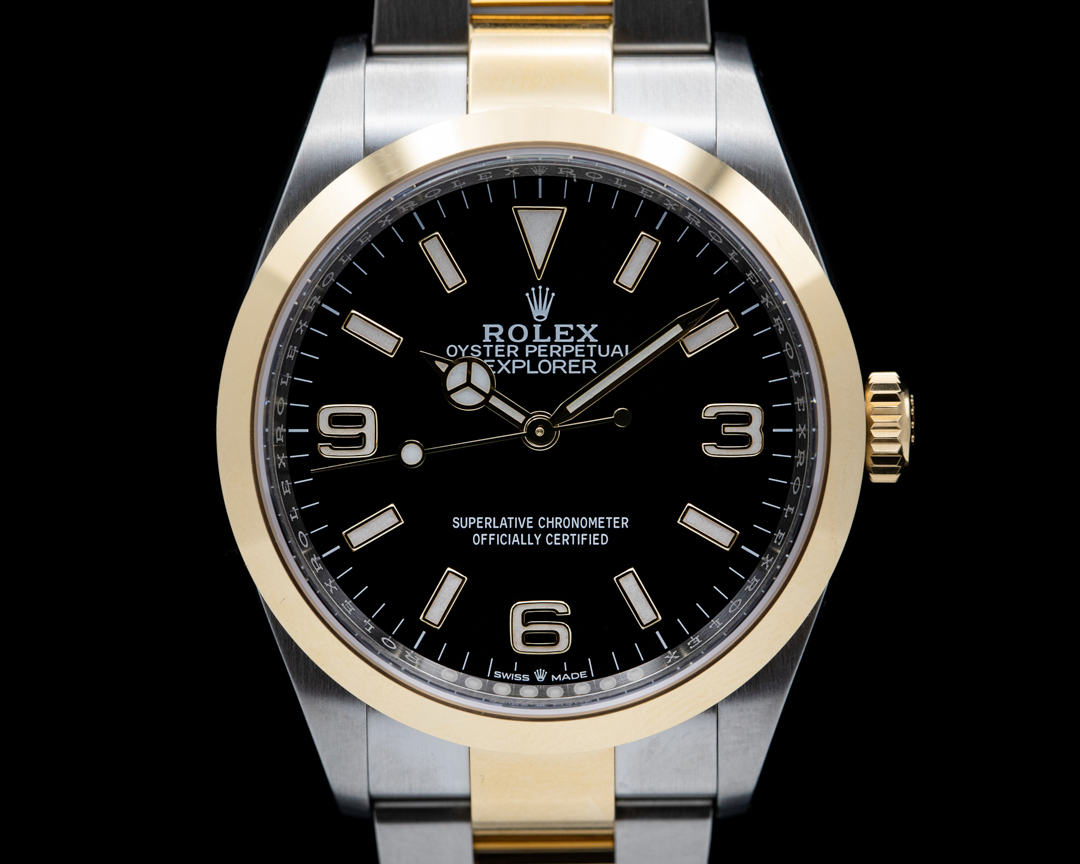
2021 - With the introduction of the latest ref. 124270 Explorer Rolex returned the model to its traditional 36mm case size and now offers the watch in stainless-steel, and a two-tone steel and 18k “Rolesor” yellow gold version (ref. 124273). The model employs the new Rolex caliber 3230 and uses the classic Explorer aesthetic of applied Arabic numerals at 3, 6, and 9 o'clock and baton hour indices filled with the newest Chromalight lume.
THE SUBMARINER
1953 was a landmark year for Rolex. At the same time that they were conquering Everet and introducing the Explorer, they were also turning their attention to the seas. The concept for the original Submariner belonged to the company's Public Relations Director, René-Paul Jeanneret. He was a dedicated SCUBA diver who deserves credit for the "tool watch" philosophy that made the Submariner a true revolution when Rolex introduced the first dive watch resistant to 100 meters.
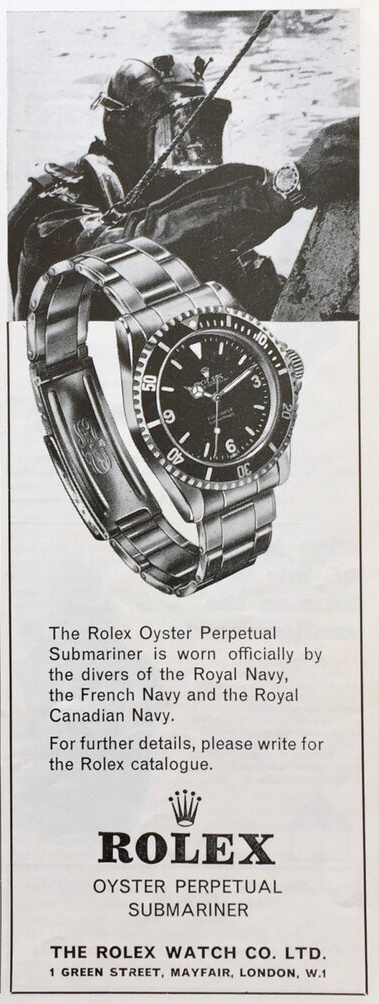
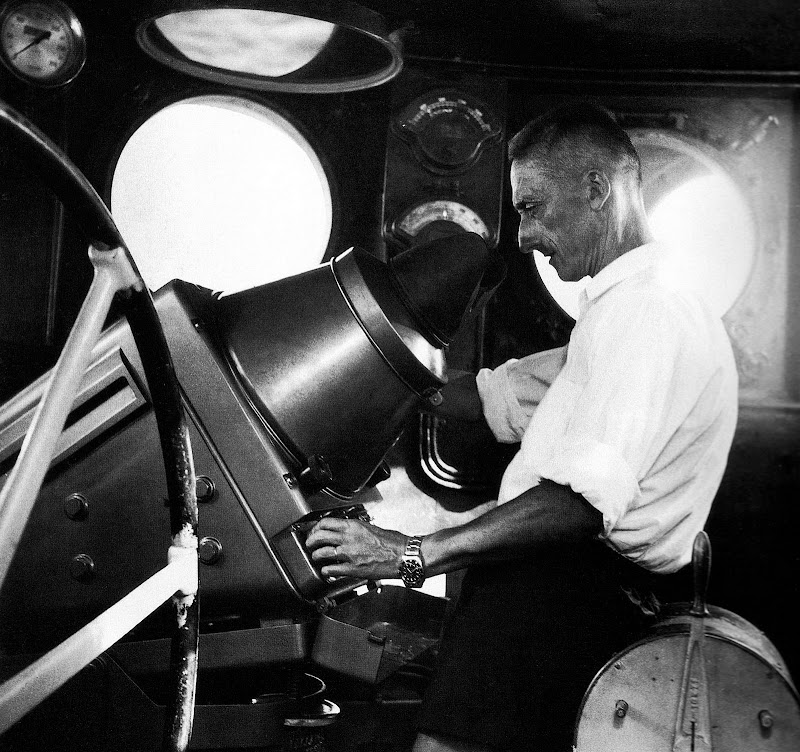
With SCUBA diving quickly becoming the international adventure sport of choice and the recognition of post-war undersea pioneers like Jacques Cousteau, the company debuted the ref. 6204 Submariner. Equipped with a rotating graduated 60-minute bezel, it helped make underwater exploration safer by enabling divers to easily keep track of immersion times and avoid the dangers of decompression sickness.
The first Submariner featured a 37mm three-part stainless steel case with a graduated black bezel, small 5.3mm crown, black time-only dial with gilt printing, pencil hands, and a 100 meter depth rating . The model almost immediately became the standard for all underwater endeavors, but surprisingly, its greatest appeal was as an everyday watch, with a date model added to the line in 1969. Even though it was later produced in various precious metals, with colored accents and numerous horologic improvements, the fundamental Submariner design has remained quite the same, with the company making only small, useful technical alterations over the decades.
THE EVOLUTION OF THE SUBMARINER
1953 – The Submariner is born with the introduction of the ref. 6204. The model features a 37mm three-part steel case, graduated 60-minute black bezel, small 5.3mm crown, gilt dial with “Submariner” proudly printed above 6:00, luminous pencil hands with a running seconds hand with a lollipop indicator, caliber A260 movement, and a 100 meter depth rating.
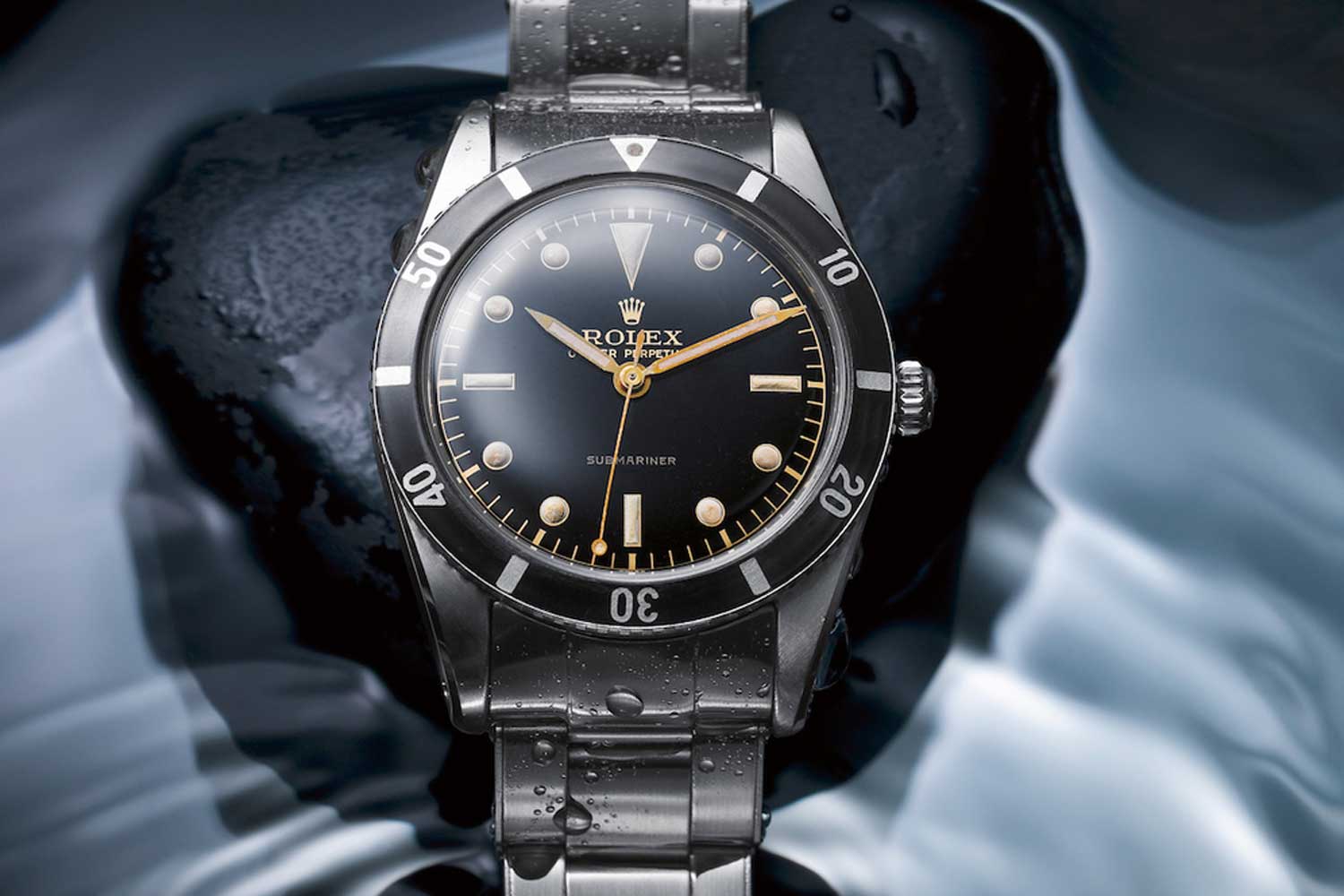
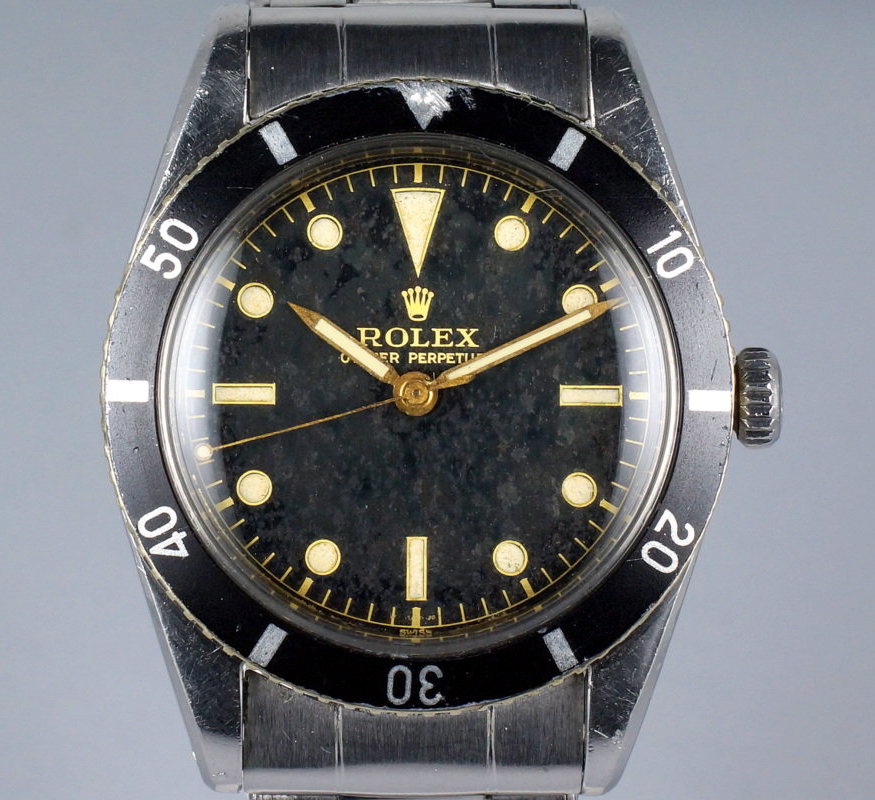
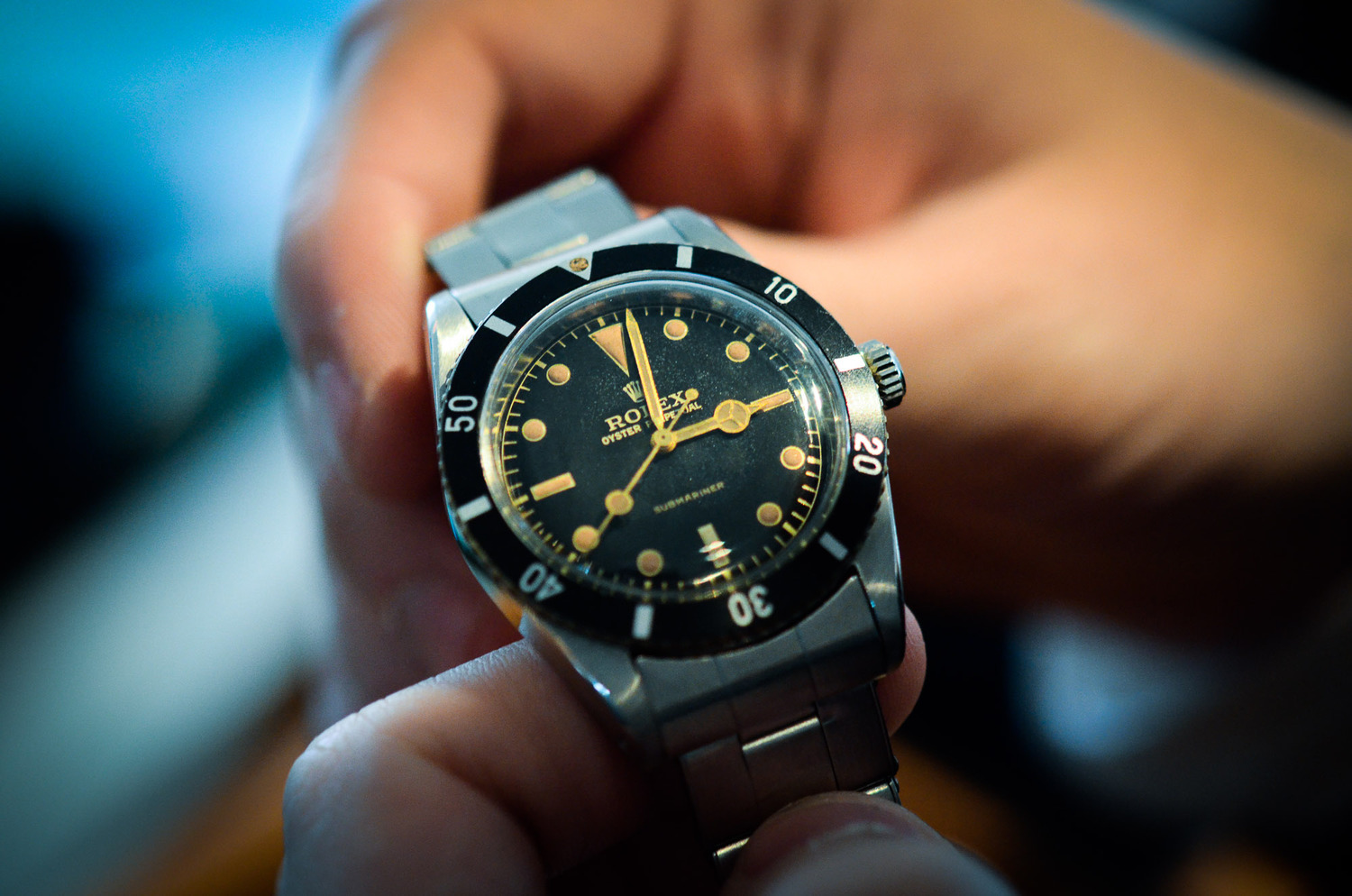
1954 - Two ref. 6205 Submariner variants were produced in the span of roughly 12 months in 1954:
Produced briefly in early 1954, the ref. 6205 “Clean Dial Sub”, is very similar to the original 6204, but for some unknown reason Rolex chose to remove the “Submariner” signature from the dial. The case was slightly thicker than the 6204 and the crown size was increased from 5.3 to 6mm.
Later in the year, another variant of the ref. 6205 was produced with the “Submariner” signature back on the dial above 6:00 and with the addition of now-iconic Mercedes hands.
1955 - The ref. 6200 “Explorer Dial” Submariner earned its nickname due to its dial which features luminous radium 3, 6, and 9 numerals similar to the Explorer model. This reference received an updated cal. A296 movement and was also the first Sub to utilize the famed 8mm Brevet “Big Crown” which helped achieve an upgraded depth rating of 200 meters. Two different variants of the 6200 were produced - one with a small Rolex logo at 12 o’clock and no “Submariner” signature at 6, and the other with a large Rolex logo and “Submariner” signature.

1956 - The ref. 6536/1 Submariner featured the smaller 6mm crown of the earlier 6205 and was only rated to a depth of 100 meters. Like earlier references, the 6536 had a gilt dial with chapter ring, radium lume, but was powered by a caliber 1030 movement and now had a shorter set of Mercedes hands with an all-white white seconds hand for increased visibility.
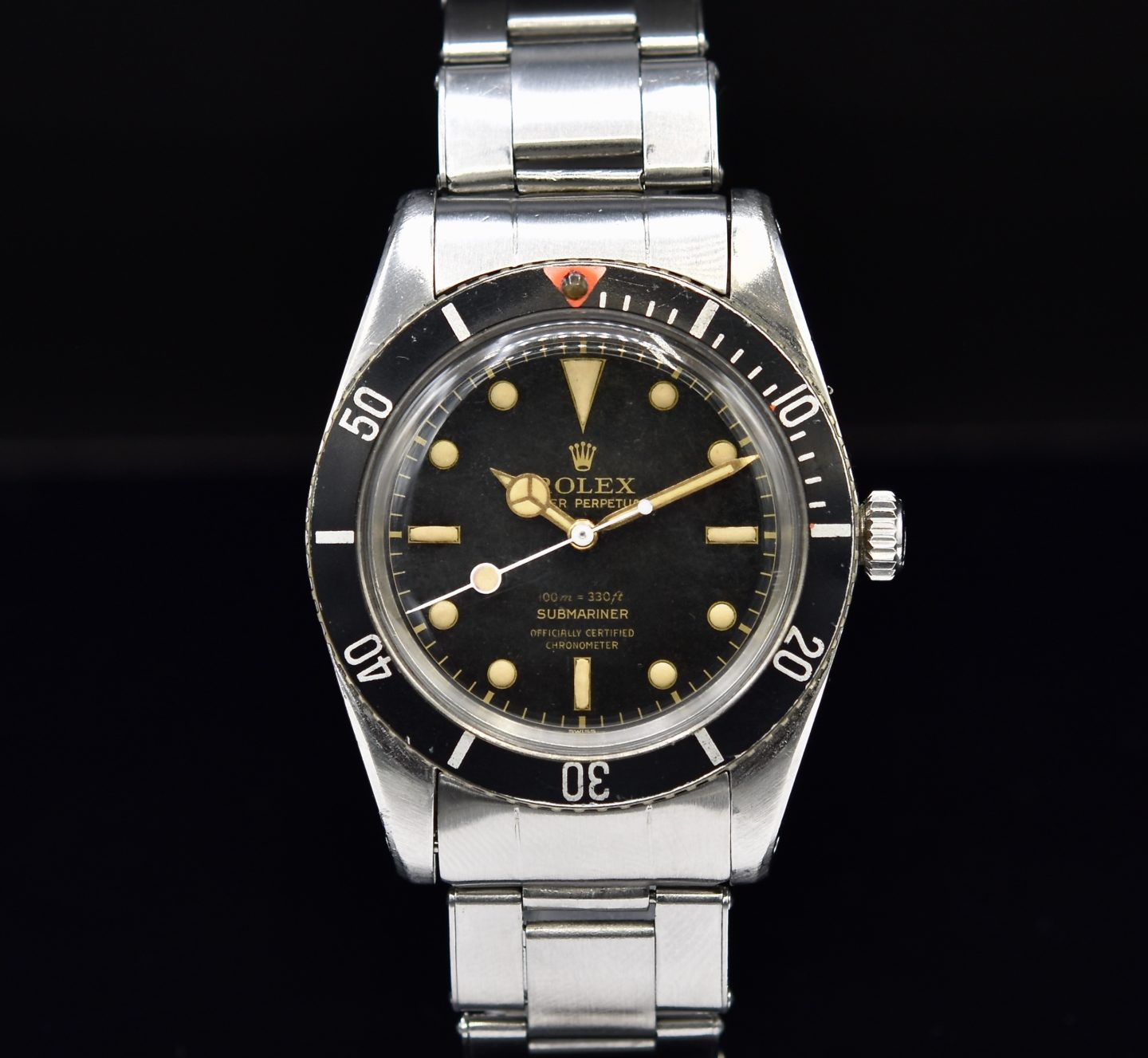
Two additional variants of the 6536/1 were produced, the first being extremely similar to the original model except for the addition of a new style bezel with the iconic inverted red triangle at 12 o’clock. The second version features a few additional tweaks to the design including a brass seconds hand and hash marks between the “0” and “15” marks on the bezel.
1956 - At the same time that the 6536/1 was being manufactured and sold, Rolex also produced what many consider to be THE vintage Submariner, the ref. 6538 “Big Crown”. The distinguishing feature of this model is the oversized 8mm Brevet crown that gave the watch its nickname. Over the years, two different dials were used - the “4 Line” which lists a depth rating, “Submariner” signature, and the “Officially Certified Chronometer” designation, and the “2 Line” which lists just the depth rating and “Submariner” signature.


1958 - Also produced at the same time as a few other earlier references, the ref. 5510 was the last of the “Big Crown” Submariners. Featuring the 8mm Brevet crown, this reference was powered by the new caliber 1530 movement.
1958 - The Ref. 5508 also released in 1958 featured a slimmer case and smaller crown giving the model a reduced, 100 meter depth rating. Initially, the model featured radium lume and bezel with the inverted red triangle but over the course of its 5-year run, Rolex transitioned to Tritium lume and a bezel with a silver inverted triangle instead of the red.
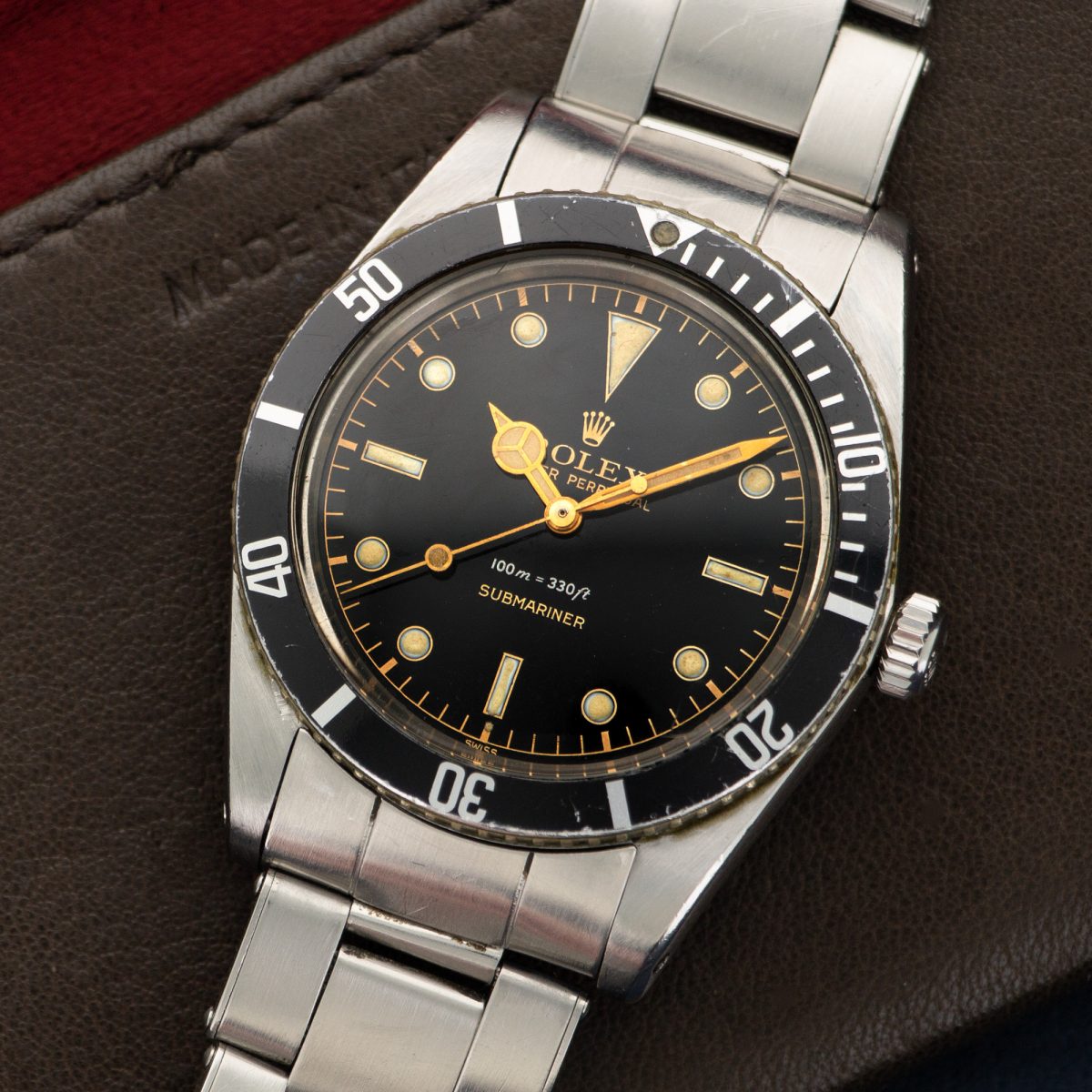
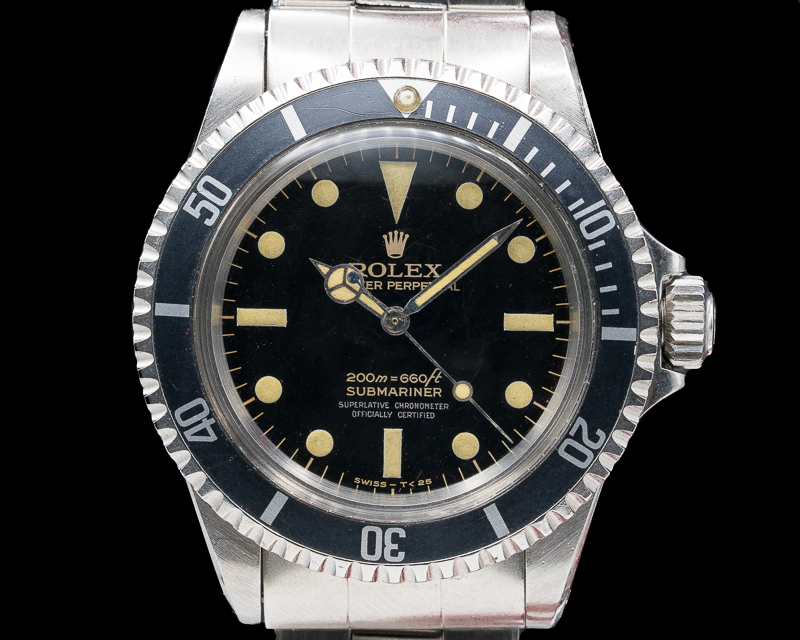
1959 – The ref. 5512 is introduced with a case featuring crown guards for the first time, increasing the overall size of the model to 40mm. The 5512 introduced many features that would become hallmarks of the Submariner line for decades including crown guards, beveled lugs, a 7mm crown, 200 meter depth rating, Mercedes hands, and graduated dive bezel. The 5512 was produced until 1980 with numerous variants over the years.
1962 - The ref. 5513 Submariner is introduced. Almost identical in every way to the 5512, the only difference can be found in the movement. In 1959, the 5512 received a chronometer rated movement and the classic “Superlative Chronometer Officially Certified” text on the dial. The 5513 was simply the non-chronometer-certified alternative to the 5512. The 5513 remained in production until 1989 with many notable variants produced over the course of its almost three decade run.

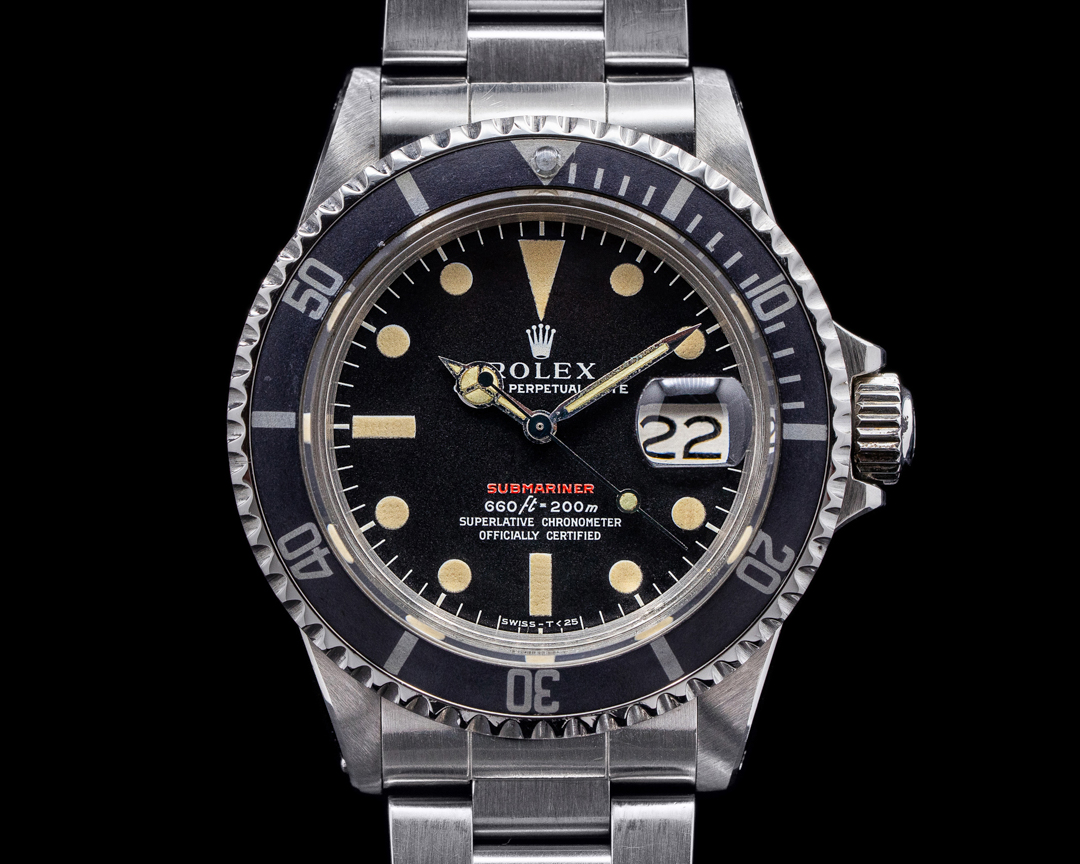
1967 – Dials are changed from gilt to matte across the entire Submariner line.
1969 – The ref. 1680 Submariner Date is introduced. The watch is powered by Rolex’s caliber 1575 movement and features the iconic “Cyclops” date magnifier in the crystal. For the first 4 years of production, the “Submariner” signature was written in red, a variant now famously known as the “Red Sub”. Also making its debut in 1969 was the first all gold Submariner, the ref. 1680/8.
1979 – The ref. 16800 is introduced. The new model is powered by Rolex’s cal. 3035 movement which was the company’s first high beat, oscillating at 28,800vph. The far more durable sapphire crystal also replaces the acrylic used previously.
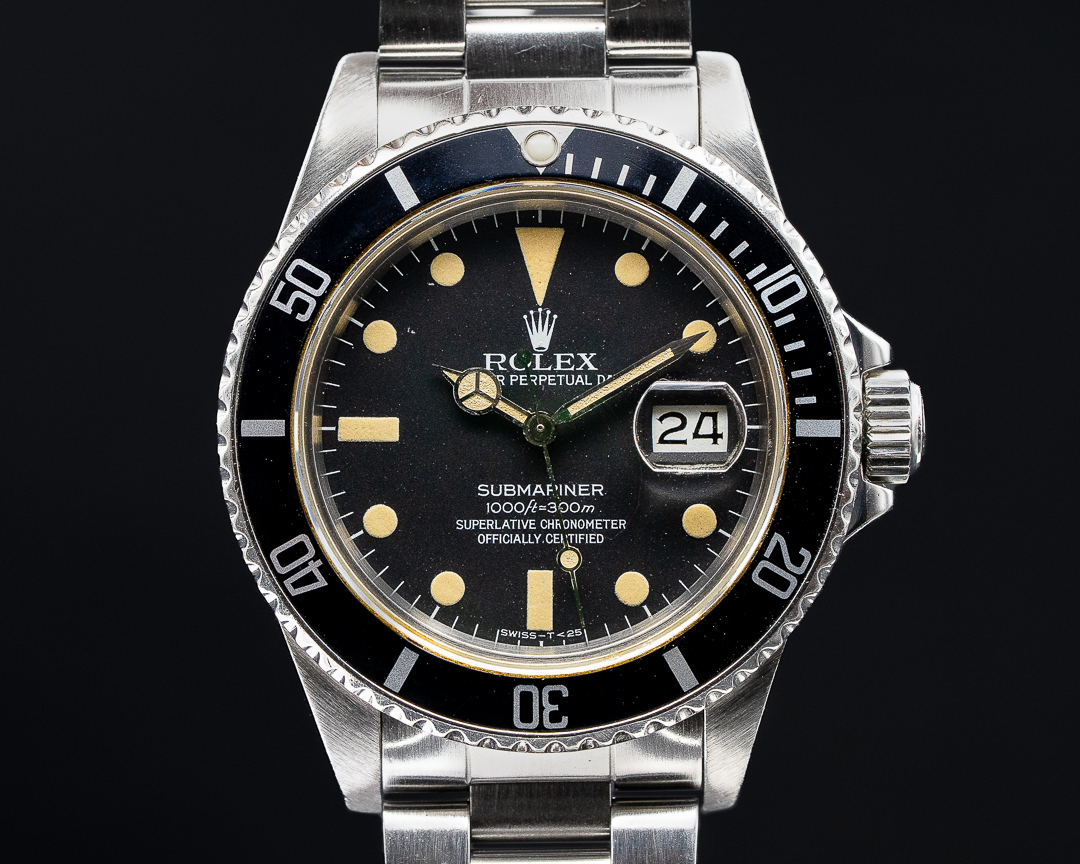
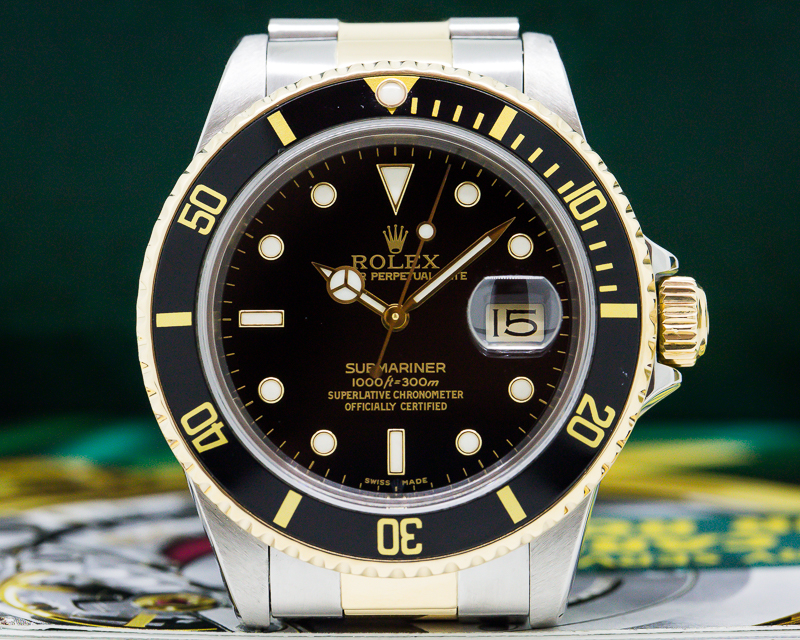
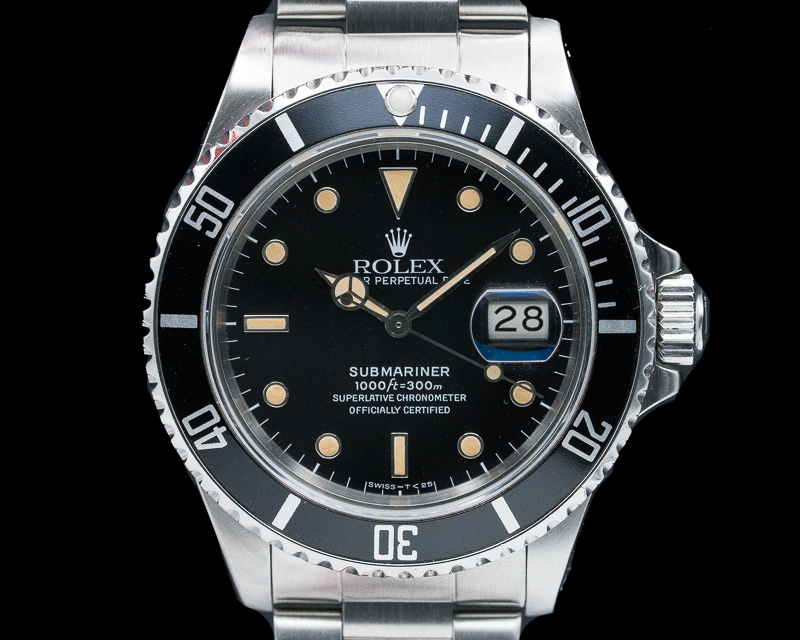
1984 – Gloss dials replace the matte versions, and white gold hour markers are added. The first two-tone gold and stainless steel Submariner, the ref. 16803, also appears.
1988 – Rolex begins using 904L stainless-steel for the Submariner ref. 168000.
1989 - The ref. 16610 debuts with a new cal. 3135 movement.
2003 – The ref. 16610LV 50th Anniversary Edition Submariner debuts with a green bezel earning it the nickname “Kermit”.
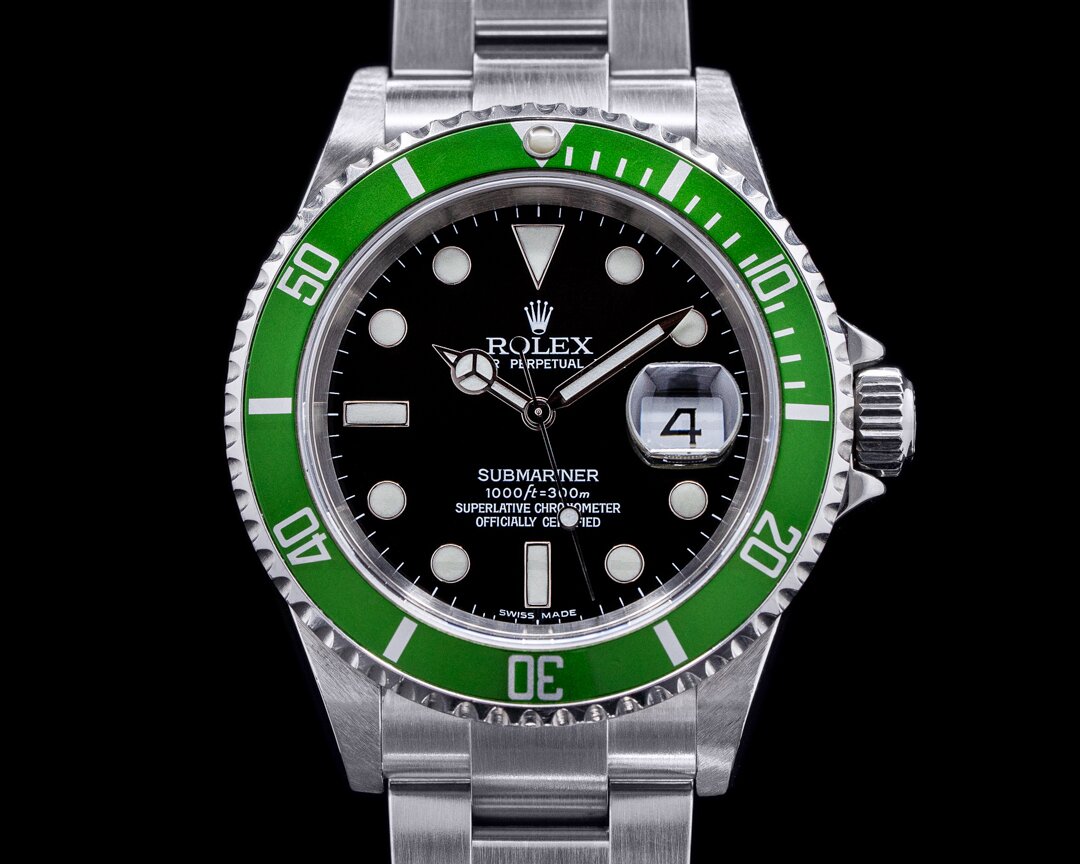

2008 - The first white gold Submariner, the ref. 116619, is introduced with a bright blue bezel and dial, quickly earning the “Smurf” nickname.
2010 – The “Super Case” is introduced to the Submariner line. This new case is still 40mm in diameter but has wider and thicker lugs, a wider bezel, and a thicker overall profile causing it to wear much larger on the wrist than previous generations. The Cerachrom bezel and the ref. 116610LV with green dial and bezel (aka the Hulk) also made their debut in 2010.
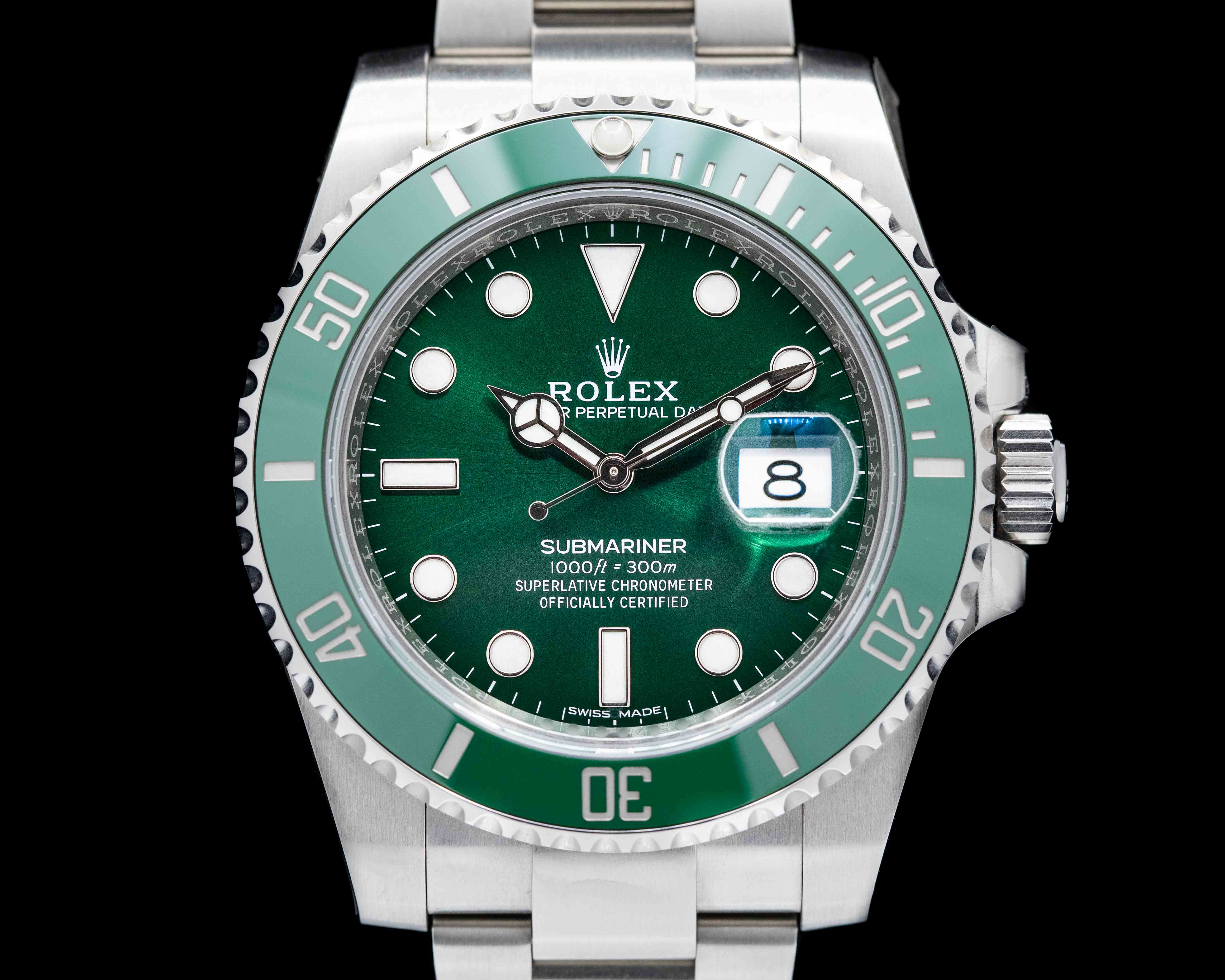

2020 – The ref. 126610LN is introduced featuring a case that has been increased to 41mm in diameter, a new lug design, the caliber 3235 movement, and a 21mm Oyster bracelet with a "glidelock" clasp.
THE INCOMPARABLE DAYTONA
Of every iconic model released since 1908, the Daytona chronograph is arguably Rolex’s crowning achievement. The brand had been experimenting with mechanical chronograph complications as far back as the 1930's, but it wasn’t until 1955 that the legendary Daytona began life as the ref. 6234 Oyster Cosmograph Chronograph.

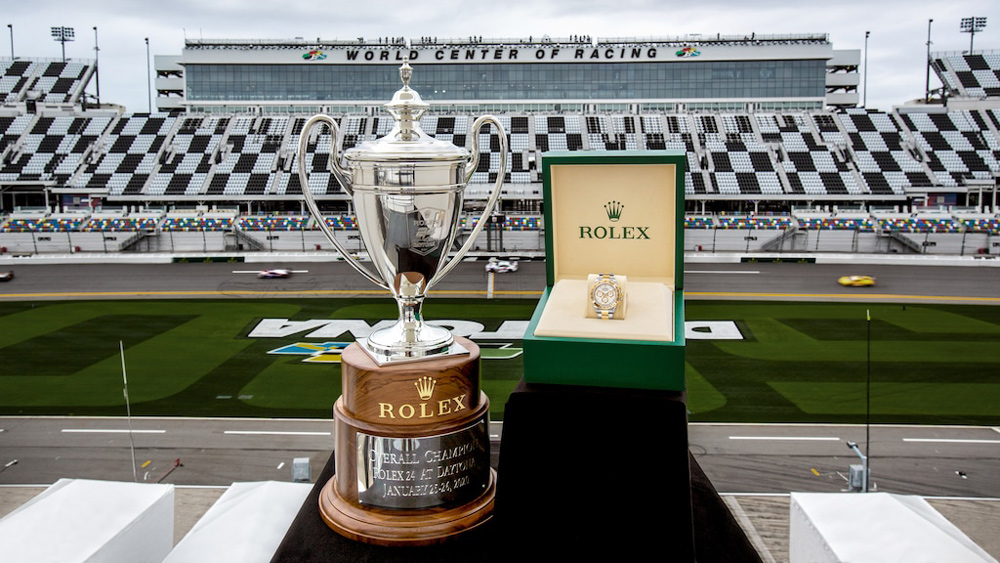
From 1904 to 1958, the famed racetrack at Daytona Beach, Florida played host to numerous international land speed records including five by Rolex testimonee Sir Malcolm Campbell. Drivers would start out on the pavement of highway A1A driving parallel to the ocean for roughly two miles before turning onto the beach itself and racing two miles on sand back to the starting line. Over time, the asphalt and sand course was slowly reclaimed by the ocean and a new “Super Speedway” amphitheater called the Daytona International Speedway was constructed in 1959. The Oyster Cosmograph Chronograph quickly became the standard for race timekeeping during this period and the Rolex name became synonymous with the Daytona Speedway where they were named the official timekeeper in 1962.
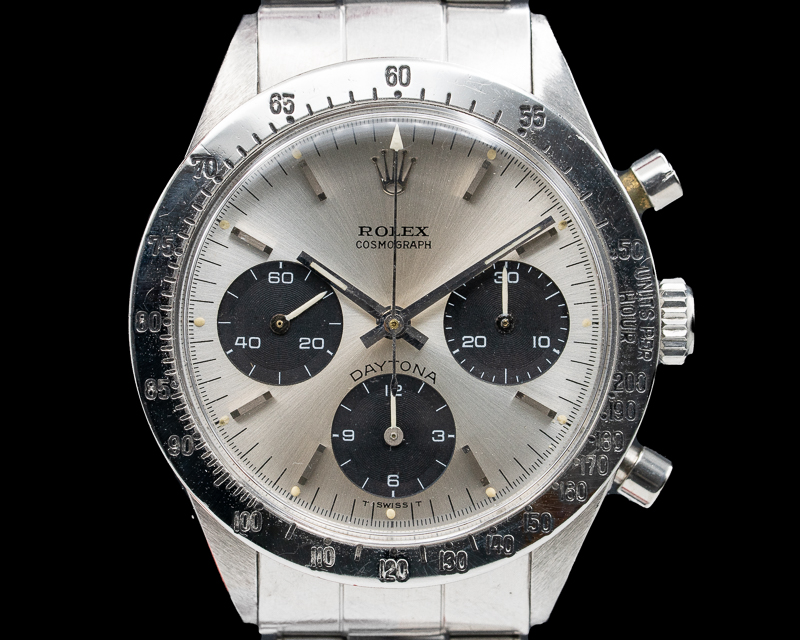
In 1963, in a world of astronauts and race cars, Rolex introduced the ref. 6239 with three Compax-configured subsidiary dials resembling the instruments on a race car's dashboard. For two years the model was known simply as the "Cosmograph," (text that is still found on Daytona dials to this day). Rolex even toyed with calling the model the “Le Mans” and it wasn't until 1965 that the legendary "Daytona" name actually appeared on the watches.
By 1969, thanks in part to some free advertising from popular Hollywood film actor and racing driver Paul Newman who wore the watch in his movie "Winning", the Daytona had built a reputation as a truly world-class chronograph. After years of being spotted on his wrist both on screen and off, the ref. 6239 came to be known as the "Paul Newman Daytona" (his first Daytona was a ref. 6263 but the actor was best known for wearing the 6239 which was a gift from his wife, actress Joanne Woodward).

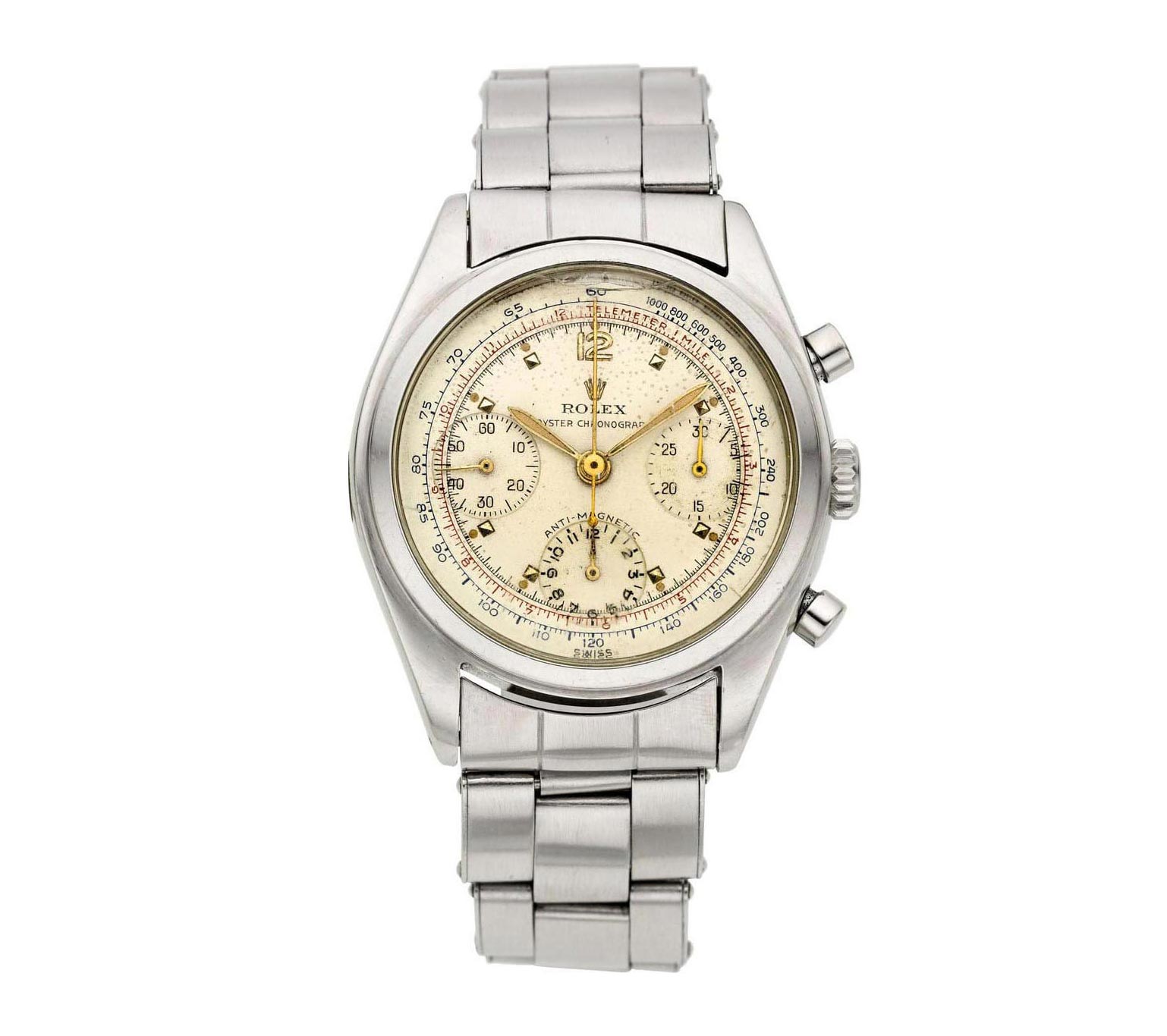
THE EVOLUTION OF THE DAYTONA
1950 - The first of what are now collectively known as the “Pre-Daytona” models, the ref. 6034, is released. Featuring a 36mm Oyster case with a screw-down crown and pump pushers, the watch was powered by a manually wound Valjoux 72 movement and used a multiscale dial with both tachymeter and telemeter scales.
1955 – The ref. 6234 Oyster Chronograph is released. Another precursor to the Daytona, this reference also featured a tachymeter and telemeter scale for distances (both on the dial) and three subsidiary chronograph dials without either of the words "Daytona," or "Cosmograph". The reference was produced for roughly six years in both steel and gold with slightly varying black and white dials.

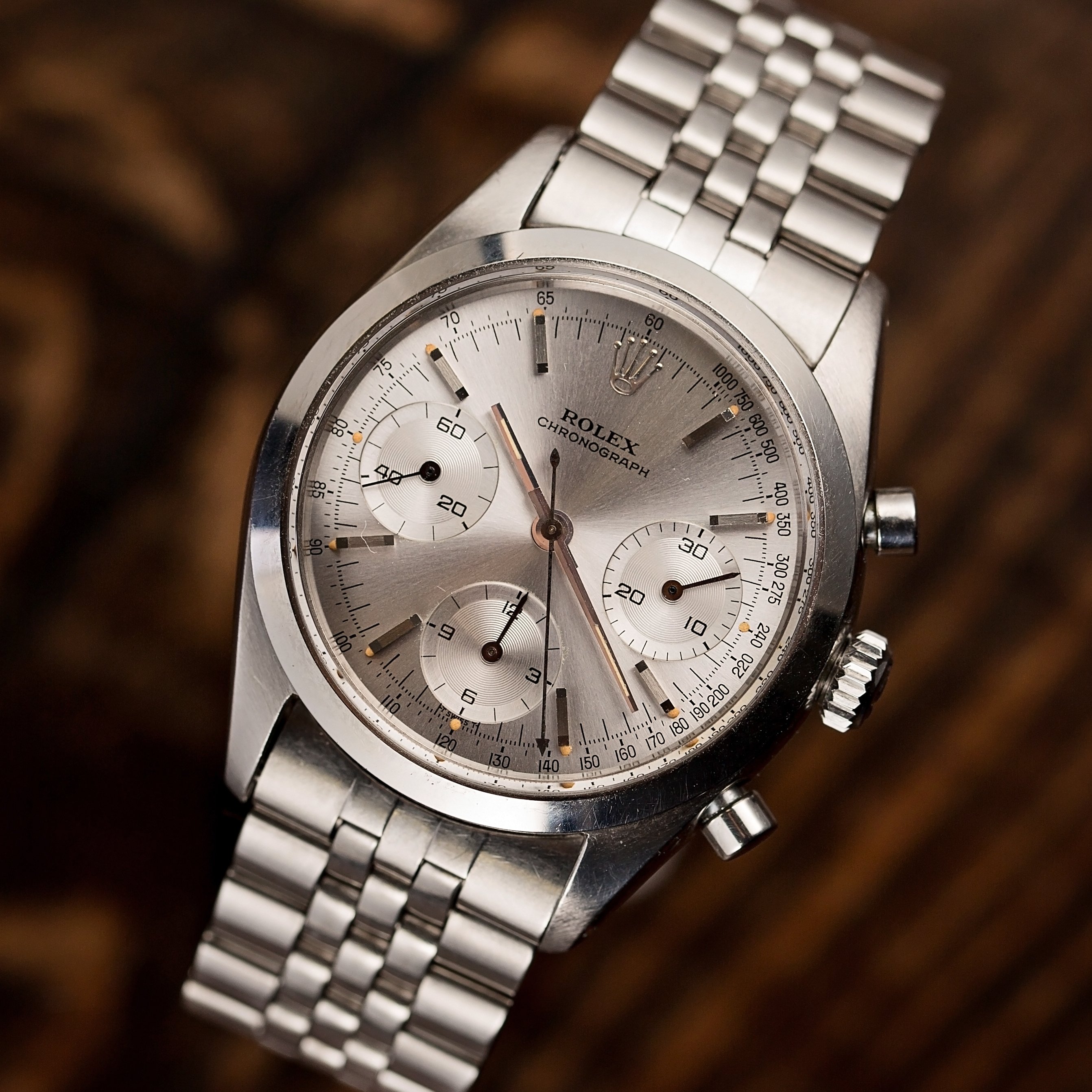
1961 - The last of the “Pre-Daytona” models, the ref. 6238 was introduced. Initially, the model was very similar to its predecessor with leaf hands, diamond hour indices, a multiscale dial, pump chrono pushers, and a Valjoux 72B movement. The second series, however, shifted the design in a sportier direction with straight hands, faceted baton indices, a single tachymeter scale on the dial, and a cal. 722 movement. The ref. 6238 was produced until 1967 or 1968 overlapping for several years with the first official “Daytona”, the ref. 6239.
1963 – A year after sponsoring the inaugural 24 Hours of Daytona race in 1962, Rolex introduced the ref. 6239 which was initially known simply as the "Cosmograph". The name "Le Mans" was also used in advertising materials for this model briefly. The major difference between the new ref. 6239 and the 6238 (which was still in production) was the tachymeter scale which was now engraved on the metal bezel instead of being printed on the dial. The 6239 was also the first Rolex to feature a two tone dial with two options available for sale - a silver dial with black chronograph subdials (known as a “panda dial”) or a black dial with silver subdials (now known as an “inverse panda”).

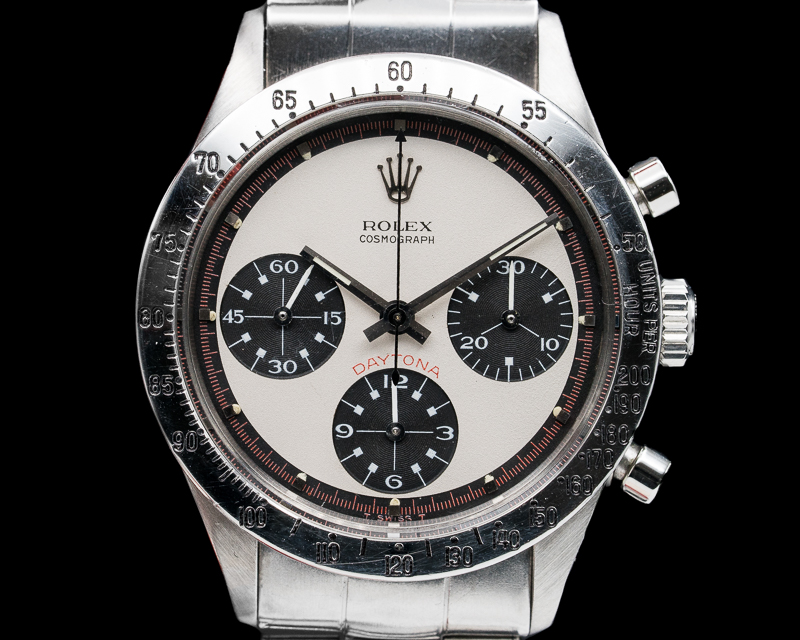
1965 - The name “Daytona” first appeared on the dial of the ref. 6239, printed underneath "Cosmograph” at 12:00. By 1967, however, the signature had moved to the top of the 6 o’clock sub-dial where it can still be found today. Frequently printed in red, it is now a Daytona tradition. The much lauded “exotic dial” was also introduced in 1965. This new dial featured three colors with either a white or black main dial, contrasting subdials and outer track, red accents, and a unique Art-Deco-style font. These exotic dial Daytonas (which can be found on several different references) are now commonly known as “Paul Newman Daytonas” due to their long association with the famous actor.
Also released in 1965, the ref. 6240 was the first Daytona to utilize screw down chronograph pushers. These new pushers were much more water resistant than the original pump-style and quickly became a permanent Daytona feature.

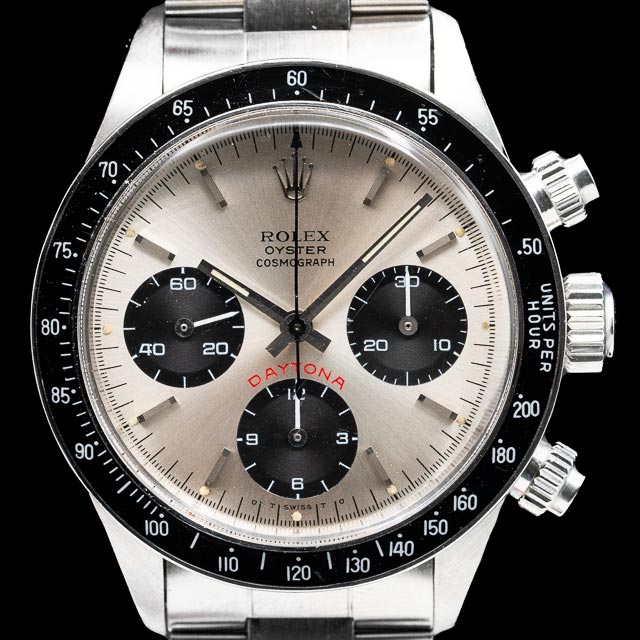
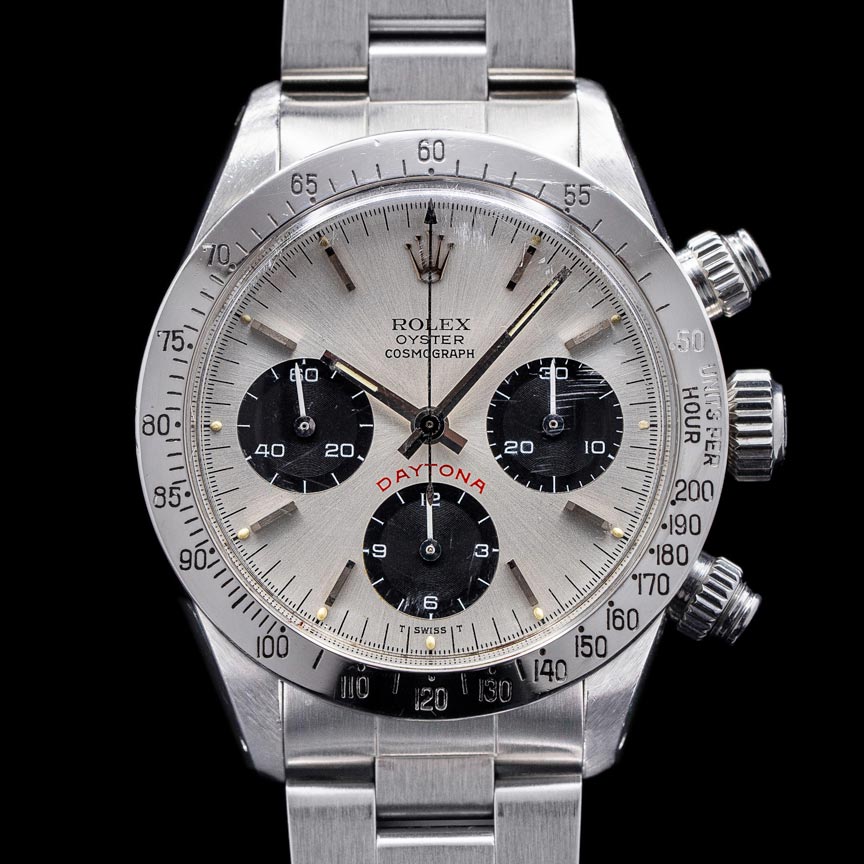
1969 – The ref. 6263 and 6265 Daytonas are introduced. Nearly identical, the only difference between the two models was the bezel - the 6263 had a black plastic bezel with white graduated markings and the 6265 had a solid metal bezel with black graduated markings. Produced concurrently until 1987, there are numerous variants from the nearly two decade run with the ref. 6263 “Big Red” being one of the most well known and desirable.
1988 – Rolex releases the first automatic Daytona, the ref. 16520. The Rolex caliber 4030 movement was created using the Zenith El Primero caliber 400 as a base. At the time, the Zenith movement was known as the best industrial chronograph movement available and yet Rolex performed almost 200 modifications to each to make sure it lived up to their exacting standards. Case size also increased from 37mm to 40mm.
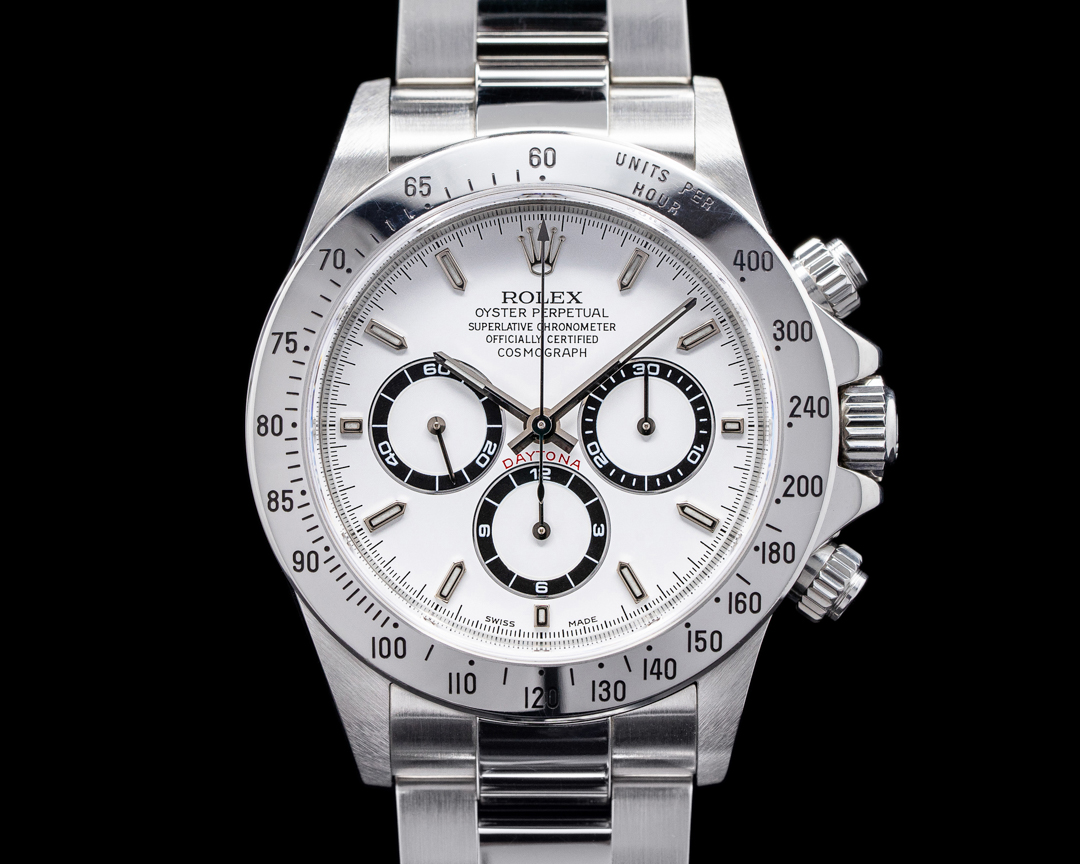
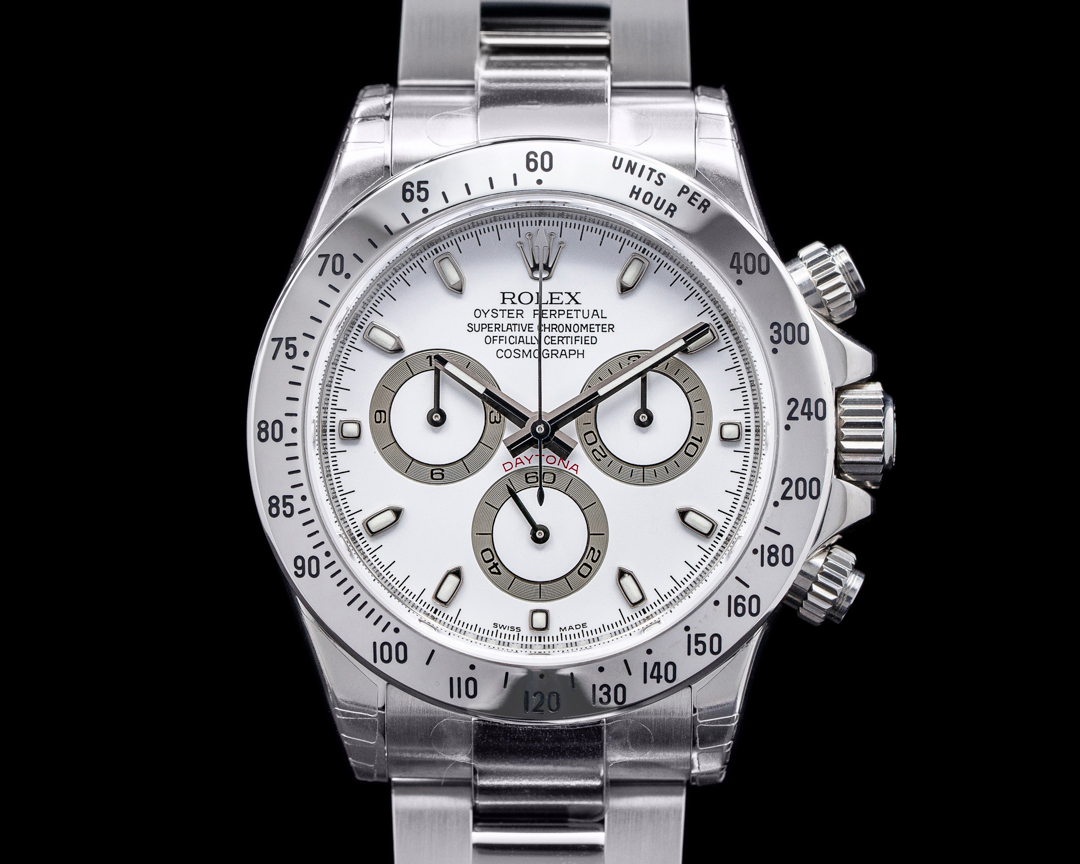
2000 – The ref. 116520, the first Daytona with a completely in-house Rolex movement, the caliber 4130, was released at the Baselworld exhibition in 2000.
The caliber 4130 was the first completely in-house Daytona movement and was produced with just 290 components (60% less than the El Primero movement of the earlier ref. 16520) and 12 screws (compared to 40). This generated less friction, enhanced efficiency and performance (power reserve increased to 72 hours from 54), and made it much easier to service.
2013 - Rolex commemorated the 50th anniversary of the Daytona model line with an all-platinum version, the ref. 116506, that featured an ice blue dial and a chocolate brown bezel made of Rolex’s proprietary “Cerachrom” ceramic material.

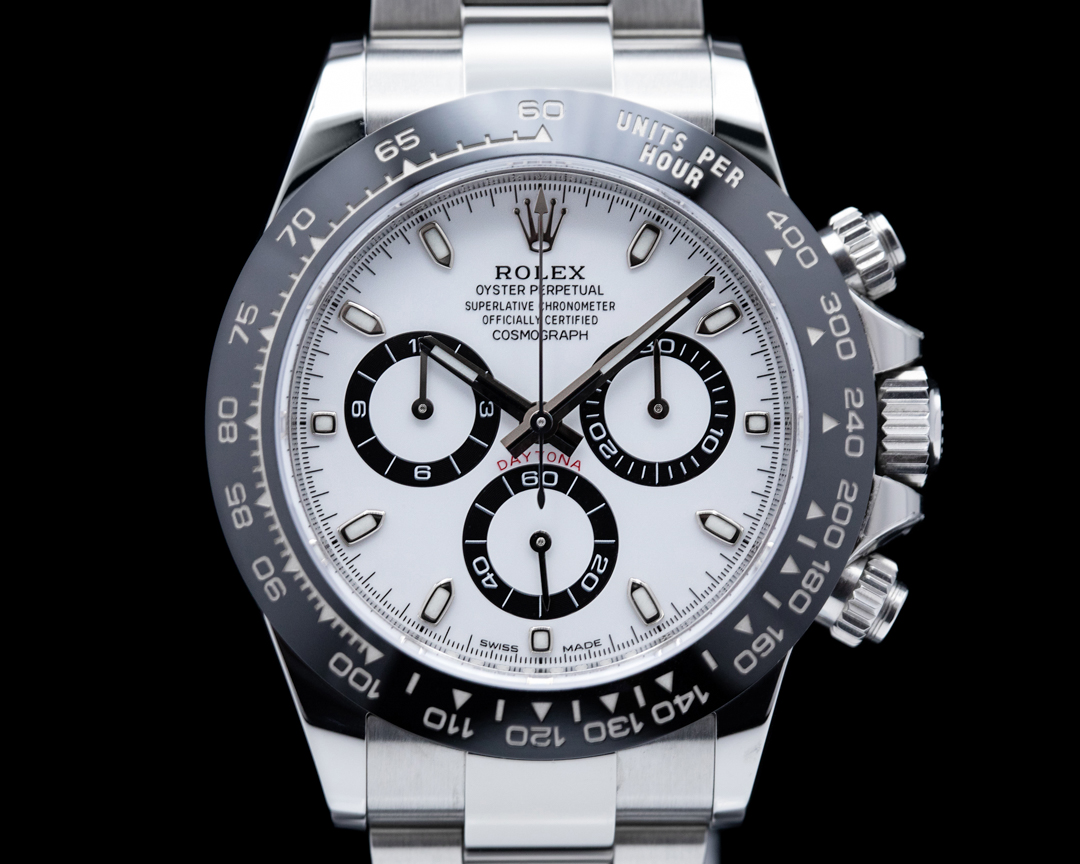
2016 – The ref. 116500LN is introduced featuring a black Cerachrom bezel and either a white or black dial. Still in current production, the model is one of the most desirable sport watches available on the market today.
2018 – An assortment of creative Daytonas such as the ref. 116599RBOW “Rainbow Daytona” (introduced at Baselworld 2018) continue to dazzle with a bezel set with 36 baguette cut sapphires graduated in a "rainbow" fashion , diamond hour indices, lugs and crown guards set with diamonds, and sub dials made from gold crystals.
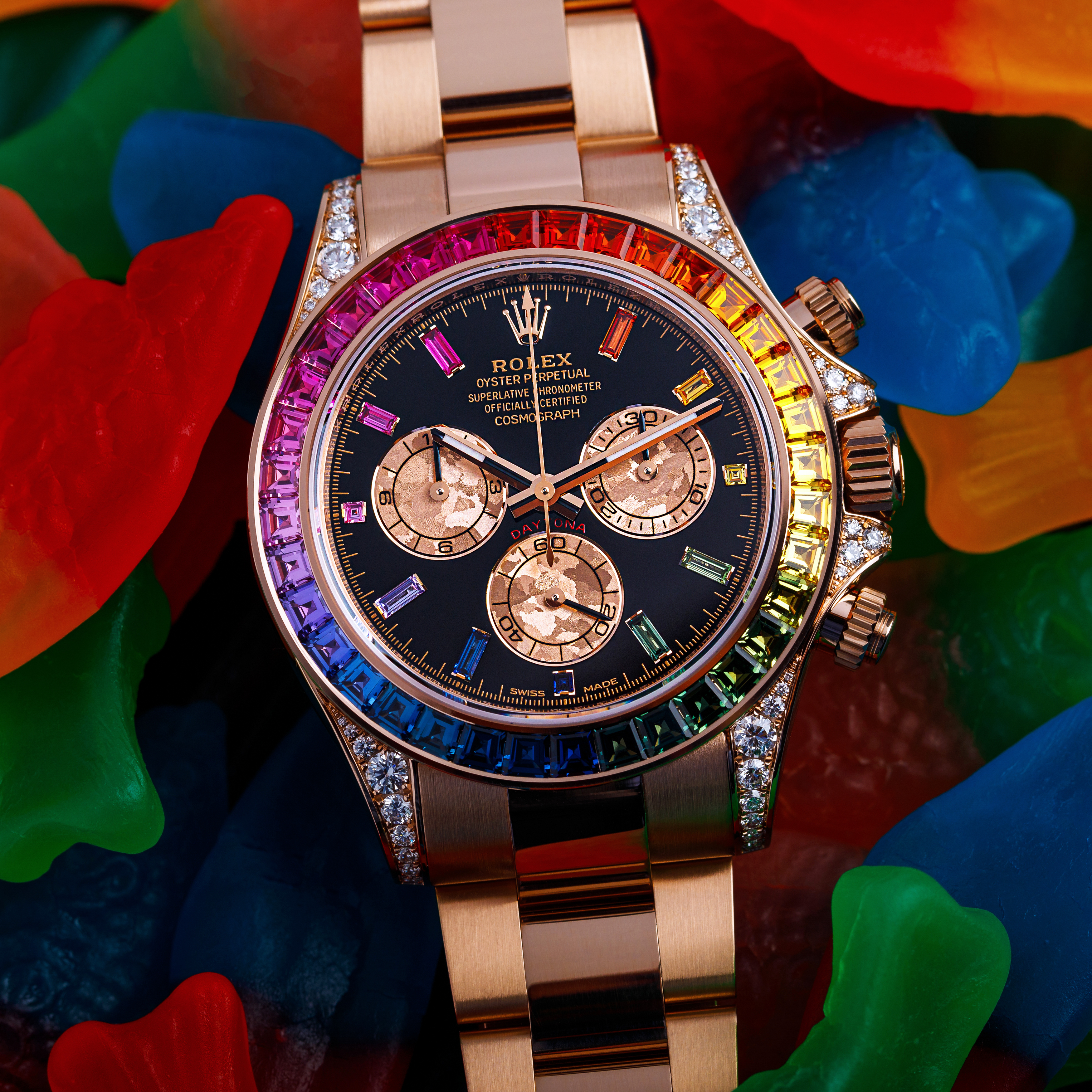
THE ROLEX DAY-DATE
The Datejust model line set the standard for a date complication when it was introduced in 1945, and by the mid ‘50s, Rolex was preparing to take the next step forward. In 1956, the company introduced yet another advancement that made daily life easier with the release of the Oyster Perpetual Day-Date. The model was prestigious, high-end, and very special. Measuring 36mm in diameter, the Oyster Perpetual Day-Date was only produced in 18K gold or platinum. It was also the first watch with aperture windows for the date (with a "cyclops" magnification lens) at 3 o'clock and the completely spelled day of the week at 12 o'clock.
The watch featured a specially-made "President" bracelet, so called because several presidents of the United States wore Day-Dates including Dwight D. Eisenhower, John F. Kennedy (gifted by Marilyn Monroe), and Lyndon B. Johnson. The original model released in 1956 was produced for just one year and came with either a smooth (ref. 6510) or fluted (ref. 6511) bezel.



The second series of the Day-Date (ref. 6611) was introduced in 1957 with a slightly updated movement followed soon after by the third generation in 1960 with the ref. 1803 available in yellow, white, and rose gold and the ref. 1804 in platinum.
The third generation 1800 series was available with a selection of exotic dials including Fossil, Meteorite, Opal, Turquoise, and 20 other types of exotic stone. Rolex also introduced baguette diamond hour markers and complete pave diamond faces with stones cut in the 8/8 17-facet configuration.
In 1977, Rolex added a quartz powered model to the Day-Date family, the ref. 19018. The watch featured a more angular case than its mechanical relative, an integrated flat-link President bracelet, and a caliber 5033 mecha-quartz movement.
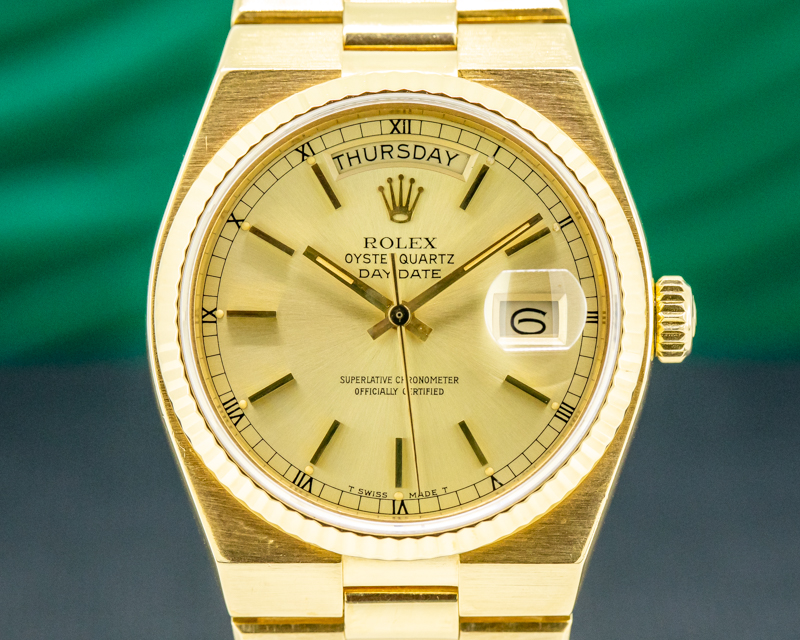

By 1978 when the fourth series ref. 18038 was introduced, the Day-Date had become international shorthand for elegance and class. The “day” wheels were produced in 25 different languages ranging from German to Japanese to Farsi and the model now came with a sapphire crystal and the more advanced caliber 3055 movement which featured a quickset adjustment for the date.
In 1988, the ref. 18238 was introduced featuring a new caliber 3155 movement. The updated caliber gave the Day-Date double quickset capabilities allowing the wearer to easily adjust both the day and date displays.
In 2008, Rolex released the 41mm ref. 218238 Day-Date II to address the public's growing desire for larger watches. The Day-Date II also possessed a slightly thicker and sportier design.
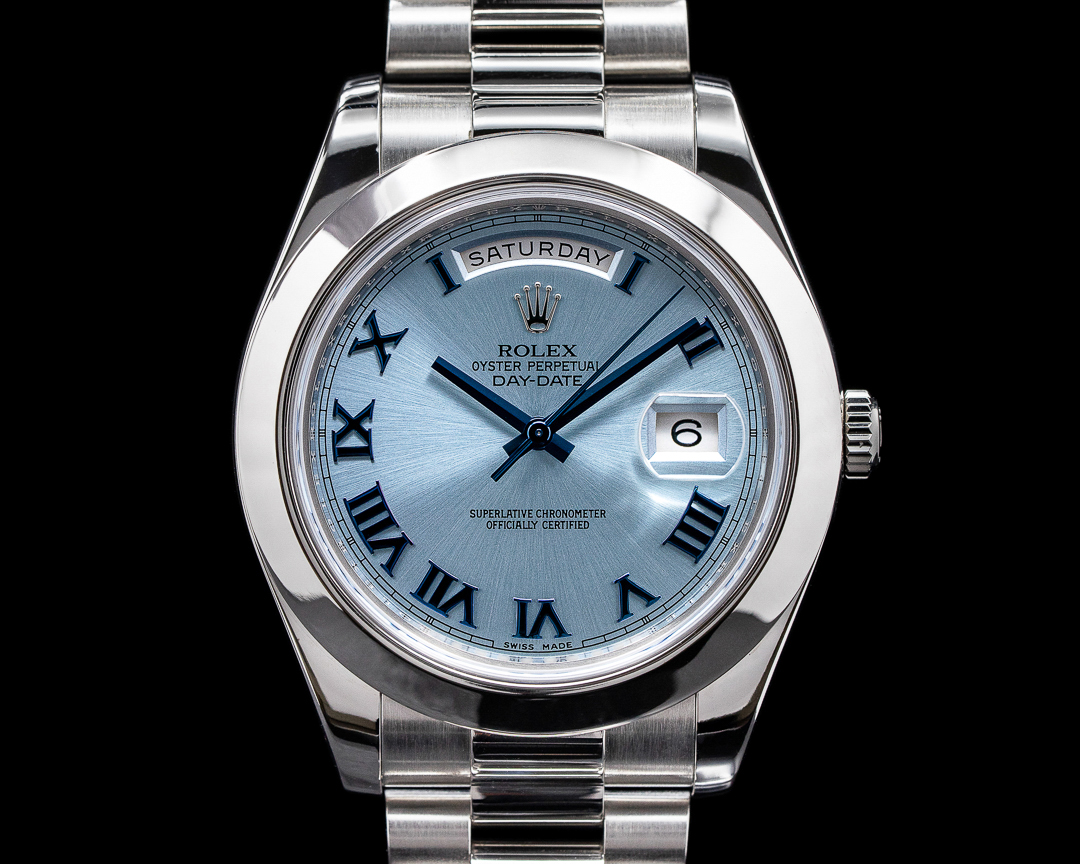

The 41mm model had a short run as the 40mm ref. 228238 Day-Date was introduced in 2015. This new model was powered by Rolex’s caliber 3255 movement which featured the Chronergy escapement, blue Parachrom hairspring (produced from a paramagnetic alloy of niobium and zirconium), and a 70-hour power reserve.
In 2016, for the 60th anniversary of the Day-Date model line, Rolex introduced a green dial edition in Everose (ref. 228235) or white gold (ref. 228239).
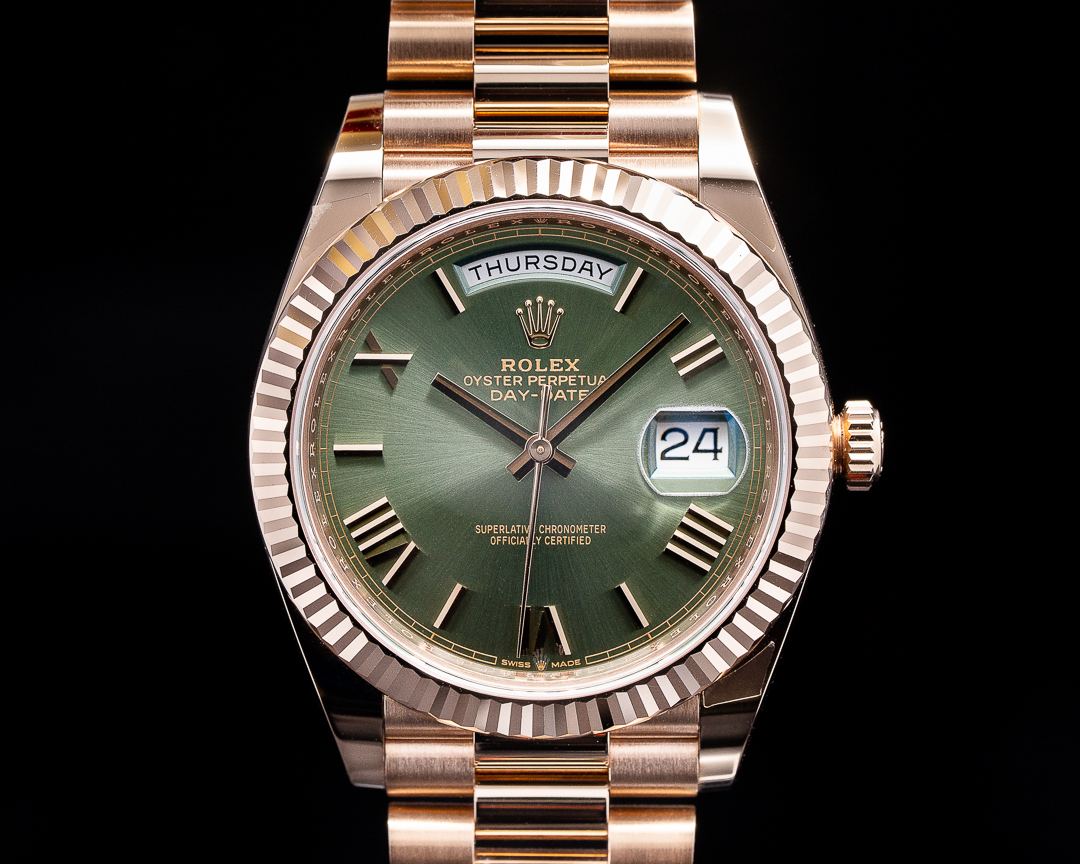
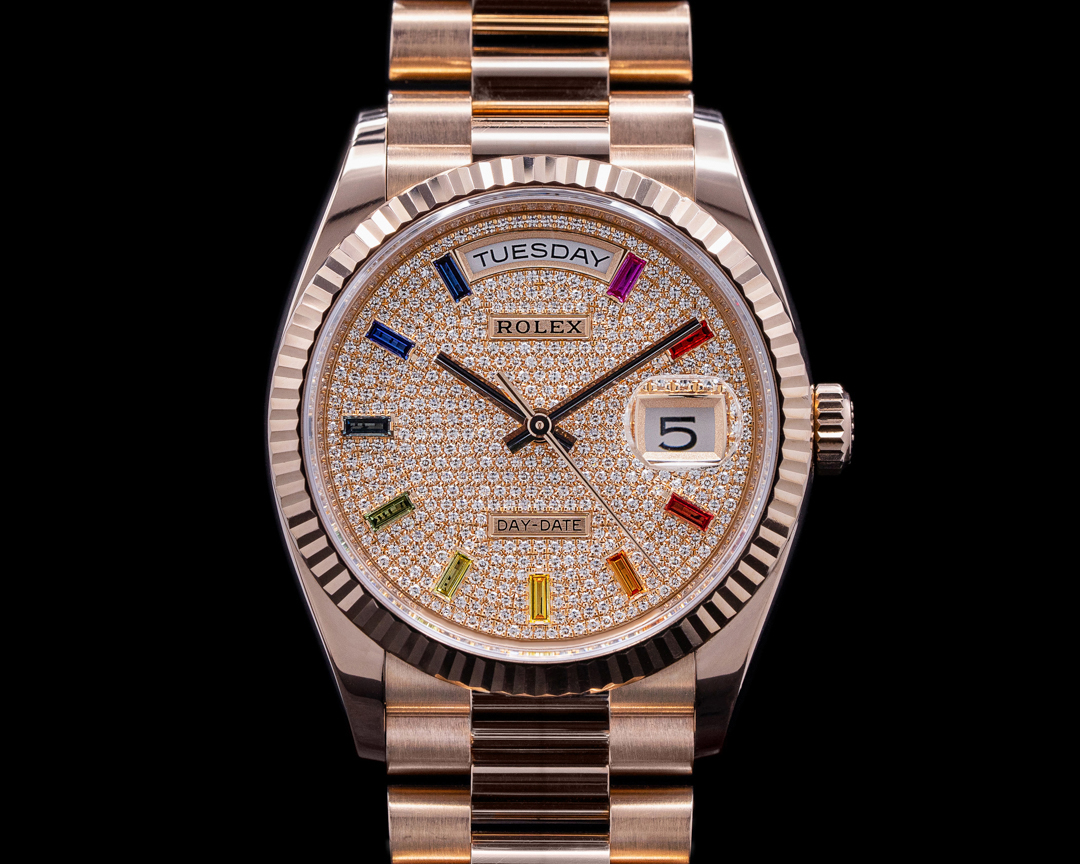
The 36mm Day Date was updated in 2019 to include the new caliber 3255 movement. The model was also offered in a number of new configurations and dials including a green or blue “ombre” dial with diamond hour markers, and a “Rainbow” Day Date which featured a pave diamond dial and sapphire hour markers in the color of the rainbow.
The flagship Rolex model since 1956, the Day-Date, in all of its many variations, is still integral to the brand and its image today.
THE ROLEX MILGAUSS
1956 turned out to be an important year for Rolex as the company released more than just the iconic Day Date. This additional innovative model, the Milgauss, proved invaluable to the scientific community. CERN, the European Organization for Nuclear Research, was the world's most important particle physics laboratory, working to uncover the universe's fundamental mysteries and Rolex presciently saw that there was increasing demand for a watch that could withstand the high magnetic fields in research laboratories, such as the high energy particle accelerator at CERN.

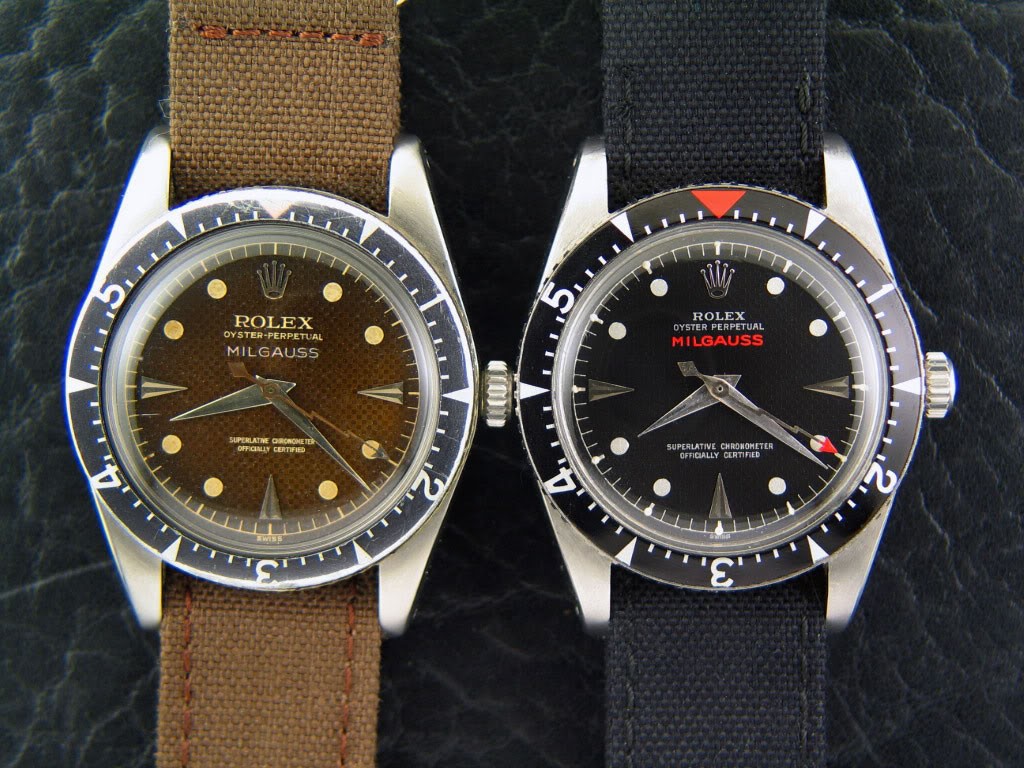
Rolex produced a limited number of ref. 6543 Milgauss test watches in 1954 but the model was not officially released until two years later when the ref. 6541 debuted in 1956. The new Milgauss was made of ferromagnetic monometallic alloys that were impervious to magnetism and could withstand magnetic interference of up to 1,000 gauss. It featured a honeycomb patterned dial and a distinctive seconds hand in the shape of a lightning bolt. The model was available with both a Submariner-style rotating bezel and a smooth steel bezel. After its launch, Rolex partnered with CERN to test the anti-magnetic properties of the watch.
The "Mil" in the name was short for the French word "Mille," meaning a thousand and "Gauss" is the measurement for magnetic fields. The Milgauss was produced using new components that shielded the movements, including a soft-iron protective case that safeguarded the mechanism. The engineers at CERN called it "the perfect magnetic shield”.
In 1960, the second generation ref. 1019 was introduced. The new model looked more like a standard Oyster Perpetual with thin applied hour markers, tapered hands, and a long, thin seconds hand with a red arrow tip in place of the lightning bolt of the 6541. The 1019 was available with either a black or silver dial and was produced until 1988 when the model line was discontinued due to lack of interest.
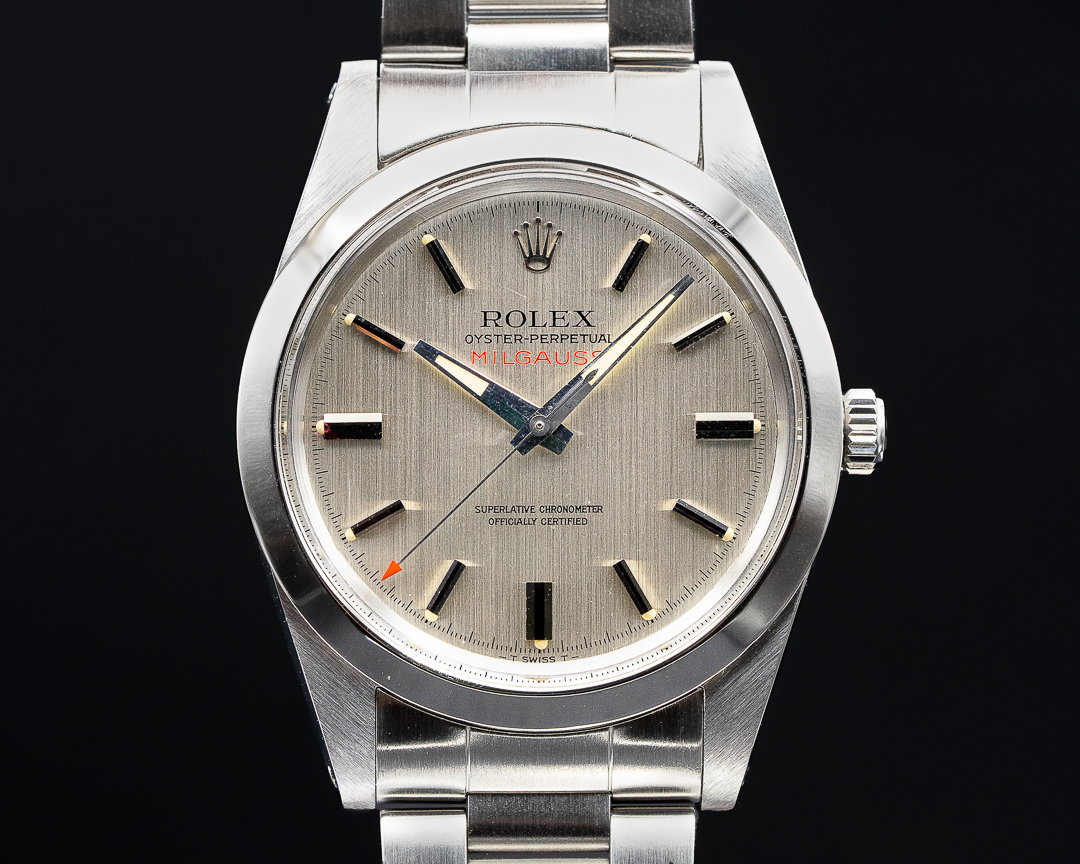
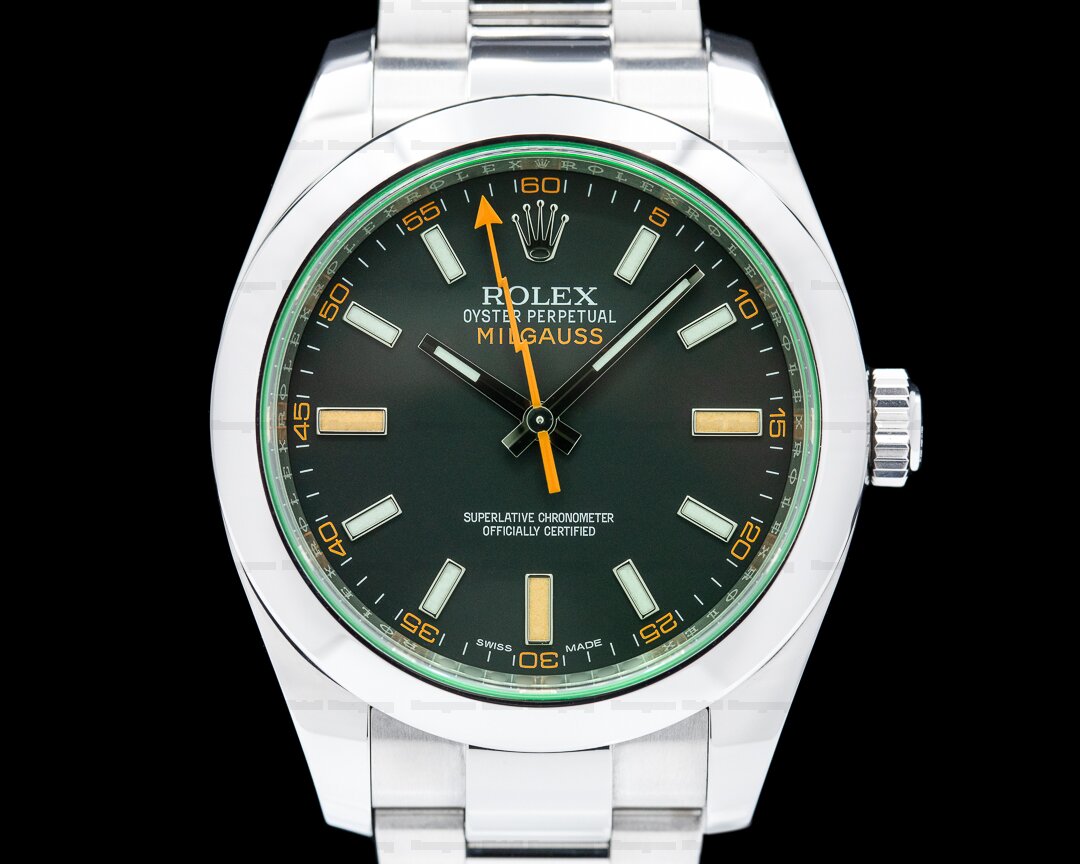
Rolex resurrected the line in 2007 with the release of the all-new ref. 116400. Taking design cues from the ref. 6541 and 1019, the new model offered a smooth polished steel bezel, thick hour markers and hands, and the iconic lightning bolt seconds hand, now in bright orange. Initially available with either a black or white dial (both with orange accents), a special anniversary model was also introduced with a black dial and green-tinted crystal known as the Glace Verte (ref. 116400GV).
In 2014, Rolex released another variant of the ref. 116400, this time featuring a blue dial and the green-tinted crystal, which has come to be known as the Z-Blue.

THE ROLEX SEA DWELLER
Groundbreaking explorers and expeditions have always served as a major source of inspiration for new Rolex models and innovations, and the Sea Dweller was no different. In 1960, the experimental US Navy bathyscaphe Trieste, captained by Lieutenant Don Walsh and first mate Jacques Piccard, descended into a depression in the Mariana Trench called the Challenger Deep, the deepest place on the surface of the Earth. The Trieste dove to a depth of 10,916 meters (35,800 feet) below the surface of the Pacific with a prototype Rolex Deep Sea Special watch attached to the outside of the craft. The watch was completely unfazed by the trip and after the dive, Piccard messaged Rolex HQ “Happy to announce that your watch works as well at 11,000 metres as it does on the surface”.


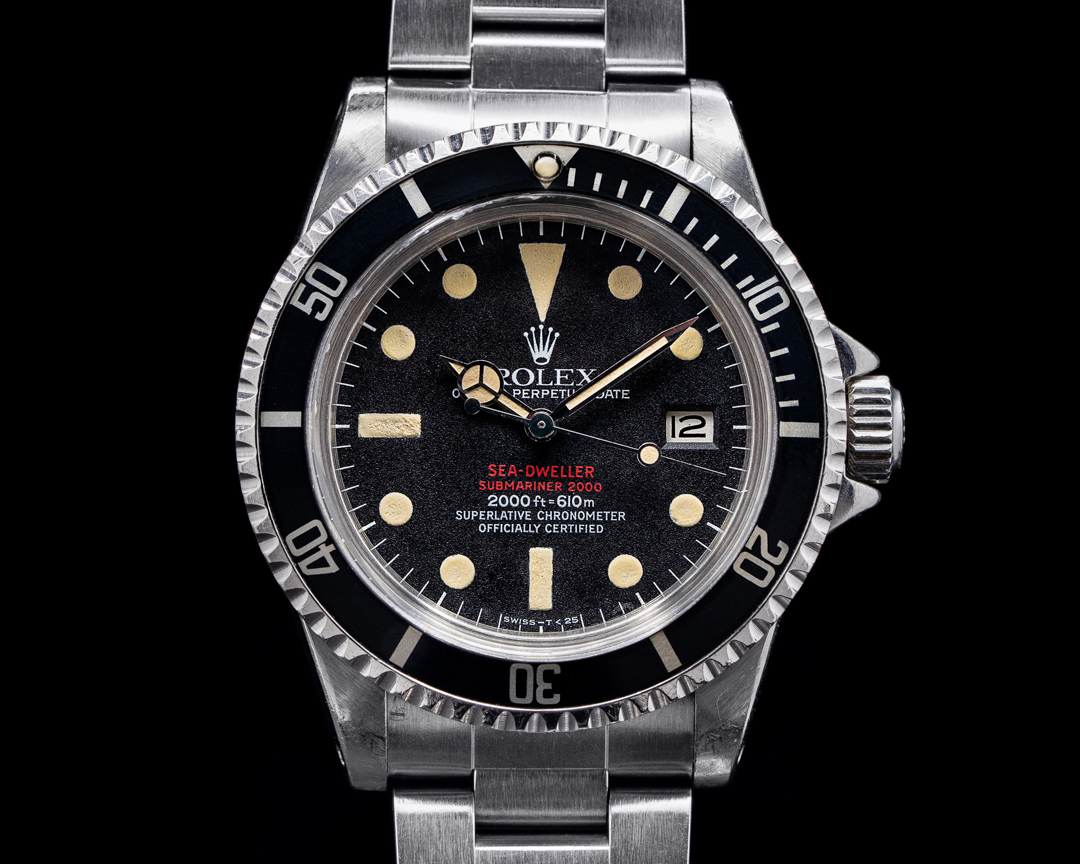
THE SEA DWELLER'S NOTEWORTHY EVOLUTION
1967 - After 7 years of engineering and research inspired by the Rolex Deep Sea Special that accompanied the Trieste into the Mariana Trench, Rolex introduced the ref. 1665 Oyster Perpetual Sea-Dweller. Water resistant to 610 meters/2001.31 feet and designed for professional divers, the watch was equipped with a helium escape valve on the left caseband. This first generation (specifically examples produced between 1967 and 1977) featured a date with no cyclops magnifier, a thick domed plexiglass crystal, and the words “Sea-Dweller” and “Submariner 2000” printed in red above a depth rating and COSC designation. These have come to be known as the “Double Red Sea-Dweller” and are some of the most desirable variants available today.
In the 1960s, SCUBA diving was still in its infancy and saturation divers were constantly pushing the boundaries, testing the limits of both their equipment and their bodies. In 1967, when the standard Submariner reference 5513 could withstand up to 200 meters of pressure, divers routinely reached three times that depth.
In an effort to address this issue, the Reference 1665 Sea Dweller was developed with help from French deep-sea dive specialists Compagnie Maritime d’Expertises (COMEX). To help reach these new depths, the world's first Helium release valve was an essential innovation. The release is a one-way purge valve that allows trapped helium gas molecules to gradually exit the watch case in a safe and controlled manner without damaging the watch.


There were around 100 early Sea-Dwellers (including four with a "Single Red" signature) that were only rated for 500 meters of depth but the vast majority of 1665’s produced between 1967 and 1977 were rated for 2000 feet/610 meters. These watches featured a 40mm diameter, matte black dials with the iconic two lines of red “Sea-Dweller, Submariner 2000” text, acrylic crystals, Oyster link bracelets with diver's extensions, and printed hour markers. They lacked the cyclops magnification lens over the date window of the Submariner, and the case was slightly thicker. These Sea-Dwellers were powered by the Rolex caliber 1575 automatic movement. This initial model also included the words "patent pending" on the case backs while Rolex waited for approval of their Helium escape valve patent.
1977 - The ref. 1665 Sea-Dweller transitioned to a model known as the “Great White" with the model name and depth rating printed in white letters instead of red. Rolex also removed the "Submariner" text from the dial to better differentiate the model lines.
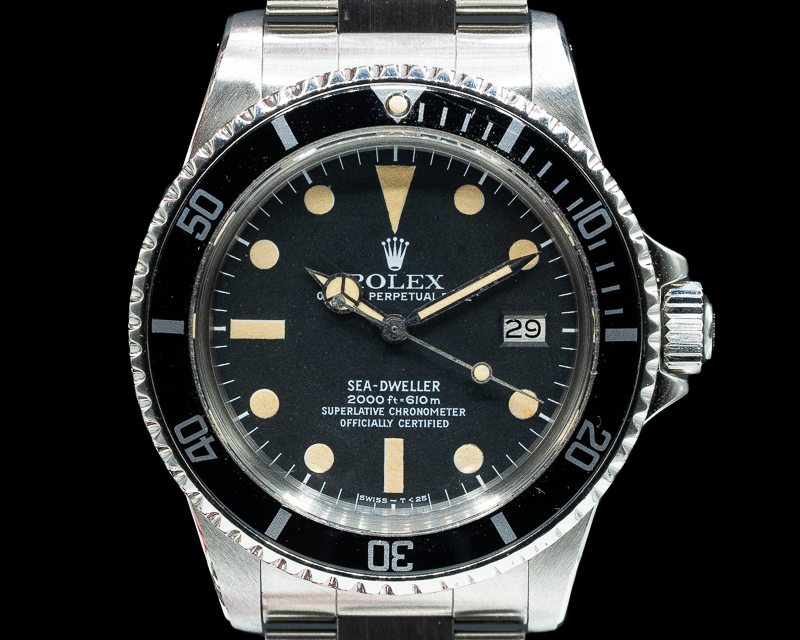
1978 - The ref. 16660 (nicknamed the "Triple Six") was released with a new sapphire crystal instead of the traditional acrylic, a larger 44mm case, and an increased depth rating of 1,220 meters/4000 feet. Other features included a unidirectional bezel, the new caliber 3035 movement, an improved solid link bracelet, and a quickset date. 16660’s had matte black dials and printed hour markers until 1988 when Rolex switched to applied hour indices with white gold borders..
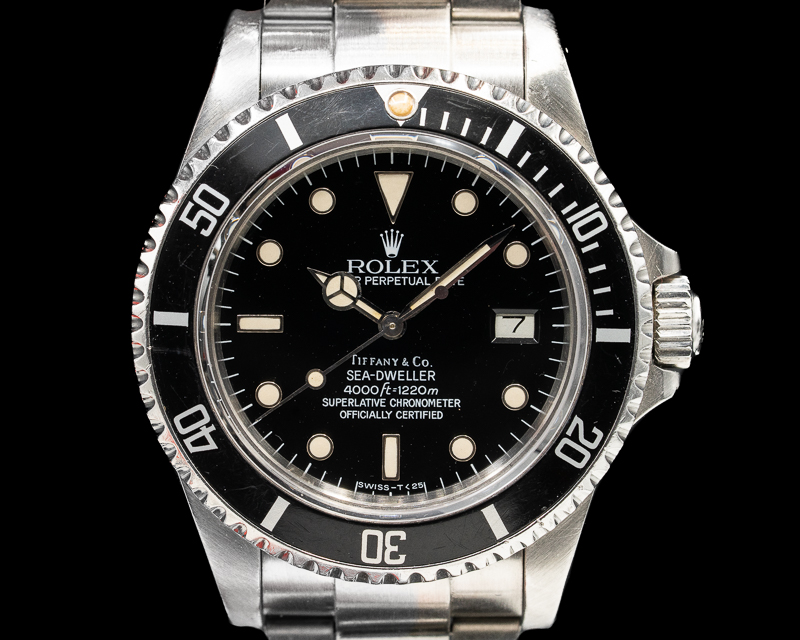
1988 - Rolex introduced the reference 16600 with an upgraded caliber 3135 movement. It included solid end links on the bracelet and a glossy dial. Over the course of its exceptionally long run (the model was not discontinued until 2008) the lume went from tritium to LumiNova and, finally, Super-LumiNova.
2008 - The Deep Sea Sea-Dweller ref. 116660 was introduced with an extra-large 44mm diameter case. The depth rating was now a stunning 3900 meters/12,800 feet. The 116660 featured a ceramic bezel with elapsed time scale, a titanium caseback to help reduce weight, a 5mm thick sapphire crystal to withstand the pressure at more than 12,000 feet, a new Oyster bracelet with an innovative “Glide-lock” clasp, Rolex’s patented Ring Lock System, and the venerable caliber 3135 movement.
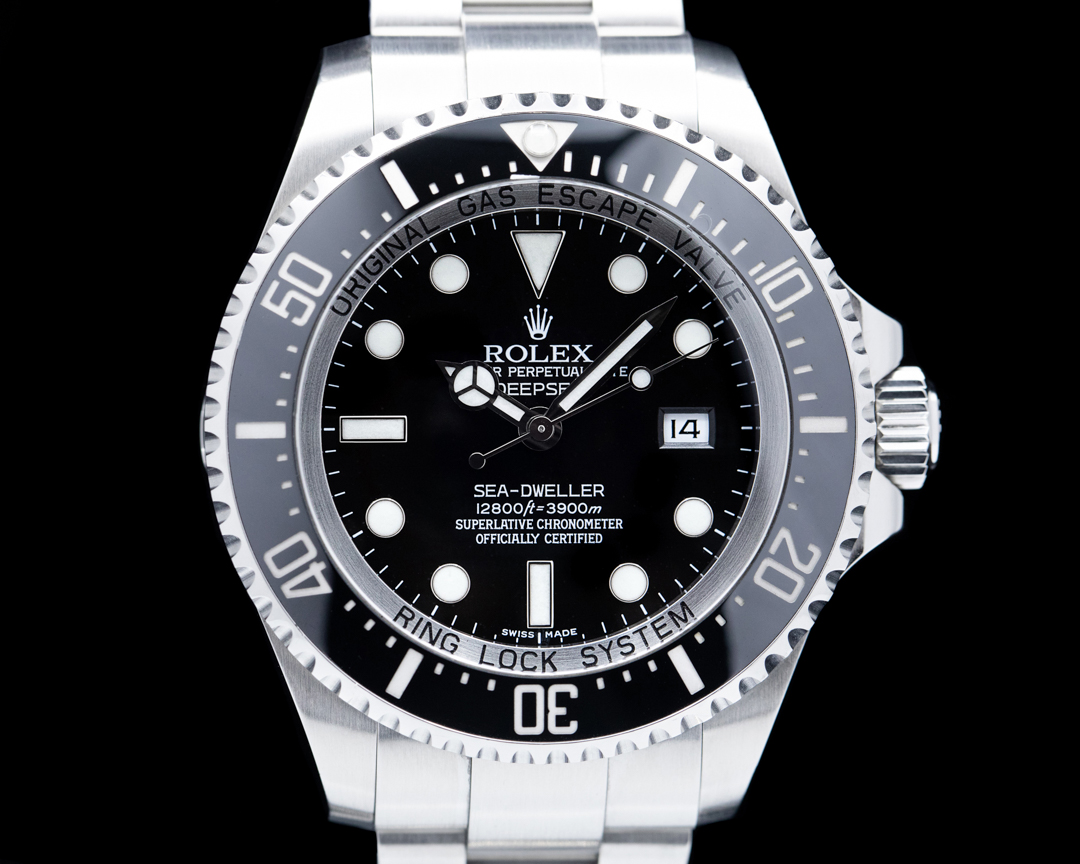
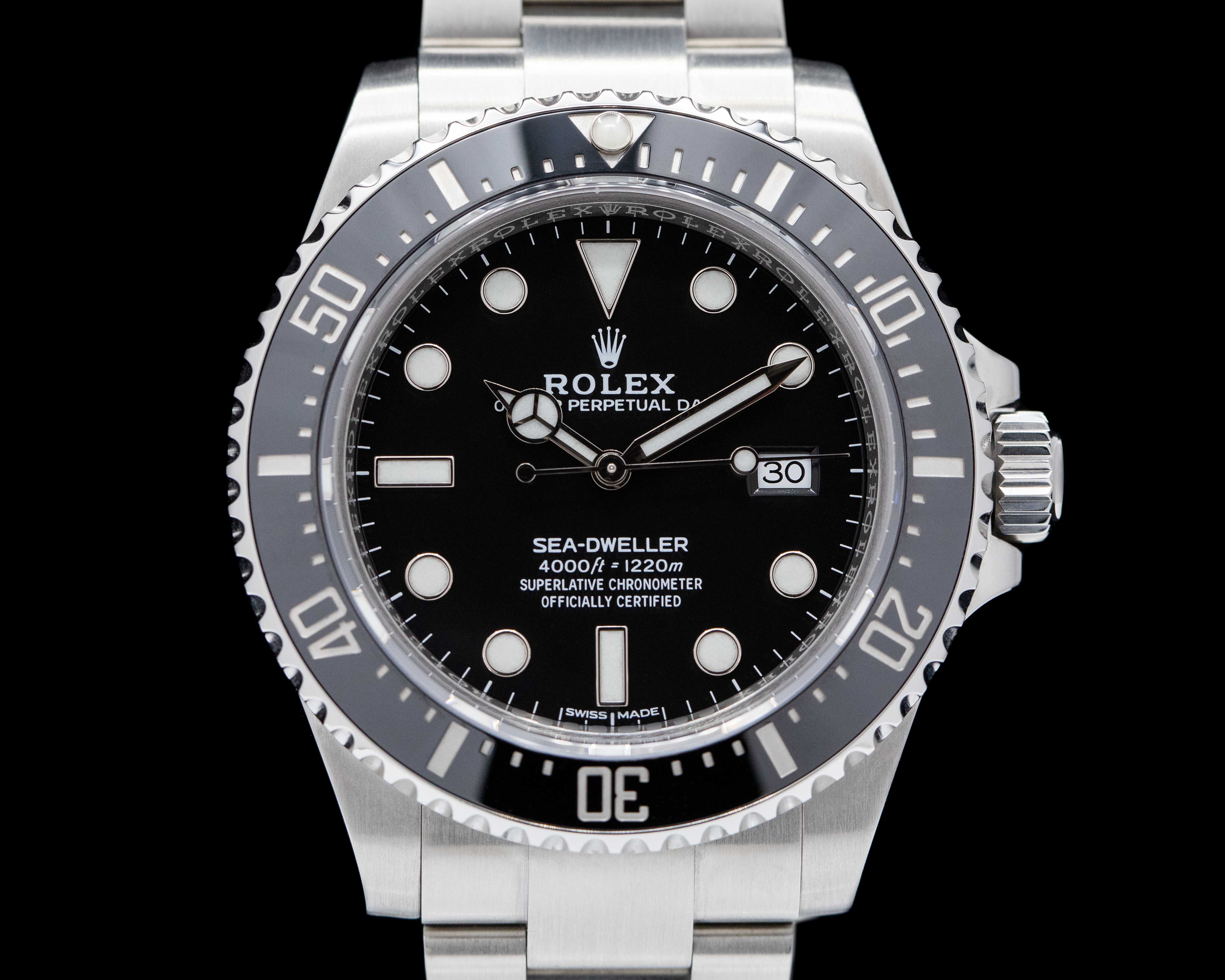
2014 - After being discontinued in 2009, Rolex reintroduced the Sea Dweller model with the ref. 116600. The new model returned to the 40mm case size and traditional 4000-foot depth rating. The model had a black ceramic bezel with elapsed time scale, black dial with applied hour indices, "Mercedes" style hour hand, and an Oyster bracelet with the Glide-lock clasp. It was only produced until 2017 making the model one of the shortest lived of any Rolex sports watch.
A non-limited special edition called the “D-Blue” debuted in 2014 to commemorate Hollywood director James Cameron's headline-making solo dive to the bottom of the Mariana Trench in the Deep Sea Challenger submarine. It was identical to the standard model except for the addition of a blue-to-black gradient dial with the DEEPSEA signature in bright green letters.
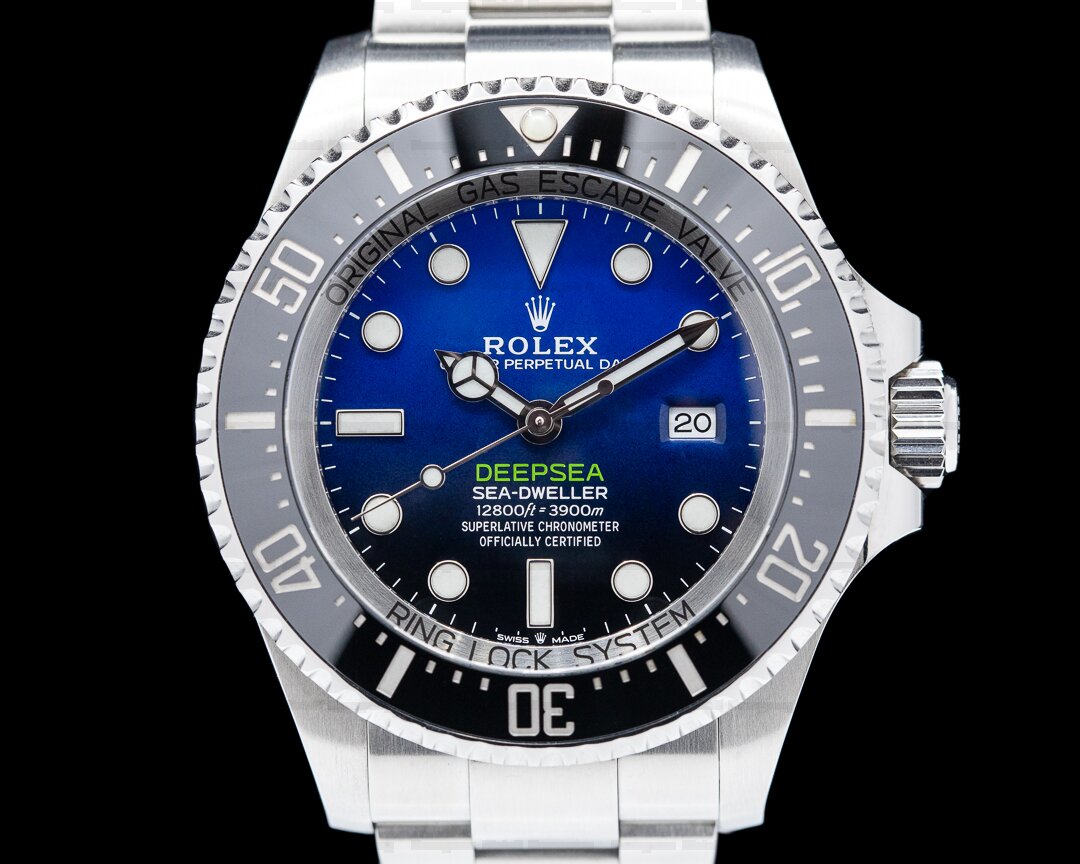
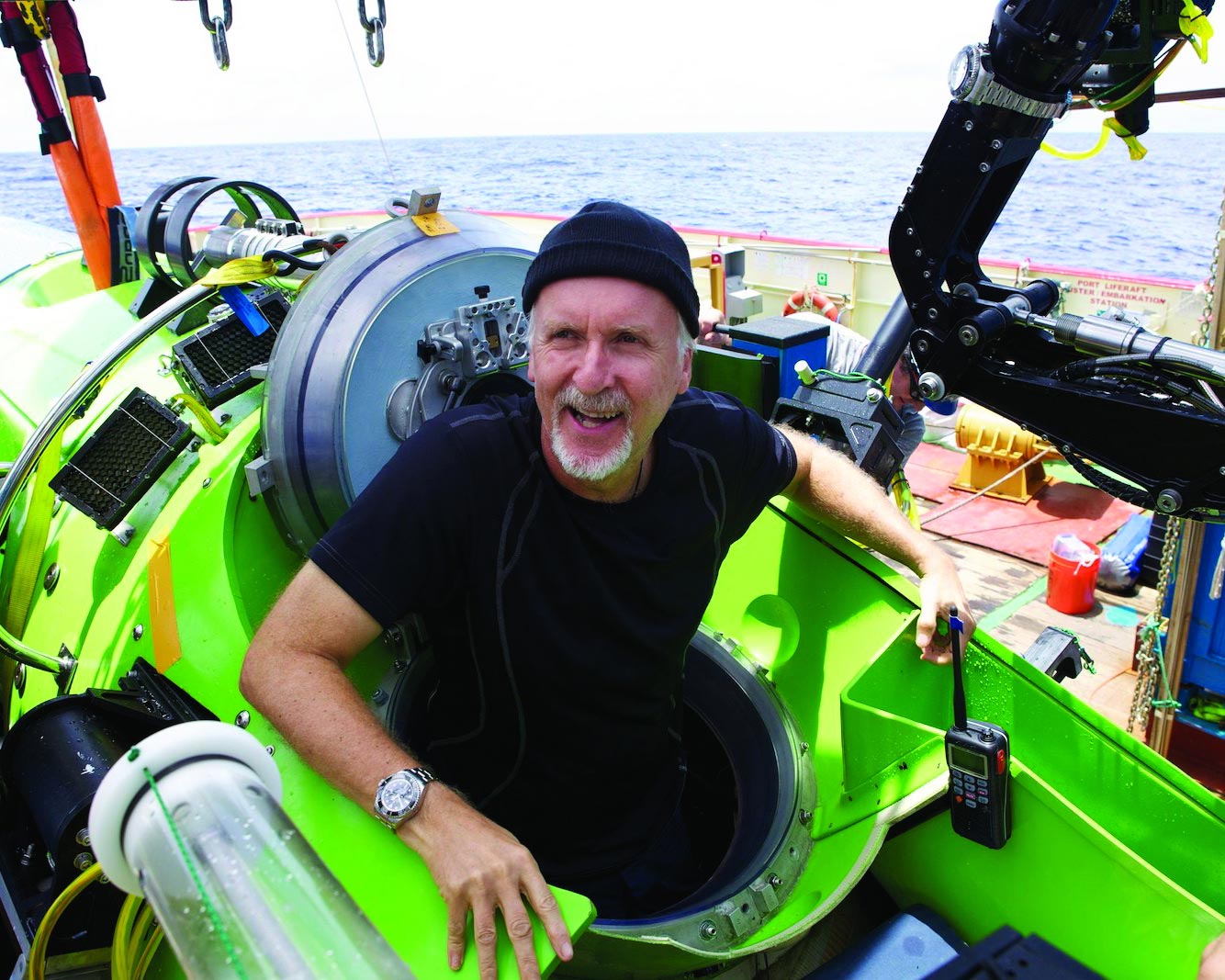

2017 - To celebrate the 50th anniversary of the Sea-Dweller, Rolex introduced the "SD43" reference 126600 at the Baselworld exhibition. The model features a 43mm diameter case, Helium Escape Valve, a glossy black dial with the “Sea-Dweller” name printed once again in red letters, wider lugs for a redesigned Oysterlink bracelet, the new Rolex caliber 3235 automatic movement with a 70-hour power reserve, and (for the first time ever on a Sea Dweller) a cyclops magnifier over the date aperture.
2019 – In another first for the line, the two-tone stainless-steel and yellow gold ref. 126603 version of the Sea Dweller was introduced.
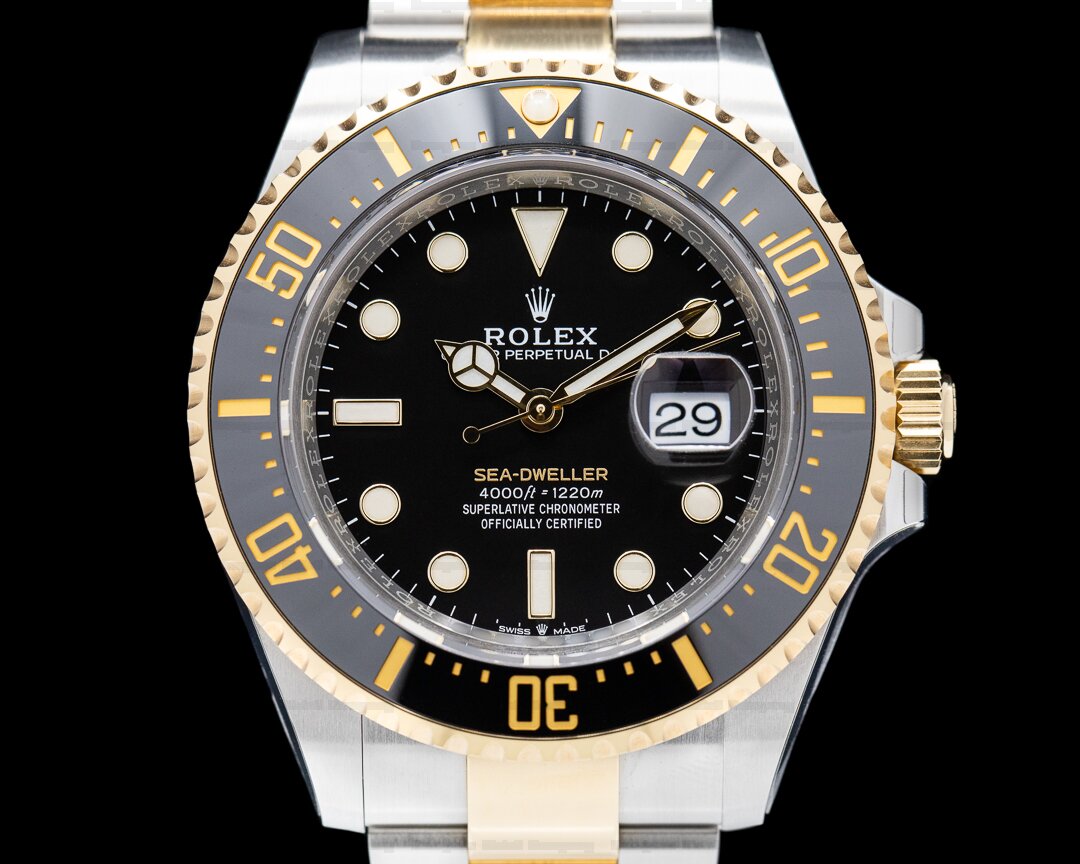
THE GMT MASTER
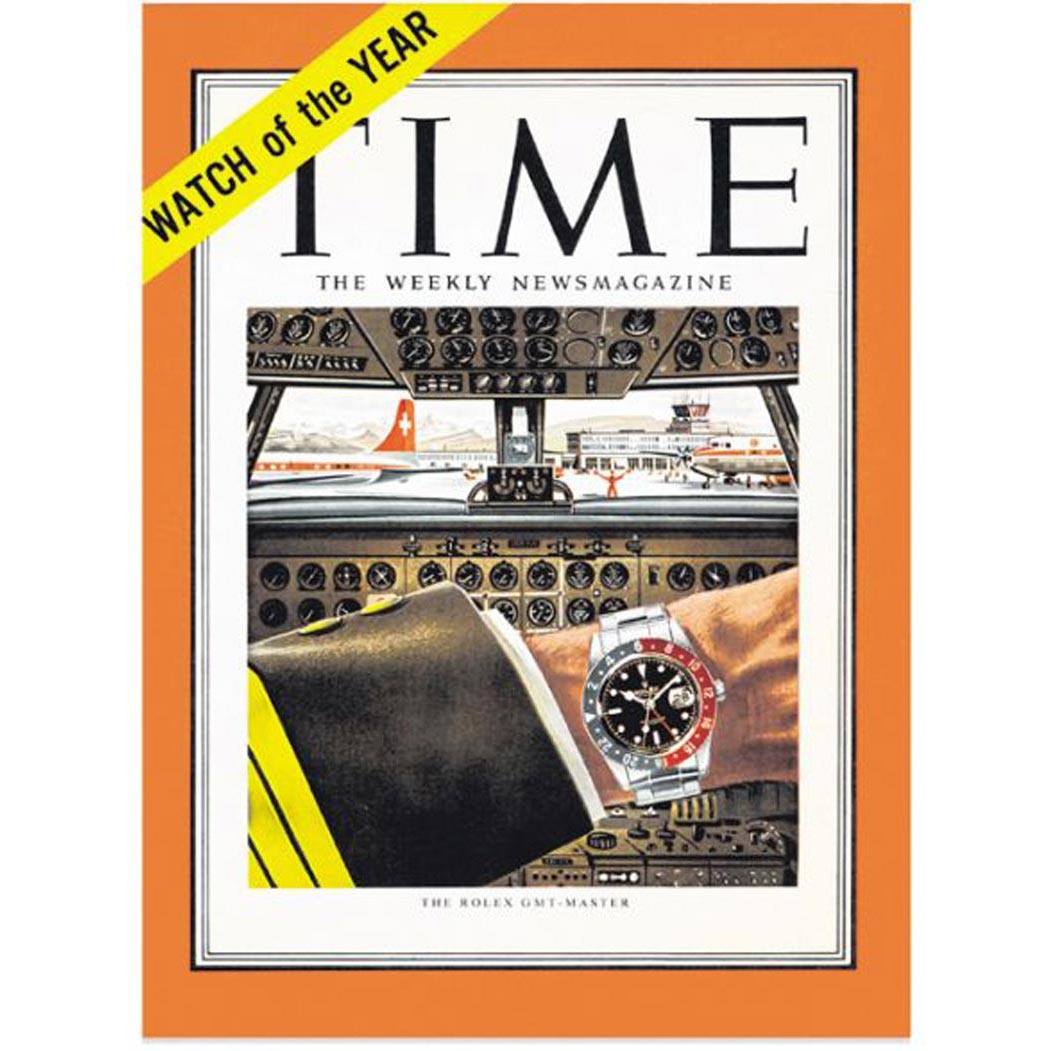
With the rise of international air travel after WWII, reaching the far-flung corners of the globe was suddenly easier than ever before. The iconic carrier of the jet set era, Pan Am, reopened its Atlantic and Pacific routes giving American travelers access to Asia, Europe, and Africa using iconic planes such as the Boeing 377 Stratocruiser, the Douglas DC-7C Seven Seas, and the Lockheed Constellation. These airliners moved passengers effortlessly across time zones and borders and keeping track of the time in multiple locations became a real necessity. Pan Am reached out to Rolex and asked them to come up with a watch that would solve this challenge for their pilots. In response, the ref. 6542 GMT Master was introduced in 1954 and quickly became standard issue for pilots industry-wide.
The all-new model was housed in a classic 38mm Oyster case in steel and introduced two major innovations that are now taken for granted in the world of Rolex. The first was the “Cyclops” date magnification bubble designed to give users a clearer, more accurate view of the date wheel, and the second (and more important) innovation was the dual time zone GMT complication that allowed the wearer to track both local and home time simultaneously. To achieve this capability, Rolex modified their caliber 1030 movement (found in the Oyster Perpetual, Submariner, and Explorer models of the era) to include a centrally-mounted 24-hour hand. The new caliber 1065 was a COSC rated four-hand chronometer movement with a date function. By adjusting the bi-directional red and blue bakelite bezel, the wearer could keep track of the local time using the main hands and their home time using the central GMT hand (which completed one full rotation of the dial every 24 hours). Nicknamed the “Pepsi” GMT because of its red and blue bezel, the colors were actually chosen because they were the corporate colors of Pan Am Airways.
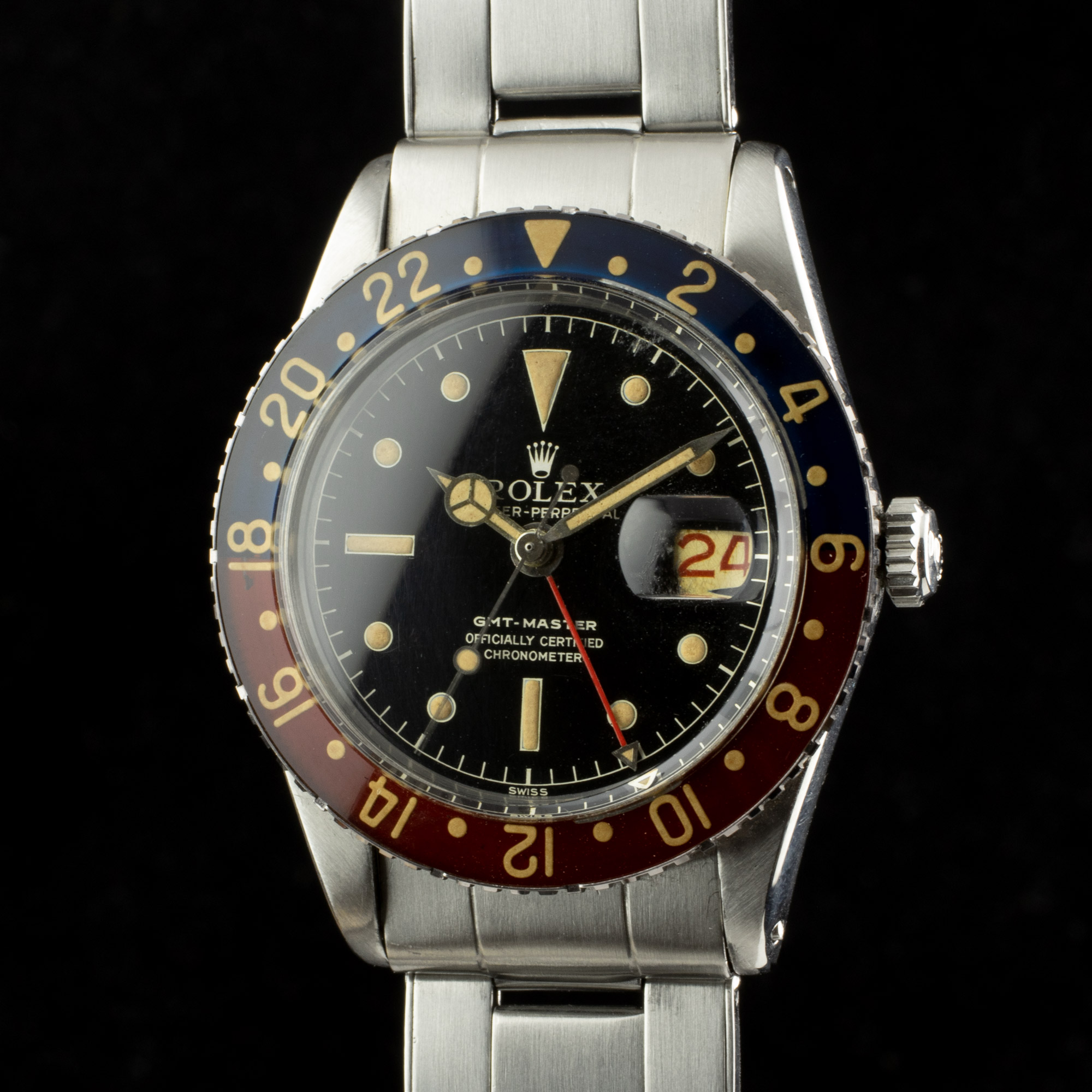
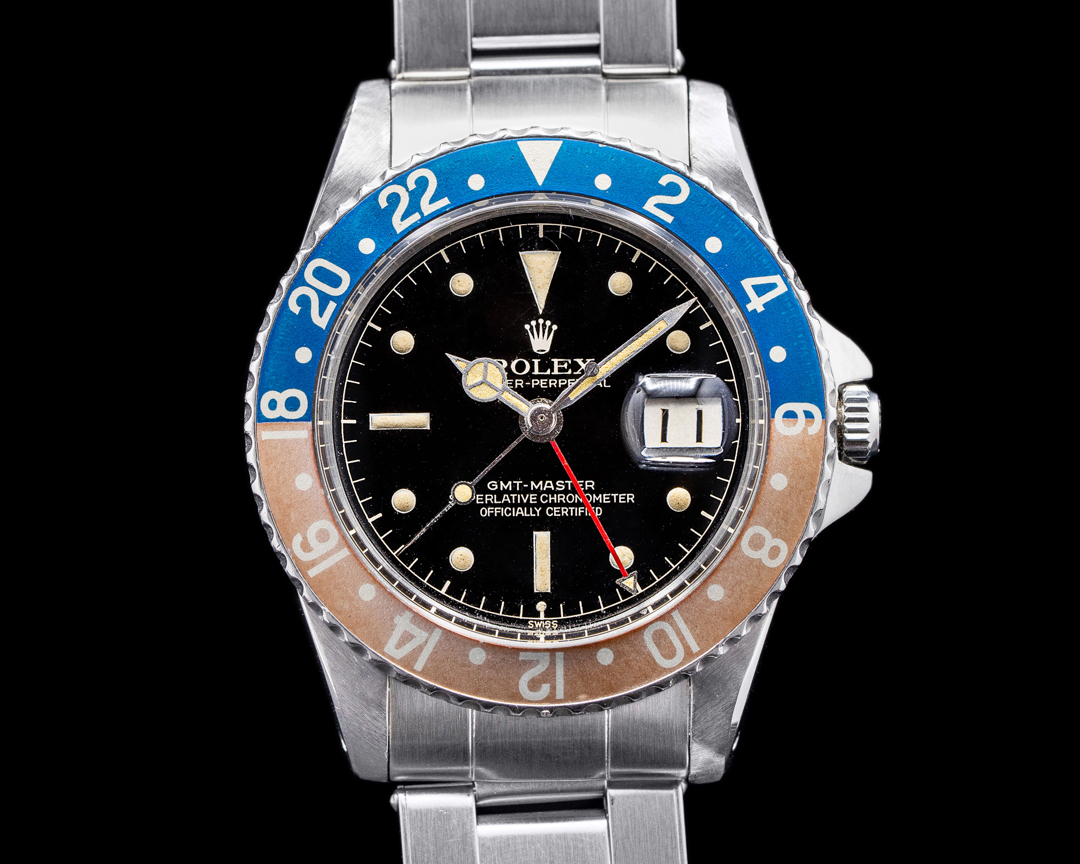
Released in 1959, the second series ref. 1675 GMT Master remained in production for more than 20 years. It was constructed using the new caliber 1565 movement and was housed in a slightly larger 40mm case. Available in both stainless-steel and 18K yellow gold (as the ref. 1675/8), all versions of the updated reference now sported crown guards to protect the screw-down winding crown. A much more durable aluminum bezel insert replaced the delicate bakelite of the original model with the red and blue “Pepsi” colorway remaining standard. Over it’s long lifespan, two specific iterations of the crown guards were produced - pointed crown guards (commonly know as “PCG” or "cornino" which means horns in Italian) were used from the model’s release until the mid-1960’s, after which rounded crown guards (similar to those used on the Submariners of the era) were used.
The GMT Master changed little throughout the 1960's, however two distinctive additions arrived in the early 1970's. The ref. 1675/3 arrived first with a two-tone stainless-steel and yellow gold case and bracelet. Two variations were available - one with a brown dial and a half brown/half gold bezel insert (nicknamed the "Root Beer”), and another with a black dial and an all-black bezel insert. Both versions were available on Jubilee or Oyster bracelets.
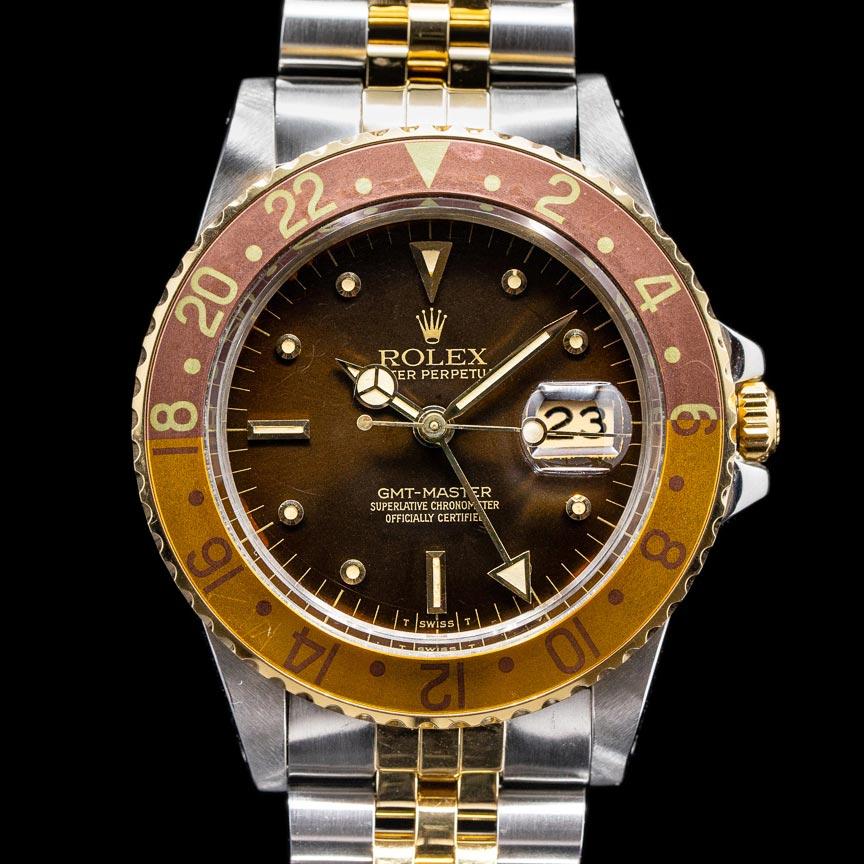


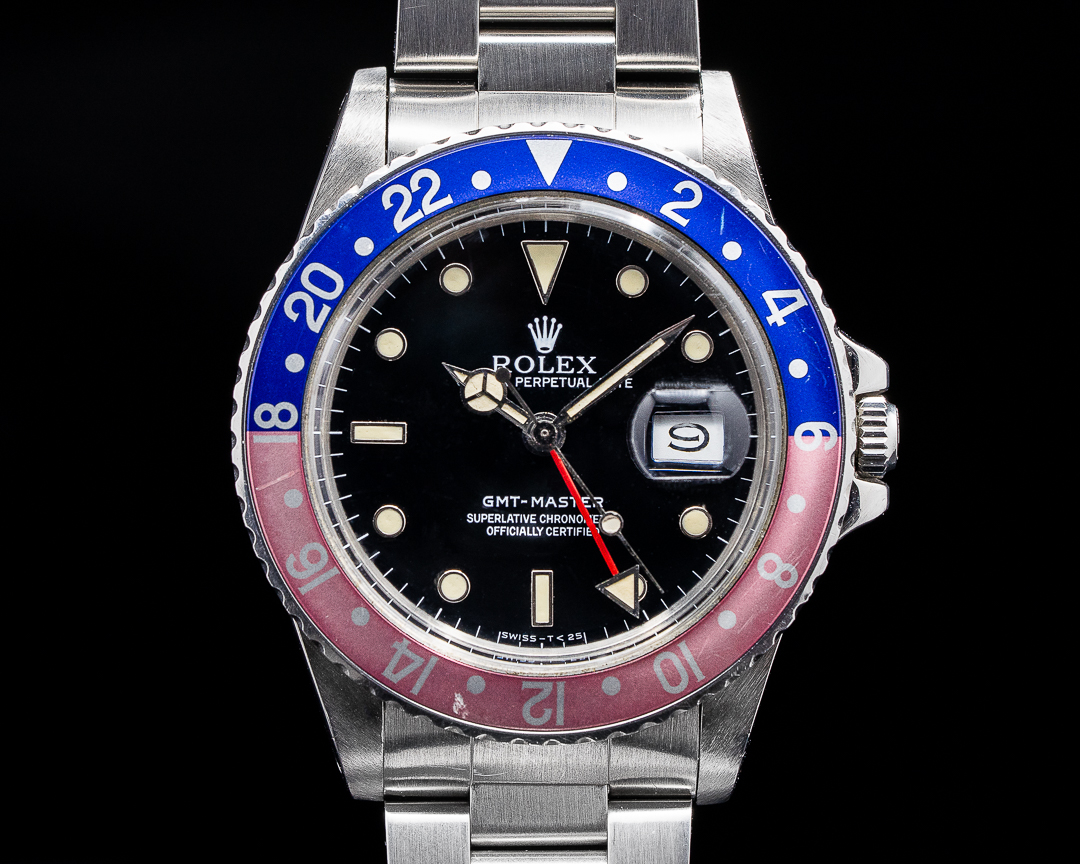

Throughout the late 1970’s and early 1980's many Rolex models went through a transitional period where the components used in earlier references were replaced with newer, more modern ones. The ref. 16750 was introduced in 1979 and is now considered to be the “transitional” GMT model. The new reference featured an updated caliber 3075 movement that beat at 28,800 bph as opposed to the 19,800 bph of earlier calibers. A quickset date function and hacking seconds made their first appearance in the model line and the water resistance was upgraded from 50 to 100 meters. The 16750 had two dial variants over its 9 year run: the first was matte black with simple tritium hour markers followed by a glossy black dial with luminous indices and white gold surrounds. You could also buy the watch with the traditional red and blue “Pepsi” bezel or with an under-the-radar, all-black version instead.
In 1988, Rolex released the final GMT Master model, the ref. 16700, with an updated caliber 3175 movement and a sapphire crystal. The model remained in production until 1999 and served as a lower priced alternative to the GMT Master II which was released in 1983.
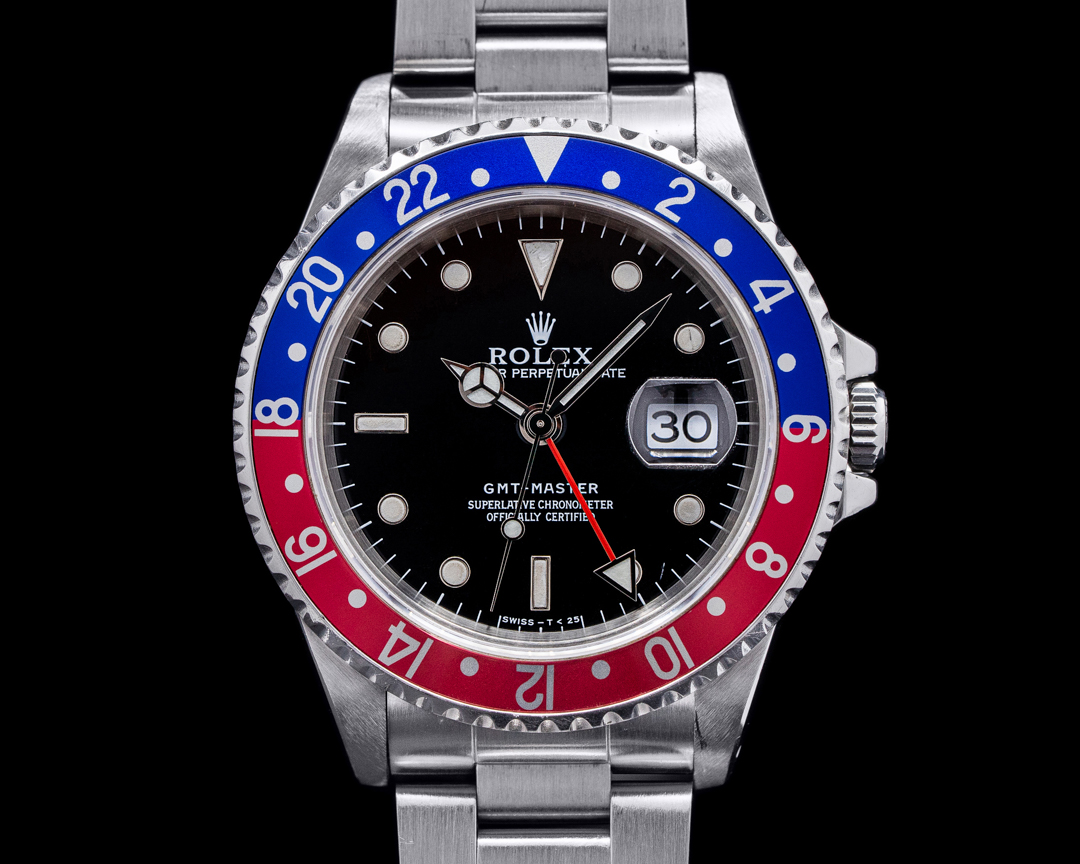
THE GMT MASTER II
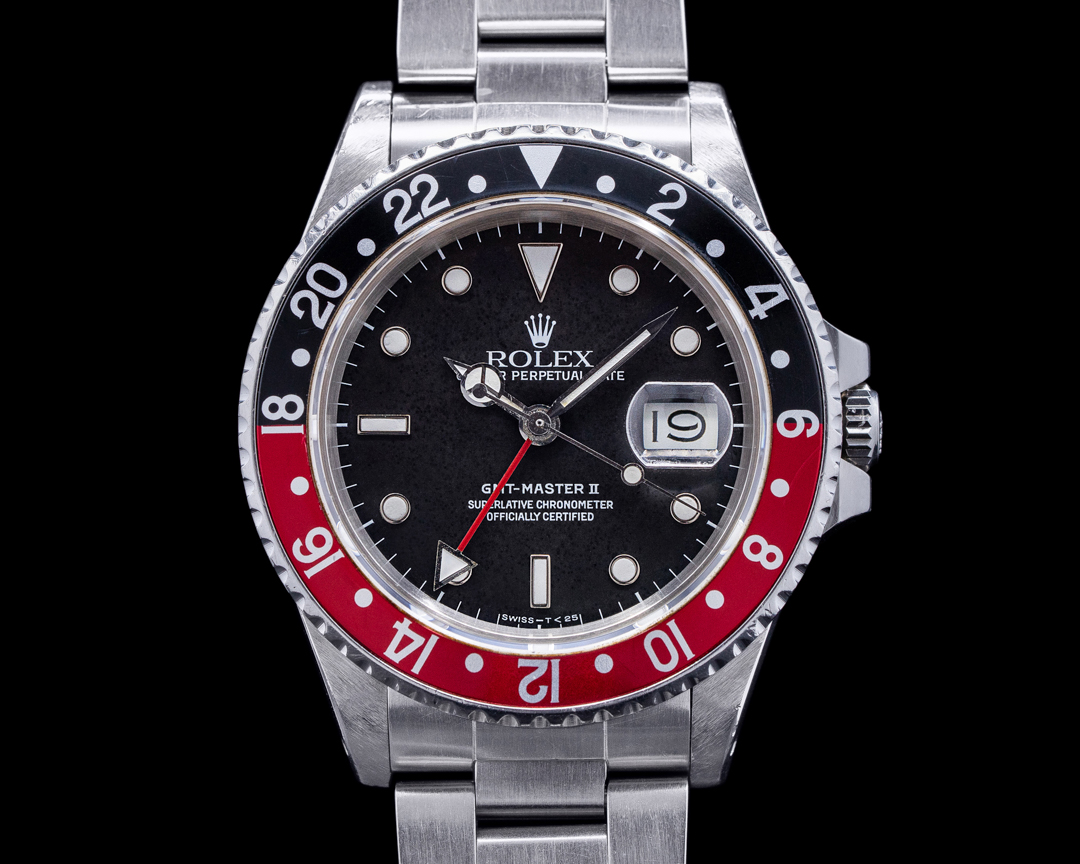
In 1983, the ref. 16760 GMT Master II was introduced. Utilizing a new caliber 3085 movement, the 16760 had an independently adjustable hour hand that could be set without stopping the movement or disturbing the minute or 24-hour hand. Combined with the bezel, the user could now track three different time zones. The new capabilities of the 3085 movement made it thicker than earlier calibers which, in turn, required the case of the 16760 to grow larger as well from 12mm to 12.5mm. This increased thickness led to the ref. 16760 GMT Master II earning the nickname "Fat Lady." The model had luminous white gold indices and a sapphire crystal with a distinctive red and black "Coke" bezel.
In 1985, Rolex began making its cases and bracelets using 904L stainless-steel, an alloy with advanced anti-corrosion properties and a unique patinated sheen after polishing. Closely related to the 316L steel used in the aerospace, medical, nuclear, and chemical industries, it would be called "Oystersteel” after 2018. Rolex was the first watchmaker to use 904L for its cases.
NOTABLE GMT MASTER II ADVANCEMENTS
1989 - The ref. 16710 was released featuring a new caliber 3185 movement which maintained the same capabilities of the caliber 3085 found in the 16760 now in a slimmer, more compact package. This reworked movement allowed the case thickness to be reduced to 12mm. In production until 2007, there were a number of dial variants made with tritium, LumiNova, and Super LumiNova all used.
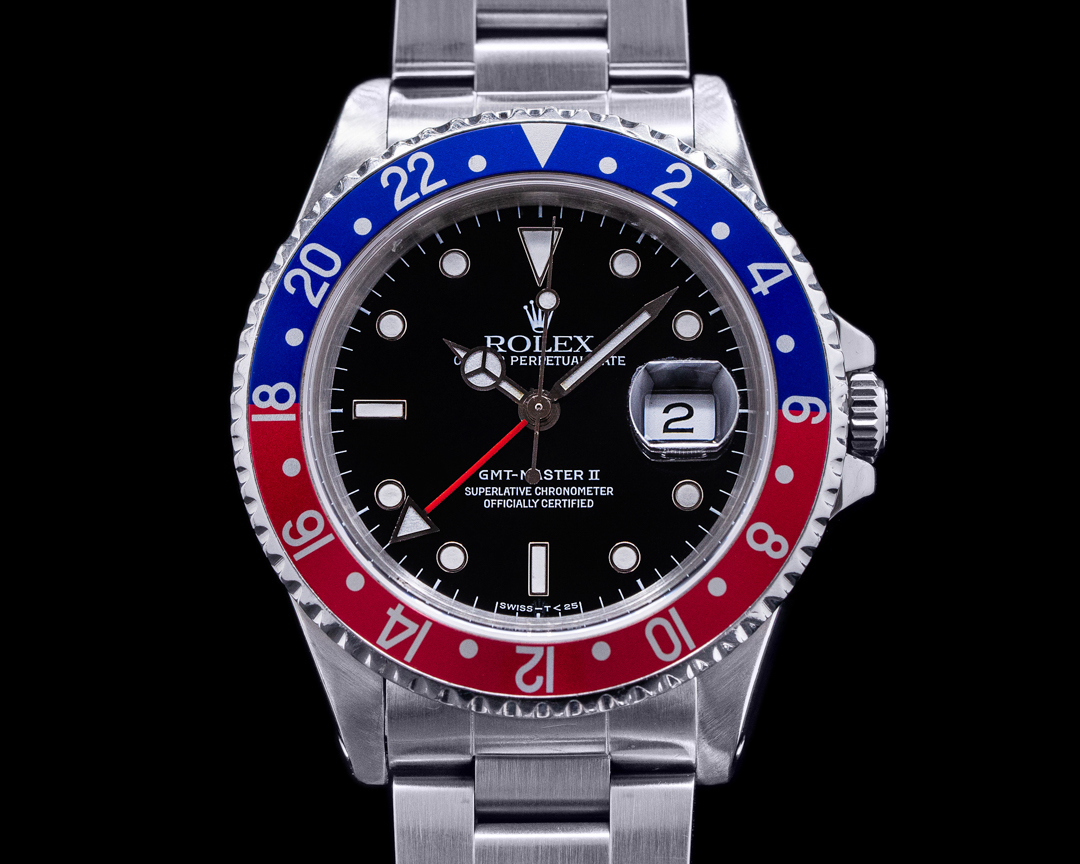
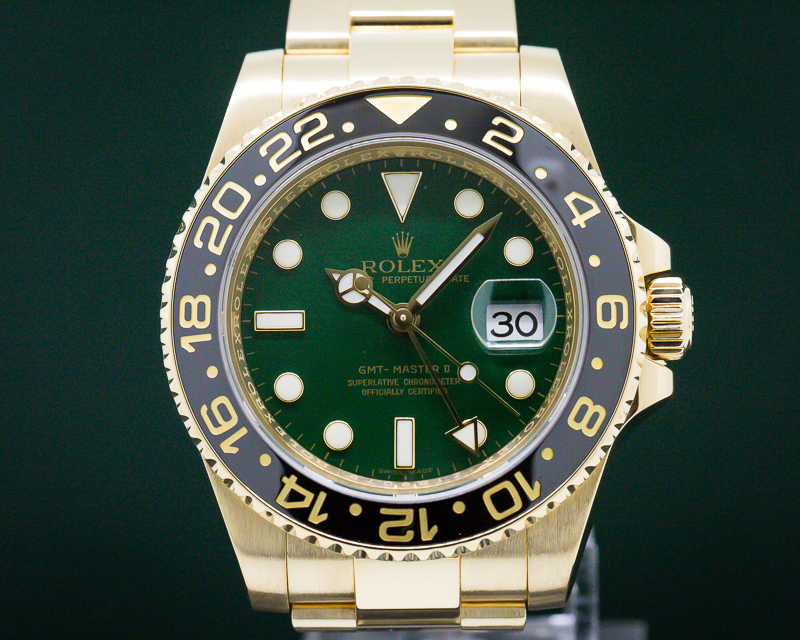
2005 - To celebrate the 50th anniversary of the GMT Master line, Rolex released the ref. 116718LN GMT-Master II. Available in solid 18k yellow gold with a distinctive green dial, this model introduced a significantly larger case (40mm in diameter, 12mm thick) with thicker lugs, a solid bracelet and endlinks, redesigned clasp, a larger handset and hour indices, and was powered by the new caliber 3186 movement that used a Parachrom hairspring that was 10 times more antimagnetic and shock resistant than its predecessor. This was also the first appearance of Rolex’s Cerachrom ceramic bezel insert which would go on to be used across the entire Rolex model lineup.
2007 - A stainless-steel version of the 50th anniversary model, the ref. 116710LN was released. Featuring the new larger case, maxi dial and cal. 3186 movement, the new model also had an anti-reflective Cyclops magnifier, green GMT hand, and an all-black Cerachrom ceramic bezel (with 24 clicks instead of 120).


2013 - Rolex released the ref. 116710BLNR, nicknamed the “Batman”, which featured a bi-color black and blue ceramic bezel. This was the first Rolex ceramic bezel with two different colors, a result achieved using a proprietary patented process.
2014 - Absent from the GMT model line since 2007 when the ref. 16710 was discontinued, Rolex brought back the iconic “Pepsi” bezel when they released the white gold ref. 116719BLRO. Powered by the caliber 3186 movement, this was the first GMT cased in white gold.

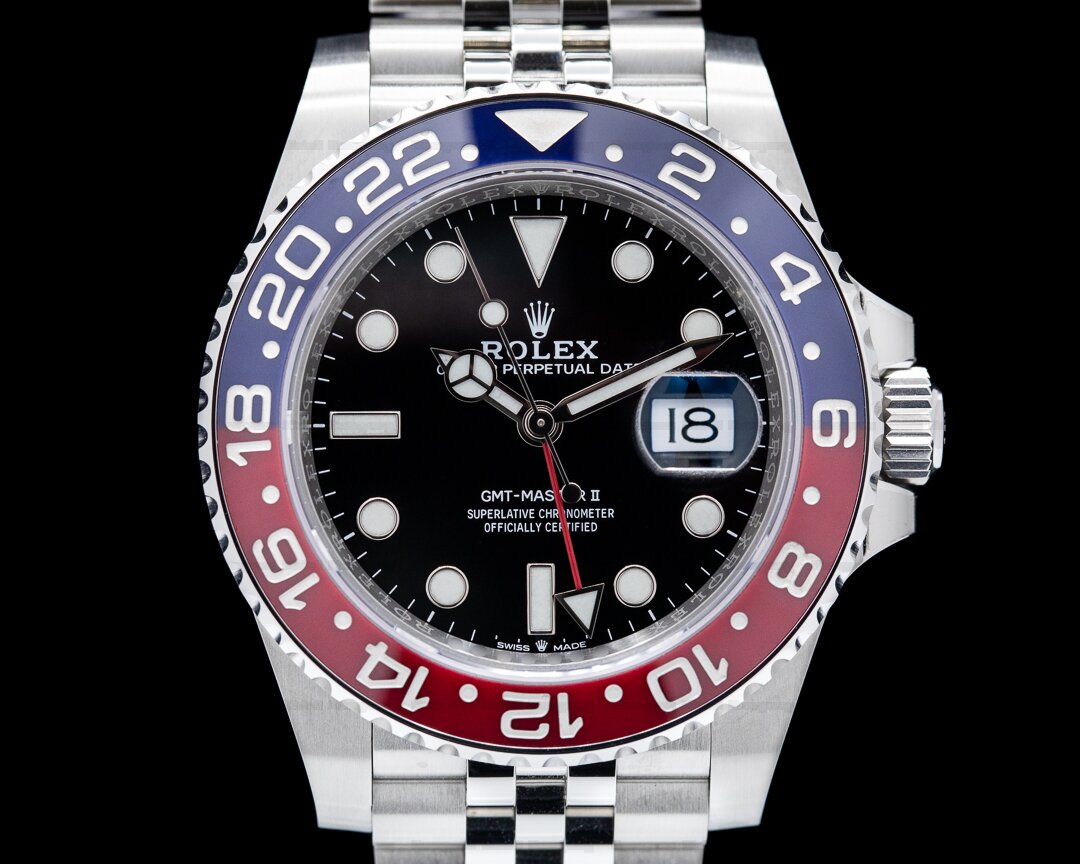

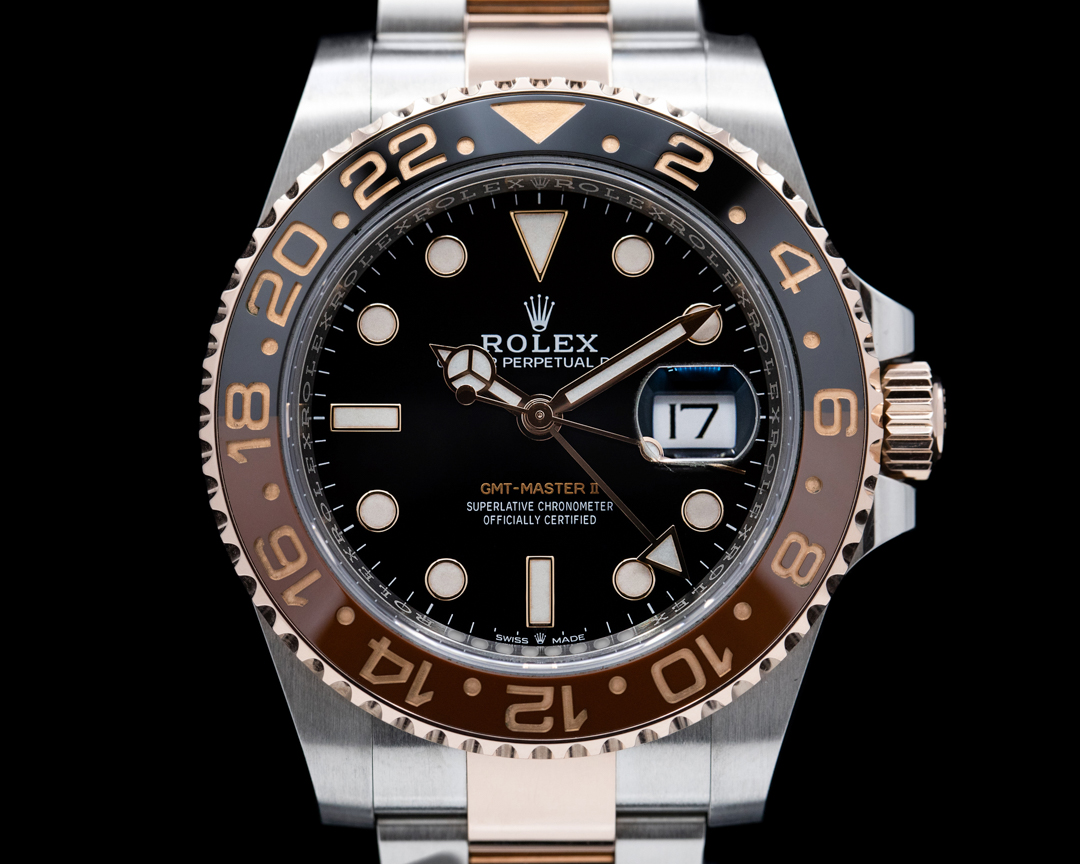
2018 - Baselworld 2018 was a big one for Rolex with several new models hitting the lineup. First up was the new stainless steel ref. 126710BLRO “Pepsi” GMT. Powered by the all new caliber 3285 movement with Rolex’s patented Chronergy escapement which offered an extended 70-hour power reserve, the model featured the red and blue bezel of the earlier white gold GMT and a stainless steel Jubilee bracelet. Also released in 2018 were the solid rose gold ref. 126715CHNR Everose GMT Master II and the ref. 126711CHNR in two-tone steel and rose gold with a black and brown ceramic bezel that quickly earned the Root Beer nickname.
Rolex discontinued the white gold black dial ref. 116719BLRO and replaced it with the ref. 126719BLRO which featured a white gold case, blue dial, and was powered by the caliber 3285 movement.
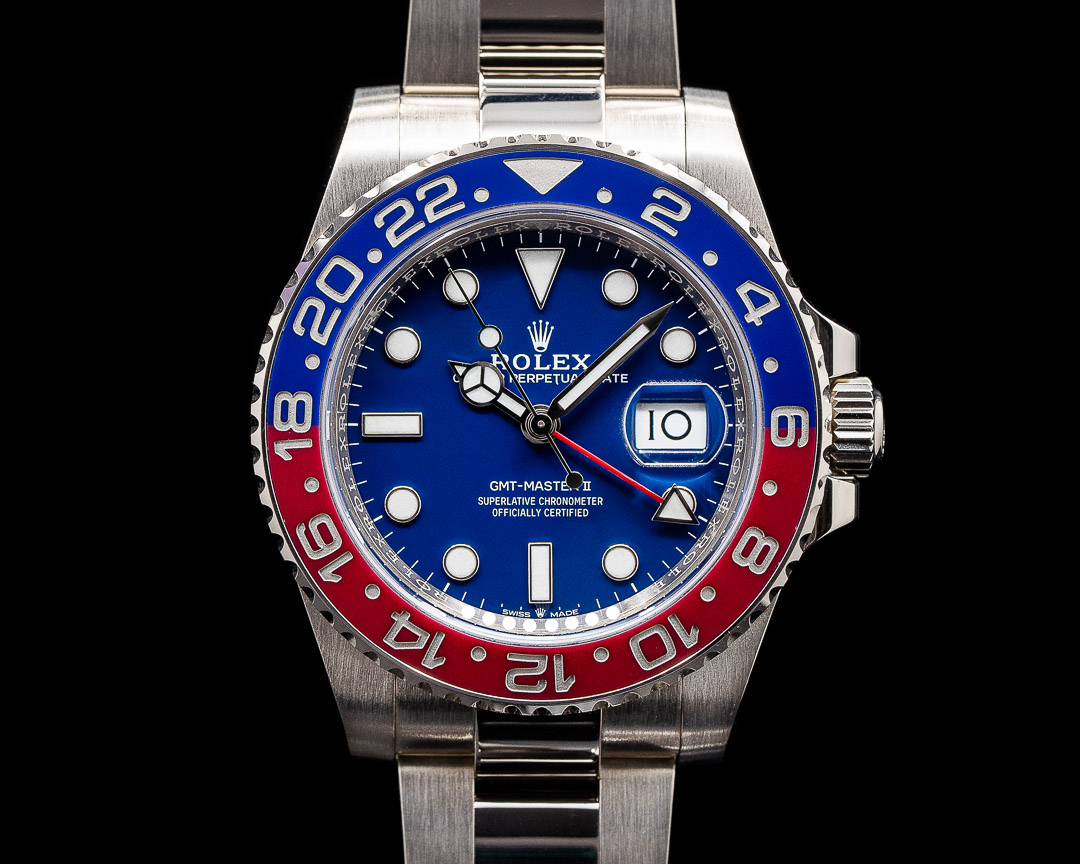
2019 - The updated ref. 126710BLNR GMT-Master II with black and blue bezel and a Jubilee bracelet is released. Technically the same as the "Pepsi" GMT-Master II released in 2018, the new model was nicknamed the “Batgirl” to differentiate it from the original “Batman” that was sold on an Oyster bracelet.
Pearlmaster

With a nod of competition to Patek Philippe's Ladies Twenty-4 collection and Omega’s Ladies Constellation line, Rolex introduced the all-new Pearlmaster in 1992. Initially available in 29mm and 34mm sizes, the Pearlmaster featured softer lines than Lady Datejust models and was offered with dials, bezels, and even bracelets set with precious stones including diamonds, rubies, and sapphires. Rolex fashioned the model’s bracelets using solid rounded 18K gold or platinum links for comfort and concealed, ultra-refined "Crownlock" clasps with Rolex crown emblems. These magnificent and creative versions of the Datejust were Rolex’s gem-setting department’s tour de force and were some of the most expensive Rolex models ever produced.
Yacht-Master
After failing to introduce an all-new model since the Daytona in 1964, Rolex went back to the drawing board in 1992 to design the new Yacht-Master line. As a longtime sponsor of many famous offshore regattas, this model further cemented the ties between the company and the sailing world, offering competitive racers with an Oyster Perpetual model specifically dedicated to their passion.
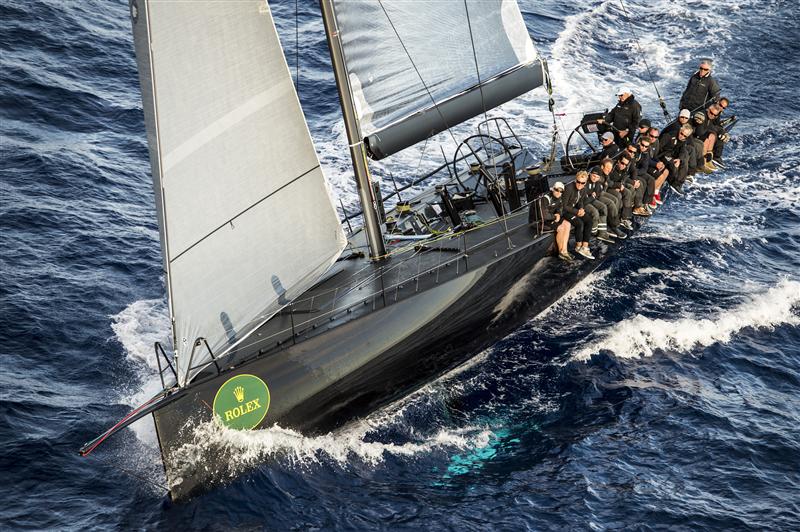
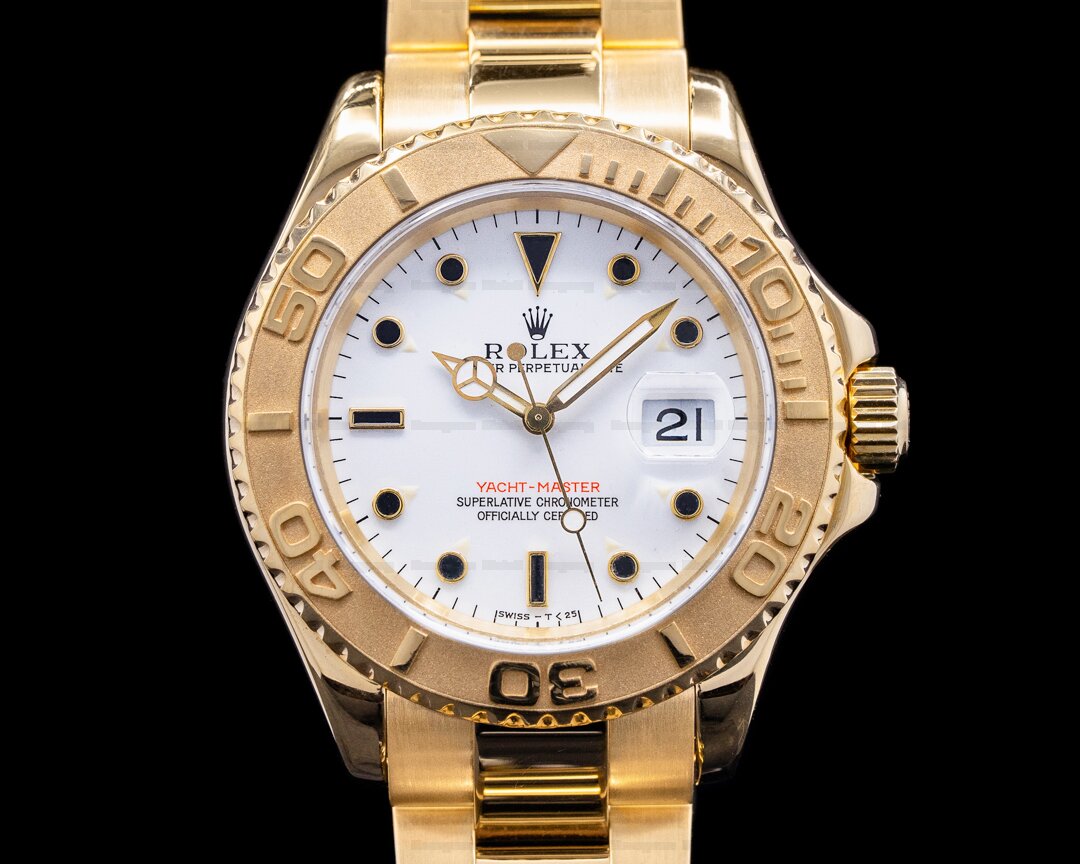
The initial iteration of the model, the ref. 16628, featured a 40mm case made of solid 18k yellow gold with a 60-minute bezel designed to sync with race start times, a white dial with luminous yellow gold hands and black hour markers, date aperture with a cyclops magnifier, a Triplock crown, 100 meters of water resistance, and a caliber 3135 movement. Positioned in the Rolex lineup as a more luxurious version of the Submariner, the model was an immediate success.
In 1994, Rolex introduced the 29mm ref. 69628 for ladies and the ref. 68628, a mid-size 35mm variant. Further expanding the model line, the platinum and steel “Rolesium” ref. 16622 was released in 1999. The model used a 40mm stainless steel case paired with a platinum bezel with high polished raised numerals on a sandblasted background. The silver dial also featured the same sandblasted texture with a red seconds hand and “Yacht Master” signature. The “Rolesium” Yacht Master was also available in a ladies’ 29mm size (ref. 69622) and a midsize 35mm variant (ref. 68622).

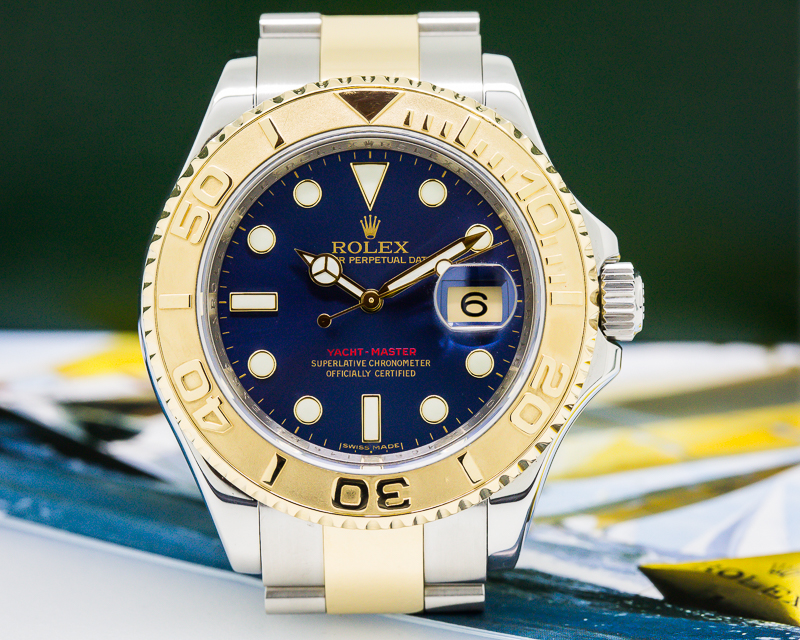
In 2003, the two-tone stainless steel and yellow gold ref. 16623 was introduced. The model was available with a variety of dials from white and gold to dark blue and Tahitian Mother of Pearl and further expanded the new line.
Released in 2015, the ref. 116655 was the first Yacht Master cased in Everose rose gold and the first Rolex ever to feature the company’s new Oysterflex rubber strap. The model also had a matte black Cerachrom bezel and matching matte black dial with luminous rose gold hands, luminous indices with rose gold surrounds, and a red “Yacht Master” signature. The 37mm ref. 268655 ladies’ version was also introduced in 2015.
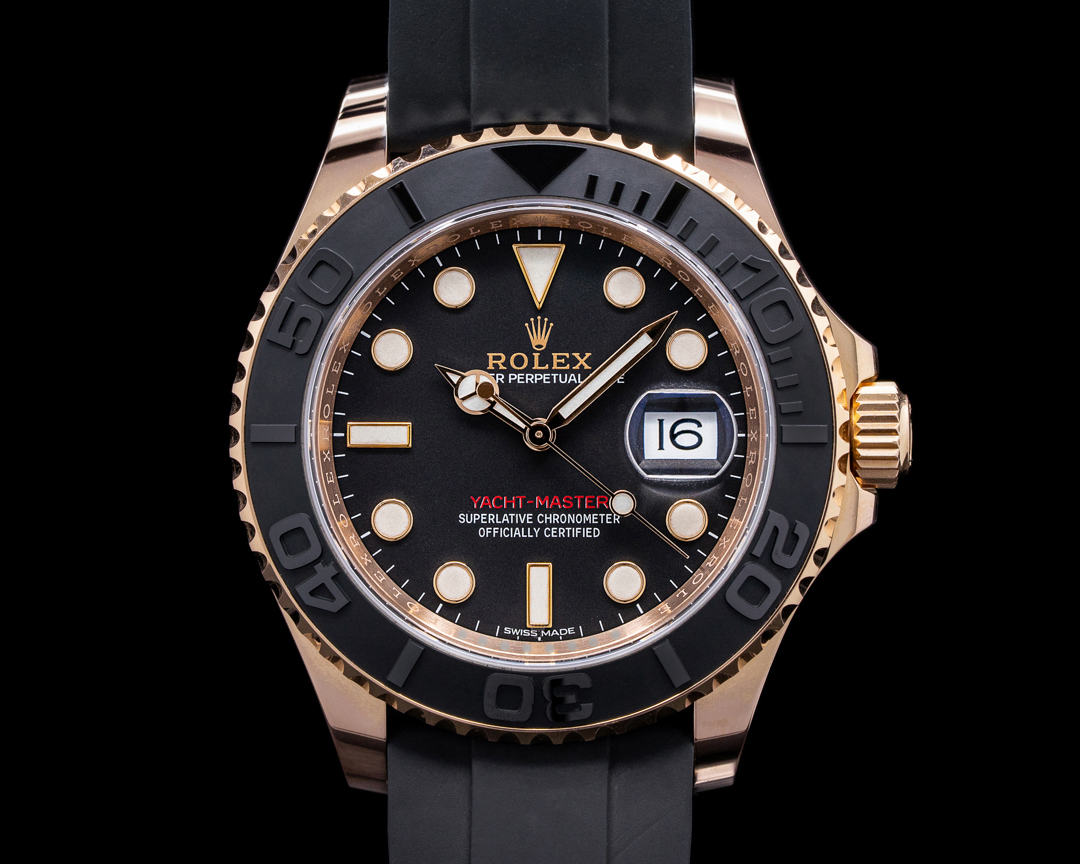
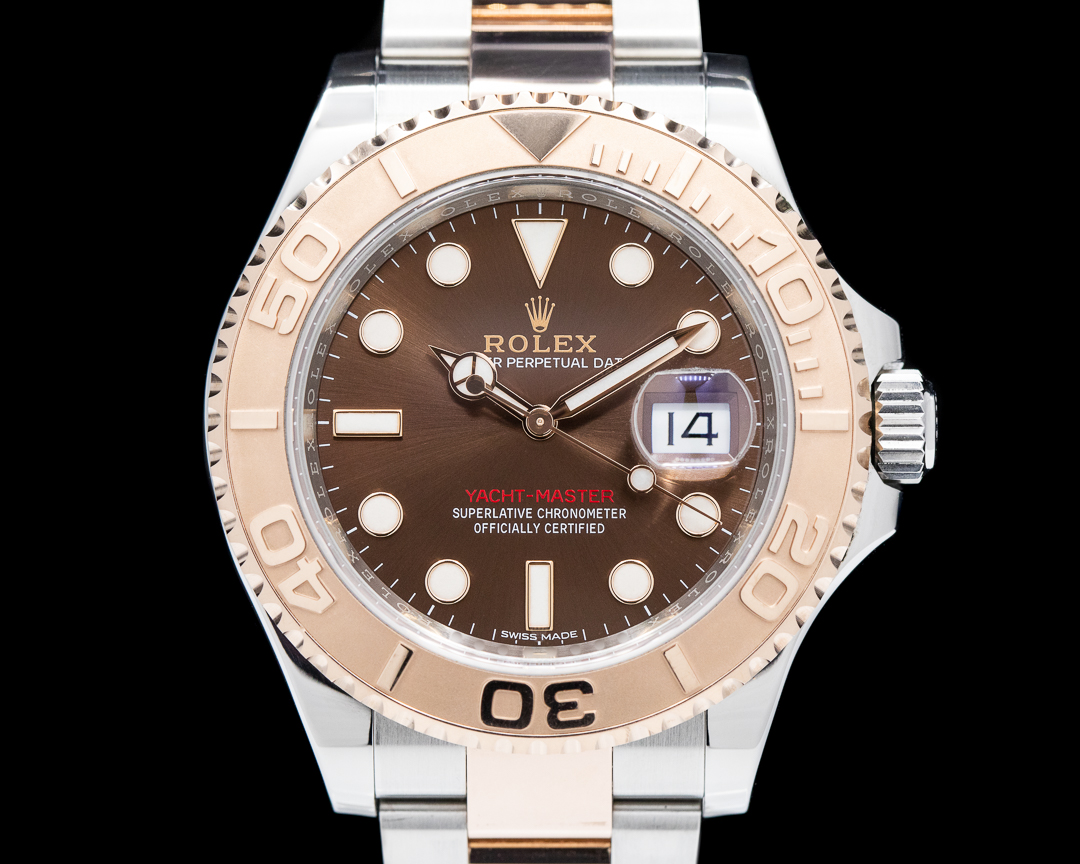
Introduced in 2016, the ref. 116621 brought a two-tone model back to the lineup. Featuring a rose gold and stainless steel case and bracelet, the model had a rose gold bezel with high polished raised numerals on a sandblasted background, a black dial with red accents, and rose gold hands and hour marker.
At Baselworld in 2019 Rolex debuted an updated collection of 40mm Yacht Masters all powered by the new caliber 3235 movement with an increased power reserve of 72-hours. The company also introduced a completely new model, the 42mm white gold ref. 226659 at the 2019 show. The first Yacht Master ever cased in white gold, the new model featured a matte black Cerachrom bezel, black dial, Oysterflex strap, and a caliber 3255 movement.
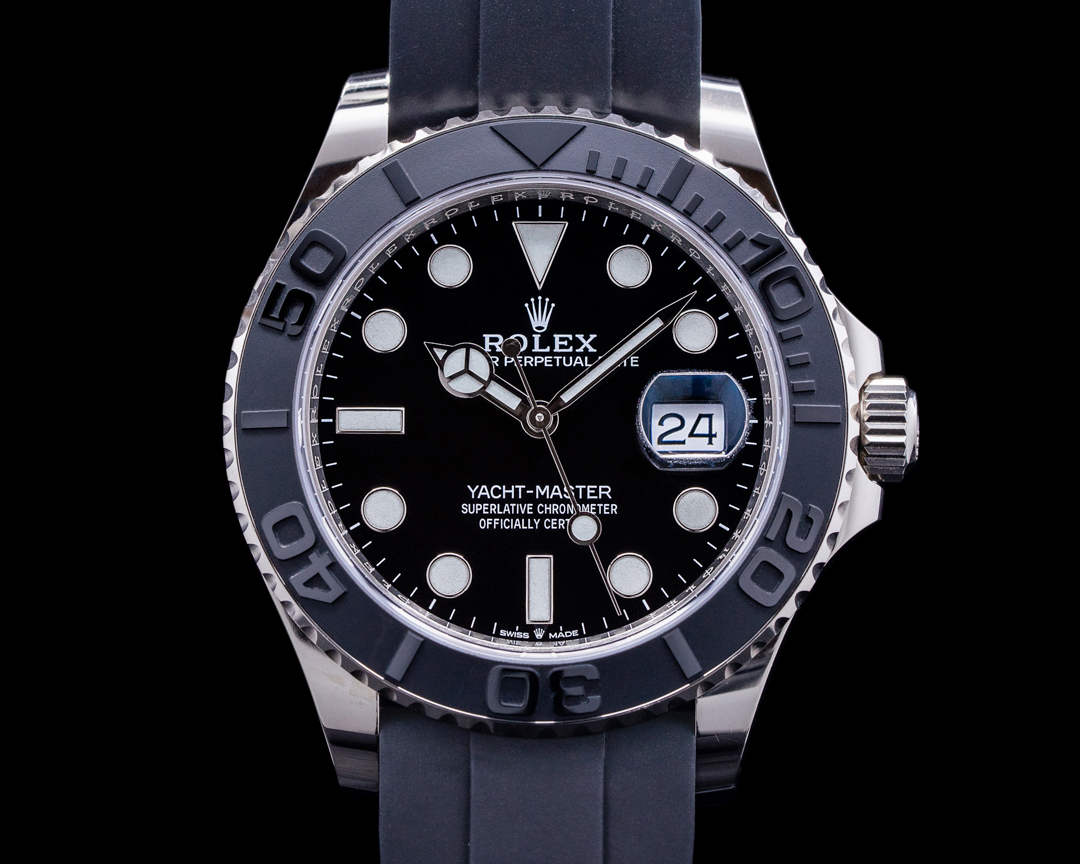
Yacht-Master II
Launched in 2007, the Yacht-Master II bore little resemblance to the standard Yacht Master model beyond its name and was one of the most expensive and mechanically complicated Rolex models ever produced. Initially available in solid 18k yellow gold (ref. 116688) or white gold and platinum (ref. 116689), the Yacht Master II was a true tool watch, albeit a very luxurious one. Designed to help boat skippers keep track of time during the complicated starting sequence of a regatta and to synchronize their boats’ movements with the race’s starting gun, the watch was powered by the caliber 4160 movement which offered a programmable timer with a 10-minute regatta countdown scale set using Rolex’s patented Ring Command bezel. A two-tone steel and Everose gold model, the ref. 116681, was released in 2011 and an all-steel version, the ref. 116680, followed in 2013 powered by the slightly updated caliber 4161 movement.


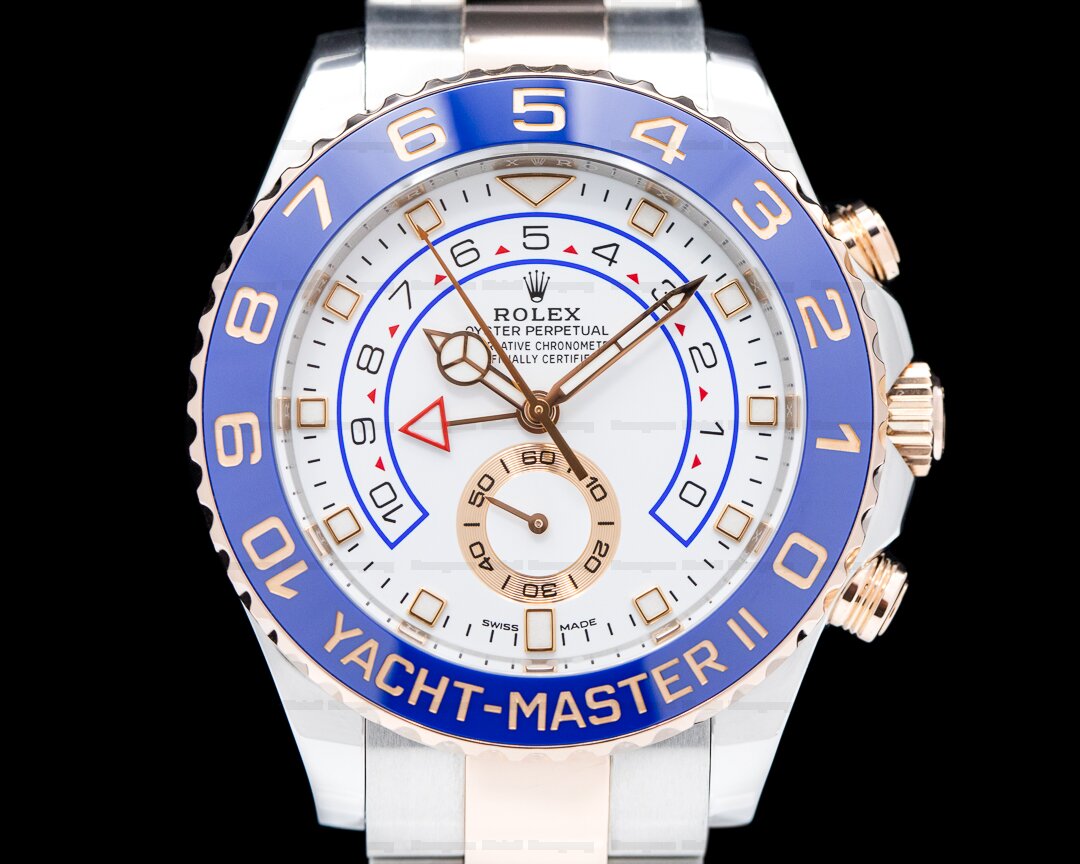
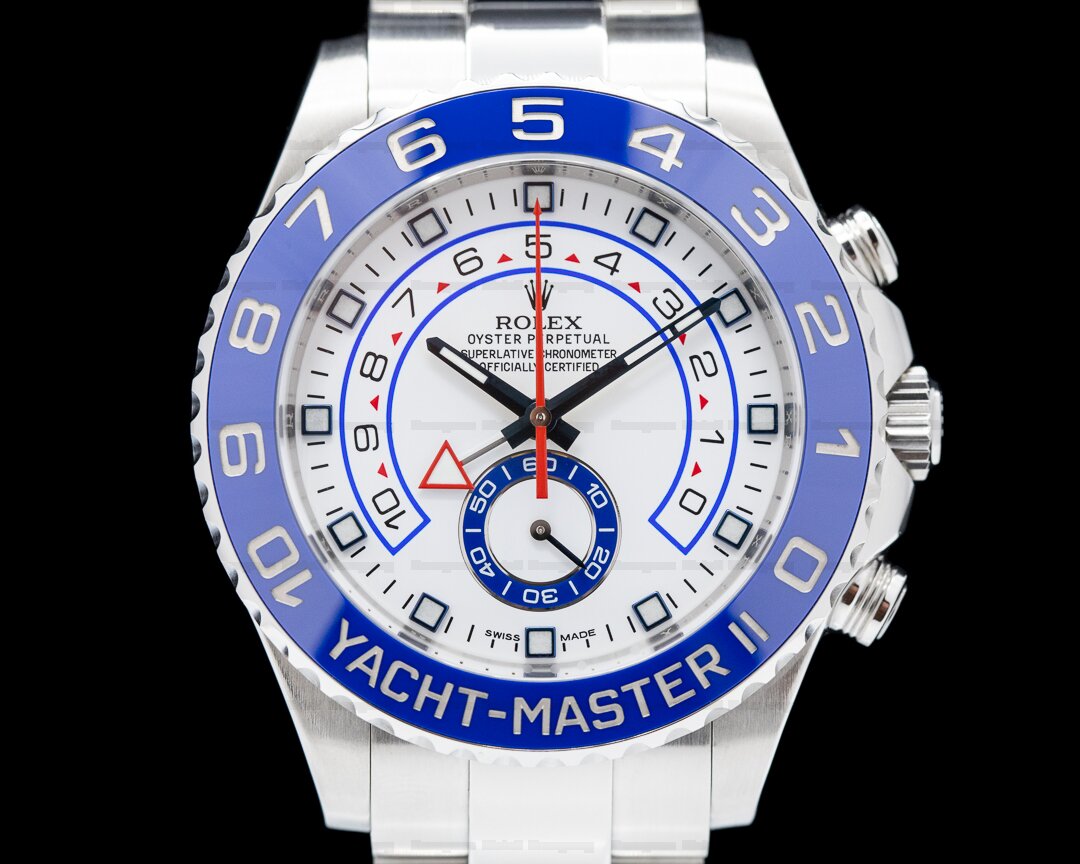
Sky-Dweller
Another completely fresh model for Rolex, the all-new Sky Dweller debuted at the Baselworld exhibition in 2012. The watch was a true technological tour-de-force, and like the original GMT Master, was created specifically with world travelers in mind. Three initial variants were released including the ref. 326938 featuring a yellow gold case and matching bracelet, the ref. 326939 featuring a white gold case with a matching bracelet, and the ref. 326135 featuring an Everose gold case on an alligator leather strap.
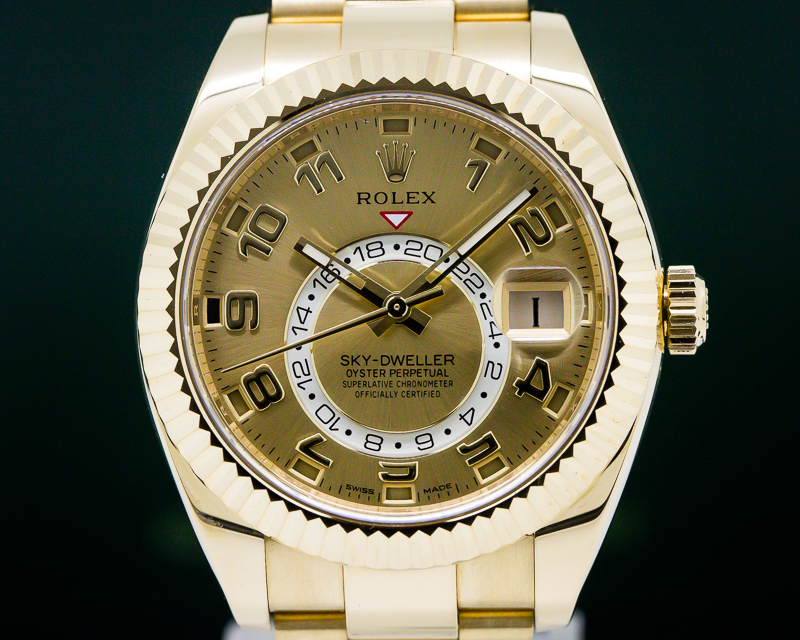
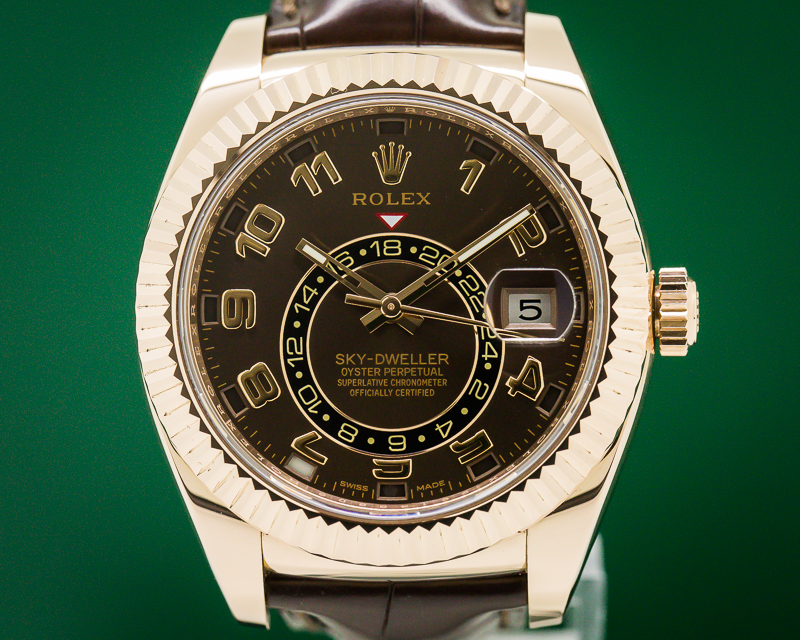
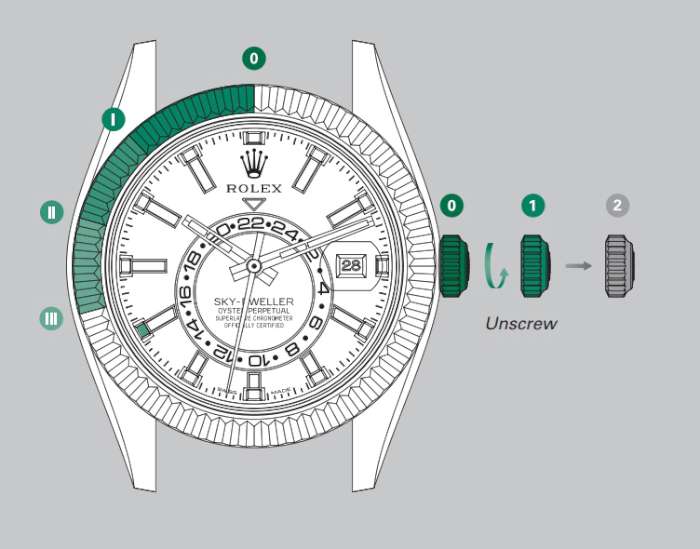
The new Sky-Dweller featured a large 42mm case, caliber 9001 movement with a 72-hour power reserve, and an easily readable radial GMT/dual time zone display combined with an innovative annual calendar called "Saros”. The “Saros” mechanism had two gear ratios and four gear wheels that were added to the traditional Rolex date calendar. The classical name honors the Greek concept of the 18-year earth, sun, and moon cycle recording solar and lunar eclipses. It only requires a single date adjustment each year in February. Similar to the Yacht Master II, the Sky Dweller utilized the rotatable "Ring Command" bezel for adjusting the date, local time, or GMT.
The Sky Dweller was Rolex's first annual calendar watch with dual time zones. The time is exhibited by the center hands, and the date shows through the traditional aperture window with a cyclops magnifier at 3 o'clock. Small rectangular windows located outside of the Arabic hour markers indicate the month. A red arrow above a 24-hour disc indicates the second time zone.
In 2014, Rolex expanded the model line by adding more strap and dial options such as a black dial on the white gold Sky-Dweller and a rhodium dial combined with the Everose gold case.

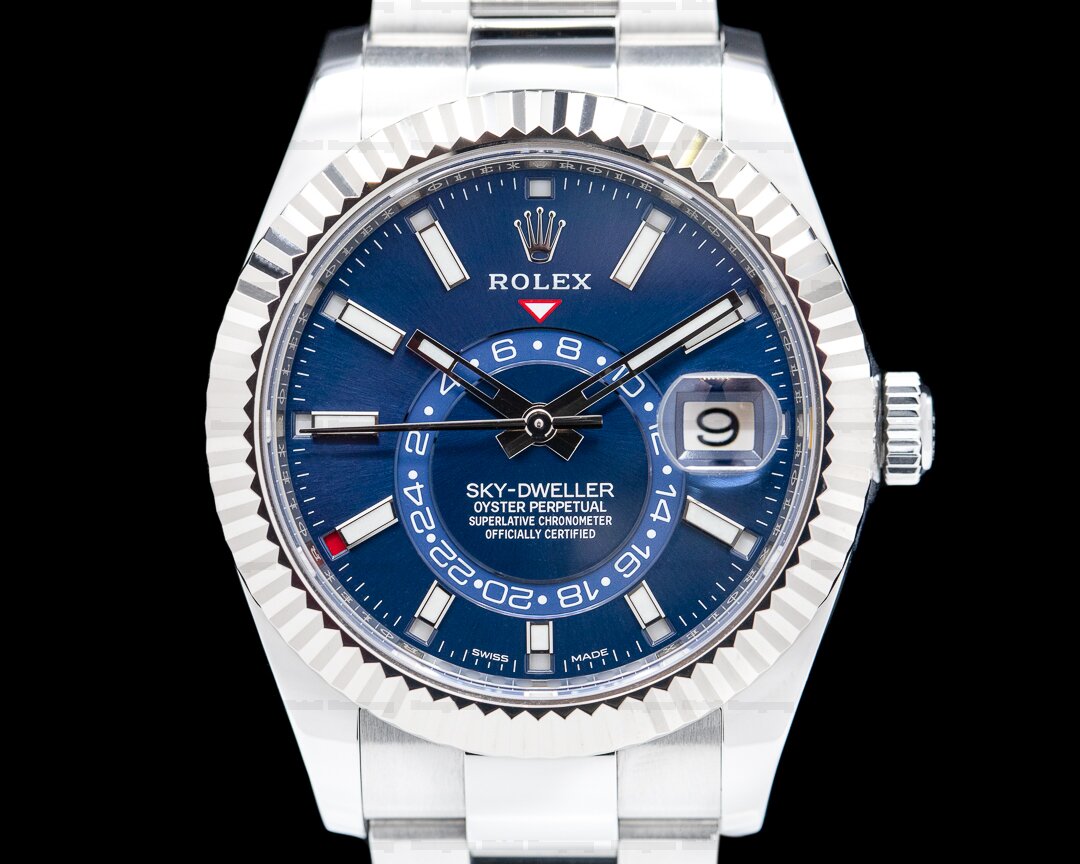
In 2017, Rolex addressed criticism that the Sky-Dweller was too pricey and only available in precious metal by introducing a two-tone "entry level" stainless steel and 18k yellow gold model with a white or black dial (ref. 326933) and a two-tone stainless steel and white gold model with a white, black, or the highly desirable blue dial (ref. 326934). The hour markers were also changed from Arabic numerals to cleaner, sleeker luminous batons.
In 2021, Rolex made the stainless steel and Rolesor models of the Sky-Dweller available with a Jubilee bracelet.
THE INIMITABLE ROLEX CELLINI
The brainchild of Rolex Director of Marketing, Rene-Paul Jeanneret, the Cellini model line was the brand’s first designed solely for aesthetics rather than pure functionality. Earlier in his career, Jeanerret had developed the concept of Rolex as a “tool watch” and had convinced his close personal friend, Jacques Cousteau, to help with the development of the Submariner model. By the early 1960's though, his focus had shifted and the goal was now to expand the public’s perception of the brand as more than only a producer of utilitarian pieces. New marketing campaigns popularized the idea of owning several different styles of Rolex models for use in different situations and for different occasions. A major component of this effort was the all-new Cellini line which showcased sophisticated and elegant cases made of precious metals powered mainly by hand-wound, manual movements. Named for the 16th century Italian master goldsmith and sculptor to the Vatican, Benvenuto Cellini, the line was meant to evoke classicism, bold design, and luxury and featured models with names such as Alpha, Midas, Danaos, and Zephyr.
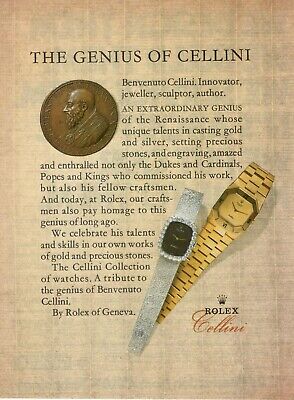
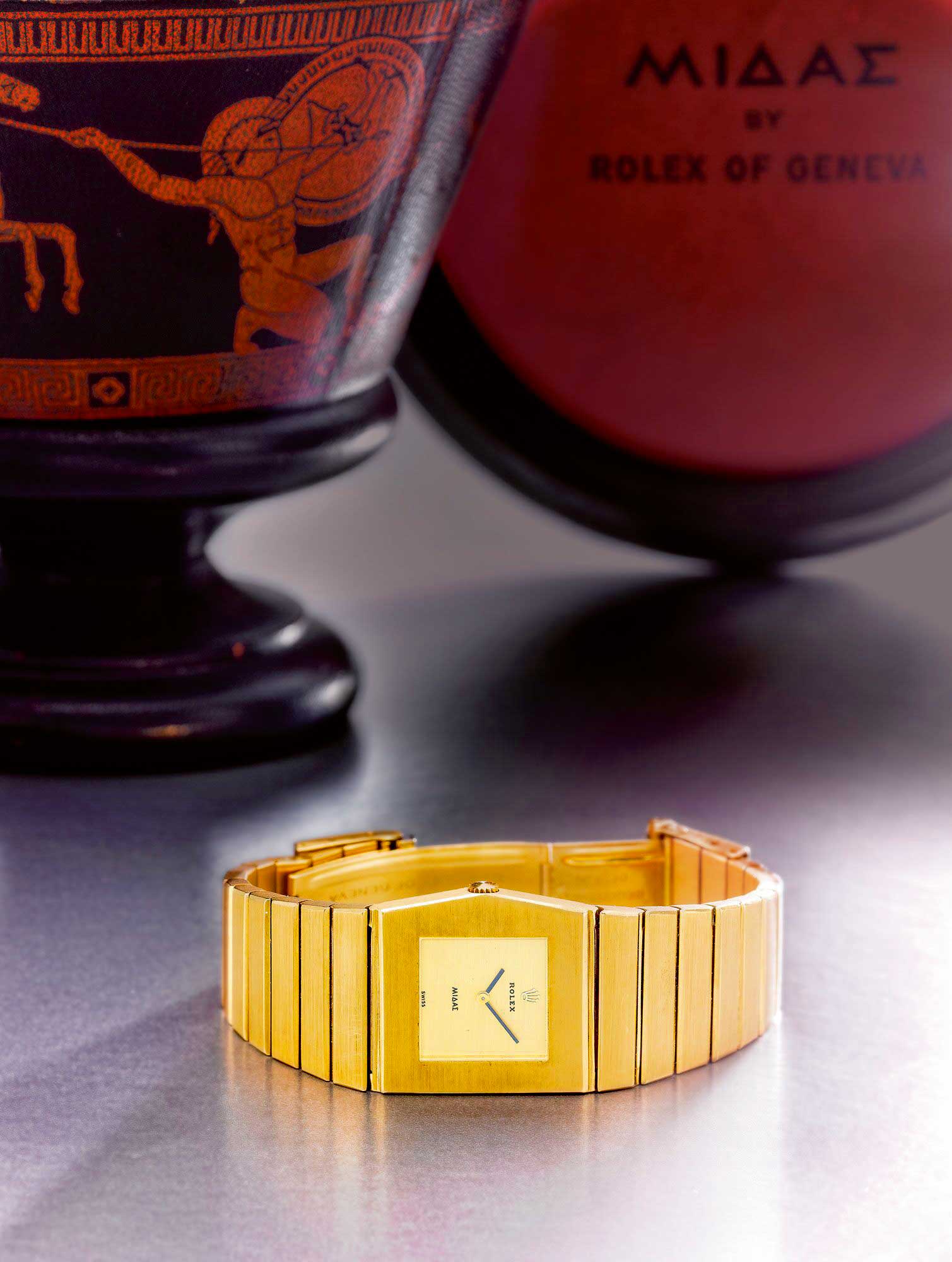
Even though the new collection was not formally introduced until 1968, one of its most notable models arrived in 1962 as the aptly named “King Midas” which was crafted entirely from 18k gold. Although never officially confirmed by Rolex, it is widely believed that the model was penned by legendary designer Gerald Genta. The model featured a radically angular case and integrated bracelet whose shape is thought to have been inspired by the Parthenon in Greece. Fewer than 800 examples of the first series ref. 9630 were produced over the course of a ten-year run between 1962 and 1972, with each and every piece made entirely by hand.
Another king, the King of Rock and Roll, Elvis Presley, notably owned and wore a yellow gold King Midas. Presented to him as a gift by (bizarrely) the Houston Livestock Show in 1970, he was often photographed with the watch on his wrist and the association with the pop idol gained the model a serious amount of cache. Even though the King Midas had an extremely thin case, it was the heaviest wristwatch Rolex made, and it was also one of the first Rolex watches to utilize a scratch-resistant, synthetic sapphire crystal.
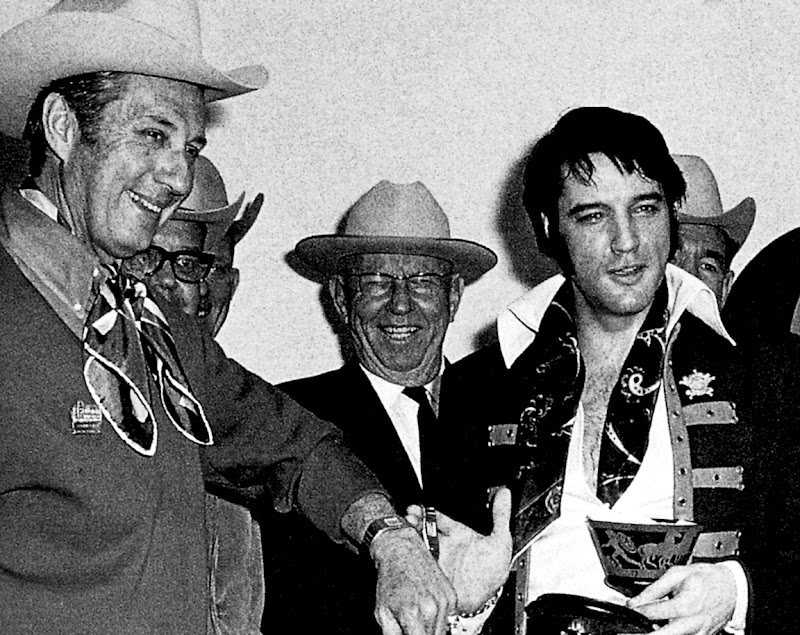
Produced for more than 15 years, there were three distinct generations of the asymmetric King Midas:
- ● 1st Series: Ref. 9630 Produced from 1962-1972
- ● 2nd Series: Ref. 3580 Produced 1972/3-1976 with roughly 500 examples made
- ● 3rd Series: Ref. 4315 Produced 1977-1978/9

Various other models were produced as well featuring diamonds, ribbed cases and bracelets, exotic dial materials, and even variants on alligator leather straps instead of the original gold bracelet.
After the nearly 20-year run of the King Midas and its many variants, Rolex decided to move the Cellini line in a different direction, filling the collection with more traditionally-styled symmetrical models. Pieces like the octagonal ref. 4150, hexagonal ref. 4122, and barrel-shaped ref. 4233 Cellini Danaos blended classic design cues with modern materials and construction giving Rolex collectors a more refined and luxurious option to wear in place of their Submariner or GMT .
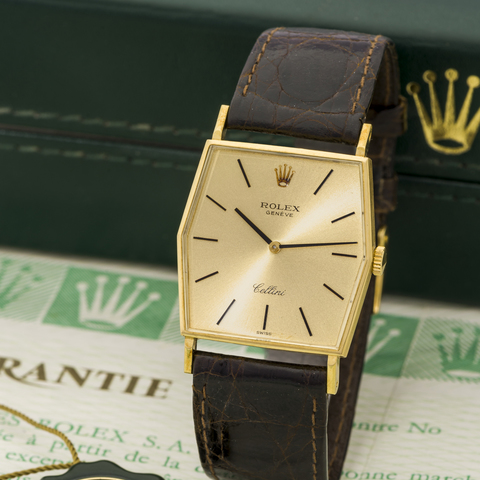

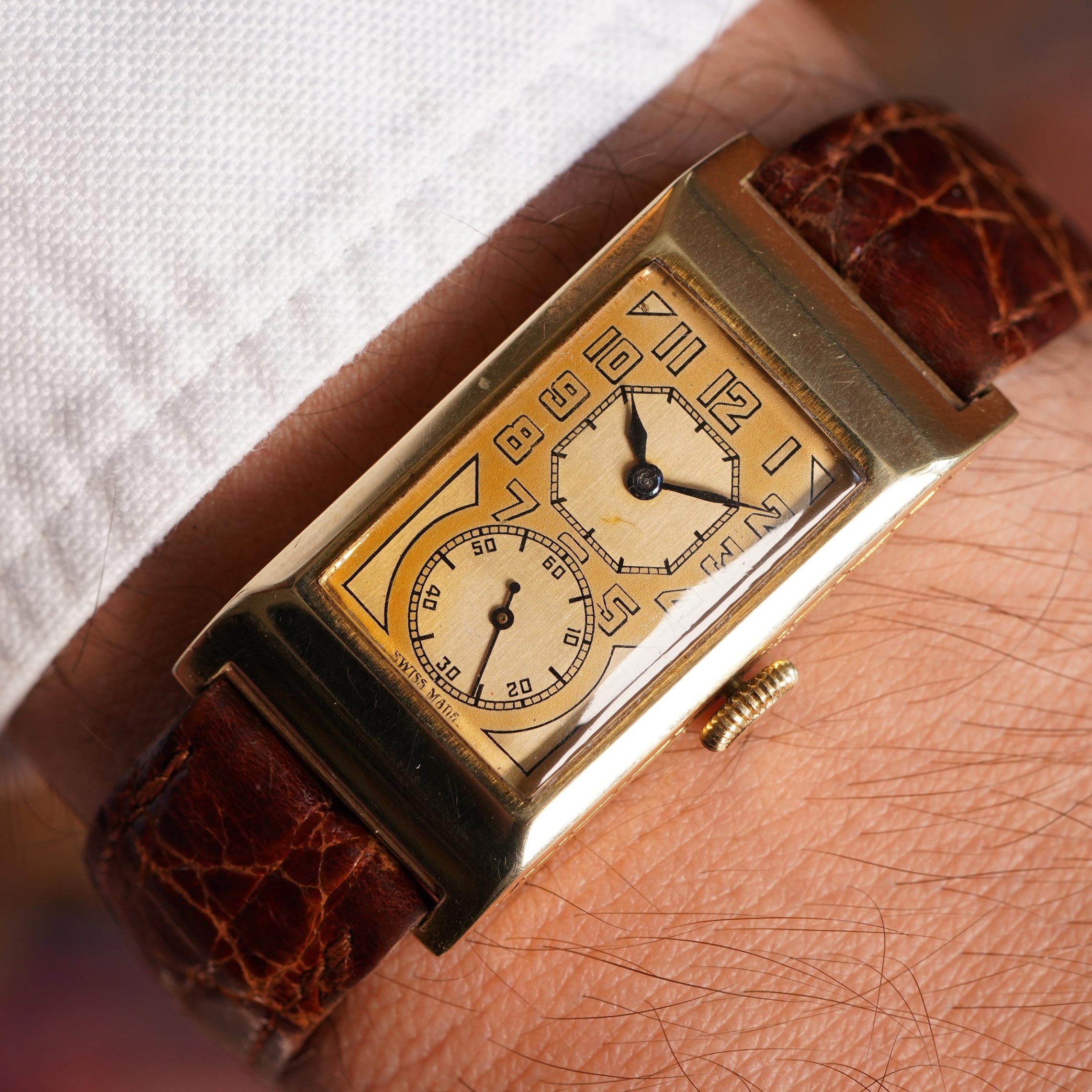
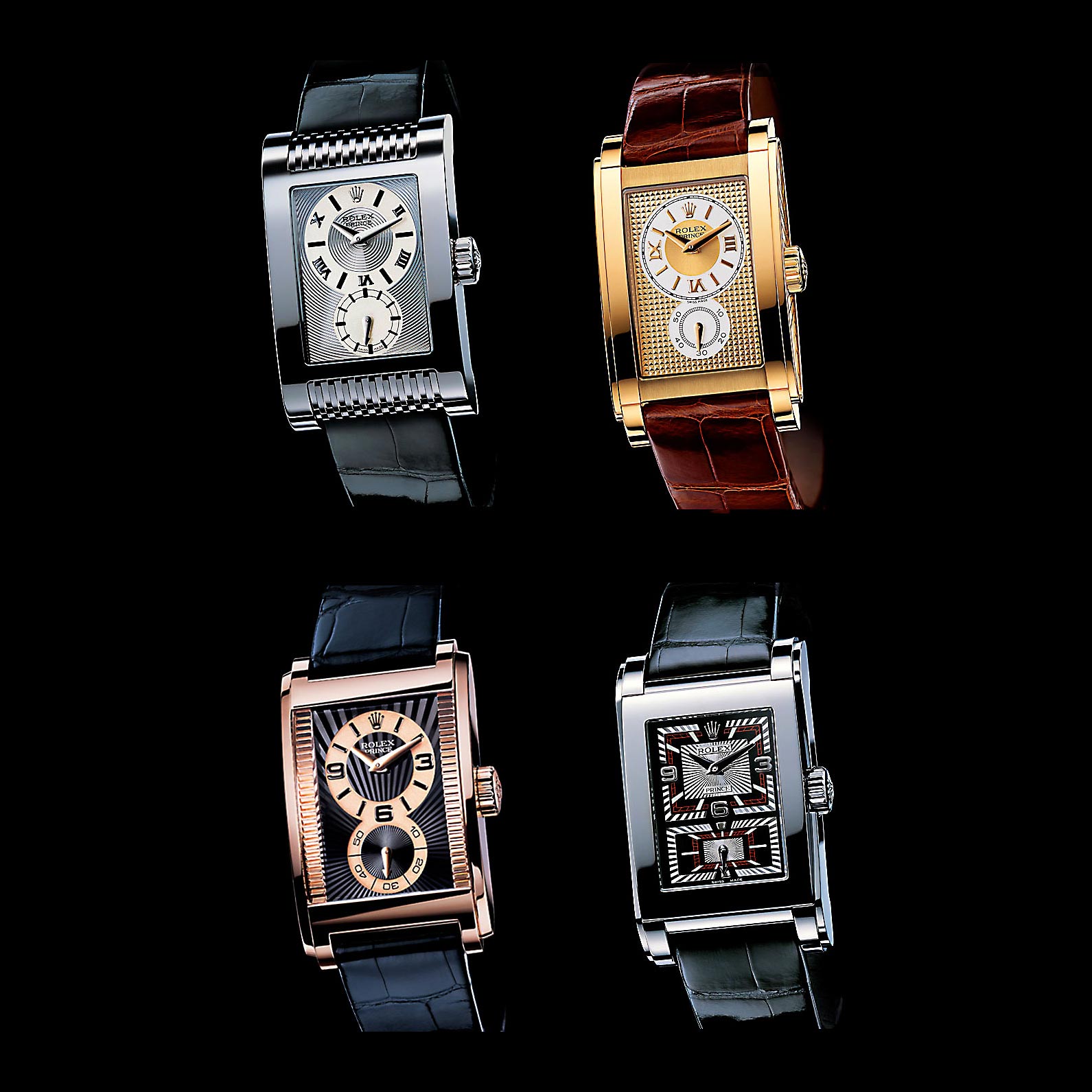
In 2005, Rolex revived the vintage Prince model as part of the Cellini line. The original from 1928 was an Art Deco masterpiece that featured a large rectangular, gently curved tonneau-shaped case with a "figure-eight" style dial featuring a large upper register for the time positioned over top of a smaller seconds register below. The new model was a faithful homage to the original with the only major difference being the increased 47mm x 28mm case size. Available in four configurations (two in white gold, one in yellow, one in Everose), several different styles of dial and case decoration were produced and all variants were powered by the manual-wind Caliber 7040. The Cellini Prince is the only Rolex to feature a sapphire caseback to allow collectors to admire the decorated rectangular manual-wind movement.
In 2014, Rolex revamped the Cellini line introducing the Cellini Time, Cellini Date, and Cellini Dual Time models. All three featured 39mm cases, screw-down winding crowns, fluted casebacks, chronometer certified automatic movements and 50 meters of water resistance.


2017 saw the introduction of another new model, this time with a complication that Rolex had not produced since the 1950's – the Cellini Moon Phase ref. 50535. The model projects the full and new moon on a blue enamel disc at 6 o'clock with a meteorite applique for the new moon, and a silver ring signifying the full phase. With zero adjustment, the moon module will remain accurate for 122 years! As of 2022, the ref. 50535 Moon Phase in Everose gold is the only Cellini model that remains in production.
LOOKING TO THE FUTURE
In 2002, the company created the Rolex Mentor and Protégé Arts Initiative to “aid in the transmission of artistic knowledge and craft from one generation to the next”. The program seeks out gifted young artists from all over the world and brings them together with artistic masters for a period of creative collaboration in a one-to-one mentoring relationship. Since 2002, more than 50 mentors and protégés in dance, film, literature, music, theater, visual arts and architecture have been paired. Mentors and protégés are asked to spend a minimum of six weeks together to learn from each other, create, and grow. Creative luminaries such as Spike Lee, Tiger Woods, Lin-Manuel Miranda, Alfonso Cuaron, and Martin Scorsese have all participated in the program.
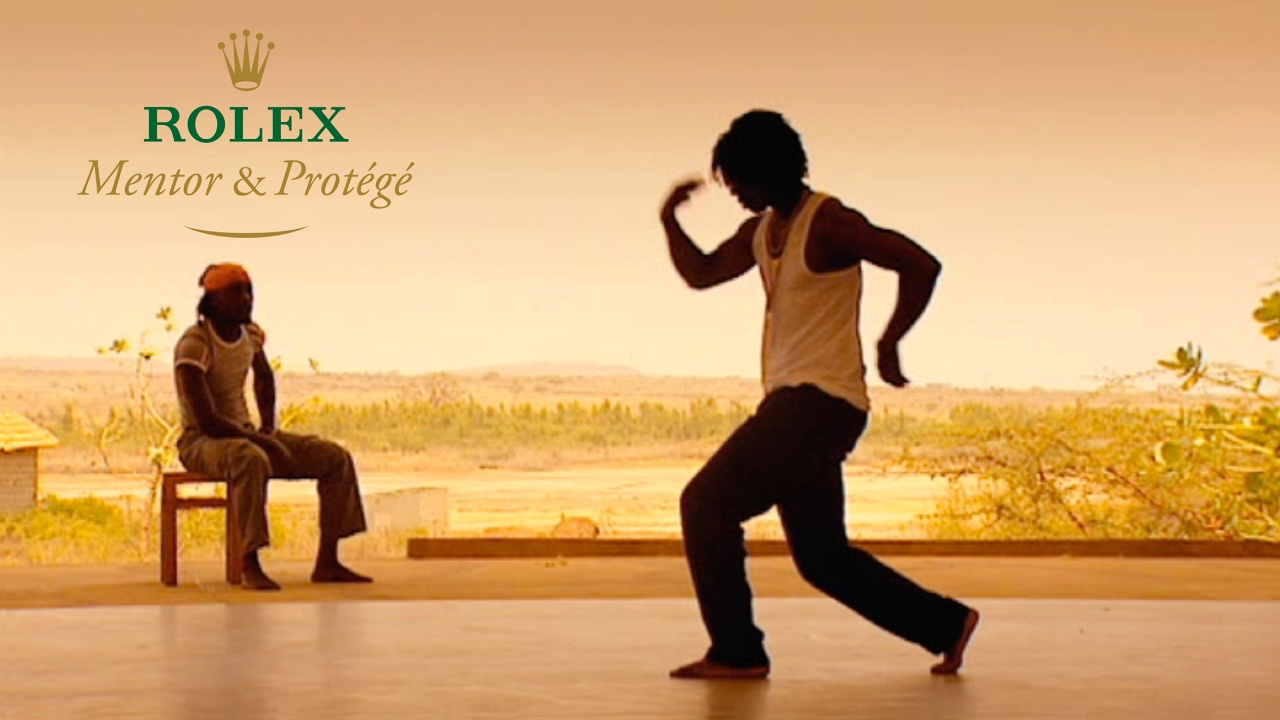
In 2019, Rolex launched a program called Perpetual Planet designed to continue Hans Wilsdorf’s legacy by supporting the explorers of today on a new mission: to make the planet perpetual. As part of the program, the company has partnered with the National Geographic Society to specifically focus on the impacts of climate change and they have also enhanced the brand’s long running support for biologist Sylvia Earle’s Mission Blue initiative for safeguarding the oceans. The final piece of this multi-pronged program is the Rolex Awards for Enterprise. Established in 1976, the program encourages the work of some of the world’s most inspiring individuals including 155 Laureates who have contributed to the fields of science, exploration, health, the environment and cultural heritage.


Long after founder Hans Wilsdorf’s passing at the age of 79 in 1960, Rolex has continued to produce the world's finest watches and to further his legacy of humanitarian action that was established as a cornerstone of the brand. The world’s harshest environments continue to act as Rolex’s proving ground and their watches can still be found on the wrists of pioneers, artists, athletes and visionaries.